Boko Haram Insurgency in Nigeria
VerifiedAdded on 2023/04/20
|53
|15408
|492
AI Summary
This research paper explores the Boko Haram insurgency in Nigeria, focusing on its origins, objectives, and impact. It discusses the existing approaches adopted by the Nigerian government and neighboring countries to combat the insurgency and provides recommendations for eradicating it. The study aims to provide valuable insights and strategies to address the ongoing problem.
Contribute Materials
Your contribution can guide someone’s learning journey. Share your
documents today.
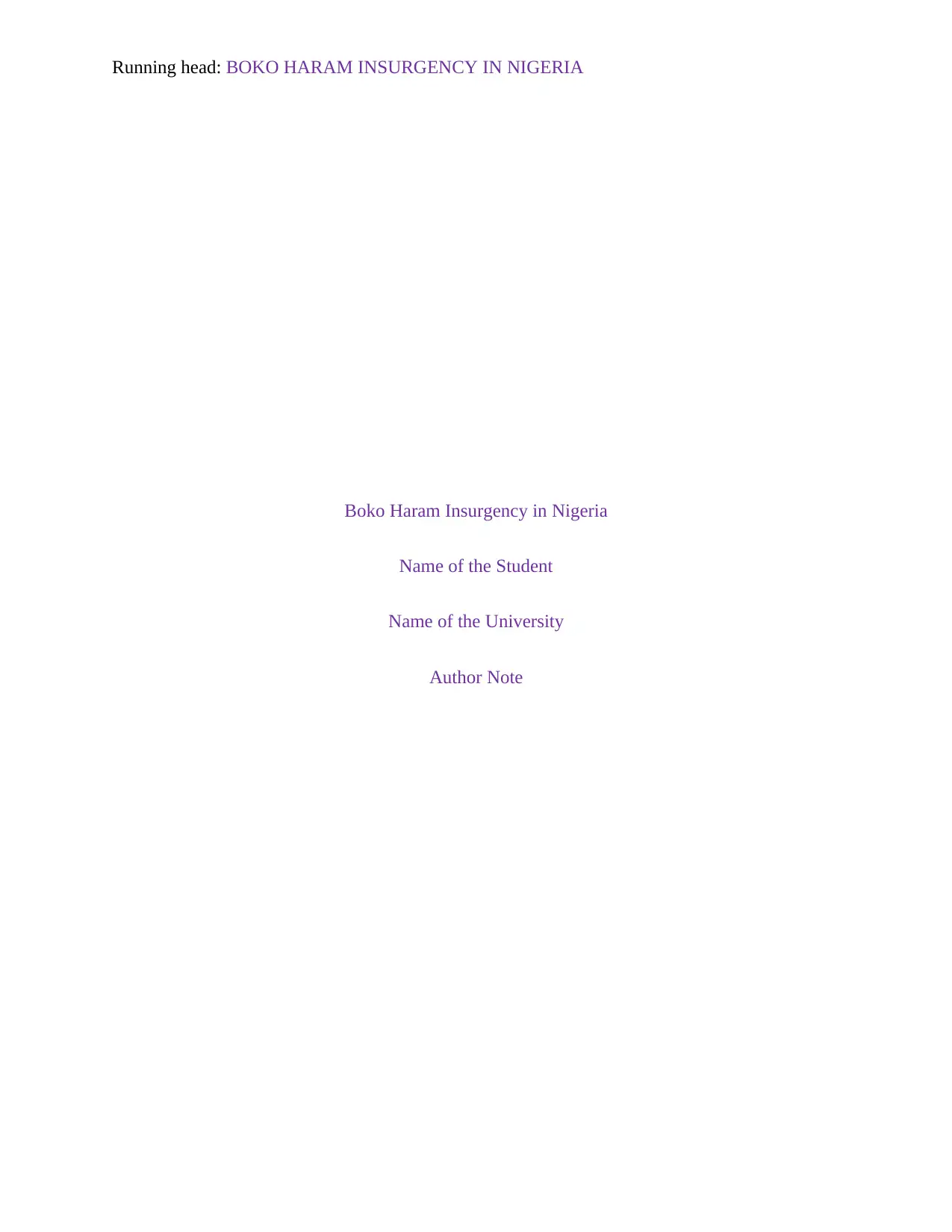
Running head: BOKO HARAM INSURGENCY IN NIGERIA
Boko Haram Insurgency in Nigeria
Name of the Student
Name of the University
Author Note
Boko Haram Insurgency in Nigeria
Name of the Student
Name of the University
Author Note
Secure Best Marks with AI Grader
Need help grading? Try our AI Grader for instant feedback on your assignments.
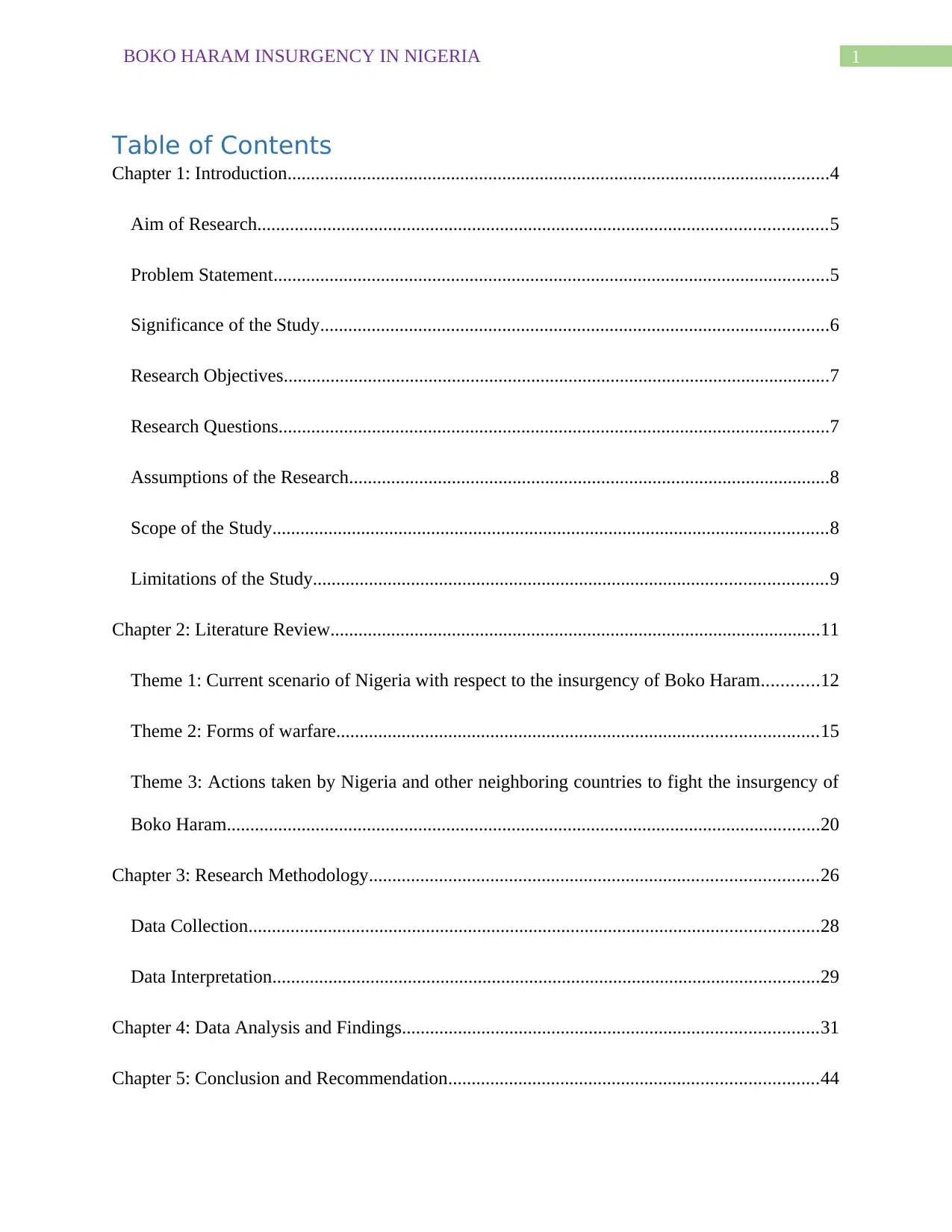
1BOKO HARAM INSURGENCY IN NIGERIA
Table of Contents
Chapter 1: Introduction....................................................................................................................4
Aim of Research..........................................................................................................................5
Problem Statement.......................................................................................................................5
Significance of the Study.............................................................................................................6
Research Objectives.....................................................................................................................7
Research Questions......................................................................................................................7
Assumptions of the Research.......................................................................................................8
Scope of the Study.......................................................................................................................8
Limitations of the Study..............................................................................................................9
Chapter 2: Literature Review.........................................................................................................11
Theme 1: Current scenario of Nigeria with respect to the insurgency of Boko Haram............12
Theme 2: Forms of warfare.......................................................................................................15
Theme 3: Actions taken by Nigeria and other neighboring countries to fight the insurgency of
Boko Haram...............................................................................................................................20
Chapter 3: Research Methodology................................................................................................26
Data Collection..........................................................................................................................28
Data Interpretation.....................................................................................................................29
Chapter 4: Data Analysis and Findings.........................................................................................31
Chapter 5: Conclusion and Recommendation...............................................................................44
Table of Contents
Chapter 1: Introduction....................................................................................................................4
Aim of Research..........................................................................................................................5
Problem Statement.......................................................................................................................5
Significance of the Study.............................................................................................................6
Research Objectives.....................................................................................................................7
Research Questions......................................................................................................................7
Assumptions of the Research.......................................................................................................8
Scope of the Study.......................................................................................................................8
Limitations of the Study..............................................................................................................9
Chapter 2: Literature Review.........................................................................................................11
Theme 1: Current scenario of Nigeria with respect to the insurgency of Boko Haram............12
Theme 2: Forms of warfare.......................................................................................................15
Theme 3: Actions taken by Nigeria and other neighboring countries to fight the insurgency of
Boko Haram...............................................................................................................................20
Chapter 3: Research Methodology................................................................................................26
Data Collection..........................................................................................................................28
Data Interpretation.....................................................................................................................29
Chapter 4: Data Analysis and Findings.........................................................................................31
Chapter 5: Conclusion and Recommendation...............................................................................44
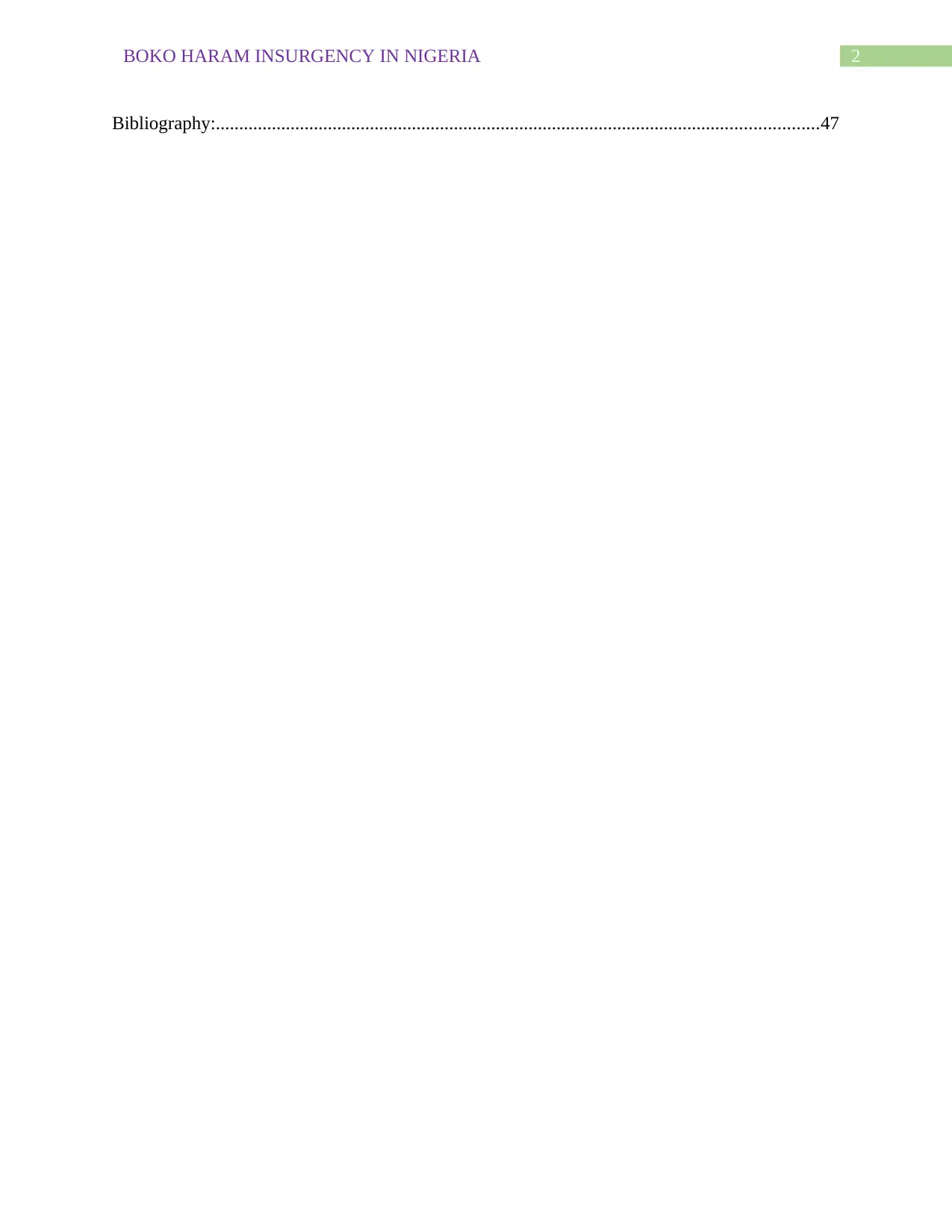
2BOKO HARAM INSURGENCY IN NIGERIA
Bibliography:.................................................................................................................................47
Bibliography:.................................................................................................................................47

3BOKO HARAM INSURGENCY IN NIGERIA
Chapter 1: Introduction
The name of the group ‘Boko Haram’ means ‘no western education, but only Islamic
teachings’. The group actively opposed western influence on education and civilization of the
people in the northern part of Nigeria, especially in the northeast. The group intends to establish
sharia law in order to instill their belief and will on the people. In order for the group’s presence
to be recognized by the people and Government of Nigeria, they resorted to sporadic attacks and
violence to create fear in the hearts of the people. The ultimate goal of Boko Haram is to
establish a caliphate within the northern regions of Nigeria. The Boko Haram group changed its
name to Islamic State West Africa Province after Abubakr Shekau pledged allegiance to Islamic
State ‘Caliph' Abu Bakr al-Baghdadi. In August 2016, Shekau left West Africa Province and
returned to leading Boko Haram in its second iteration. In order to define and understand the
religious philosophy of Jihadi-Salasm and the ideology of Boko Haram, the concept and nature
of jihadi-sala ideology are discussed in the study.
The nature of the problem is the alarmingly increasing rate of religious extremist and
radicalism in the northern part of Nigeria.1 The religious extremist and radicalism is the root
cause of establishing the Boko Haram group. This group recruits innocent young children and
adults from the regions they operate to assist with or commit evil under the pretense of religion.
The terrorist group recruits their followers from age eight or younger, teach their followers the
evil doctrine and also assign them specific tasks which are highly undesirable in nature. This
terrorist organization brought its ideology to existence taking advantage of the poverty-stricken
state by using defenseless, criminals, and innocent’ people to accomplish their goals. It is
regrettable that Government of Nigeria and notable citizens of Nigeria have allowed these
1 ("Boko Haram At A Glance" 2019)
Chapter 1: Introduction
The name of the group ‘Boko Haram’ means ‘no western education, but only Islamic
teachings’. The group actively opposed western influence on education and civilization of the
people in the northern part of Nigeria, especially in the northeast. The group intends to establish
sharia law in order to instill their belief and will on the people. In order for the group’s presence
to be recognized by the people and Government of Nigeria, they resorted to sporadic attacks and
violence to create fear in the hearts of the people. The ultimate goal of Boko Haram is to
establish a caliphate within the northern regions of Nigeria. The Boko Haram group changed its
name to Islamic State West Africa Province after Abubakr Shekau pledged allegiance to Islamic
State ‘Caliph' Abu Bakr al-Baghdadi. In August 2016, Shekau left West Africa Province and
returned to leading Boko Haram in its second iteration. In order to define and understand the
religious philosophy of Jihadi-Salasm and the ideology of Boko Haram, the concept and nature
of jihadi-sala ideology are discussed in the study.
The nature of the problem is the alarmingly increasing rate of religious extremist and
radicalism in the northern part of Nigeria.1 The religious extremist and radicalism is the root
cause of establishing the Boko Haram group. This group recruits innocent young children and
adults from the regions they operate to assist with or commit evil under the pretense of religion.
The terrorist group recruits their followers from age eight or younger, teach their followers the
evil doctrine and also assign them specific tasks which are highly undesirable in nature. This
terrorist organization brought its ideology to existence taking advantage of the poverty-stricken
state by using defenseless, criminals, and innocent’ people to accomplish their goals. It is
regrettable that Government of Nigeria and notable citizens of Nigeria have allowed these
1 ("Boko Haram At A Glance" 2019)
Secure Best Marks with AI Grader
Need help grading? Try our AI Grader for instant feedback on your assignments.
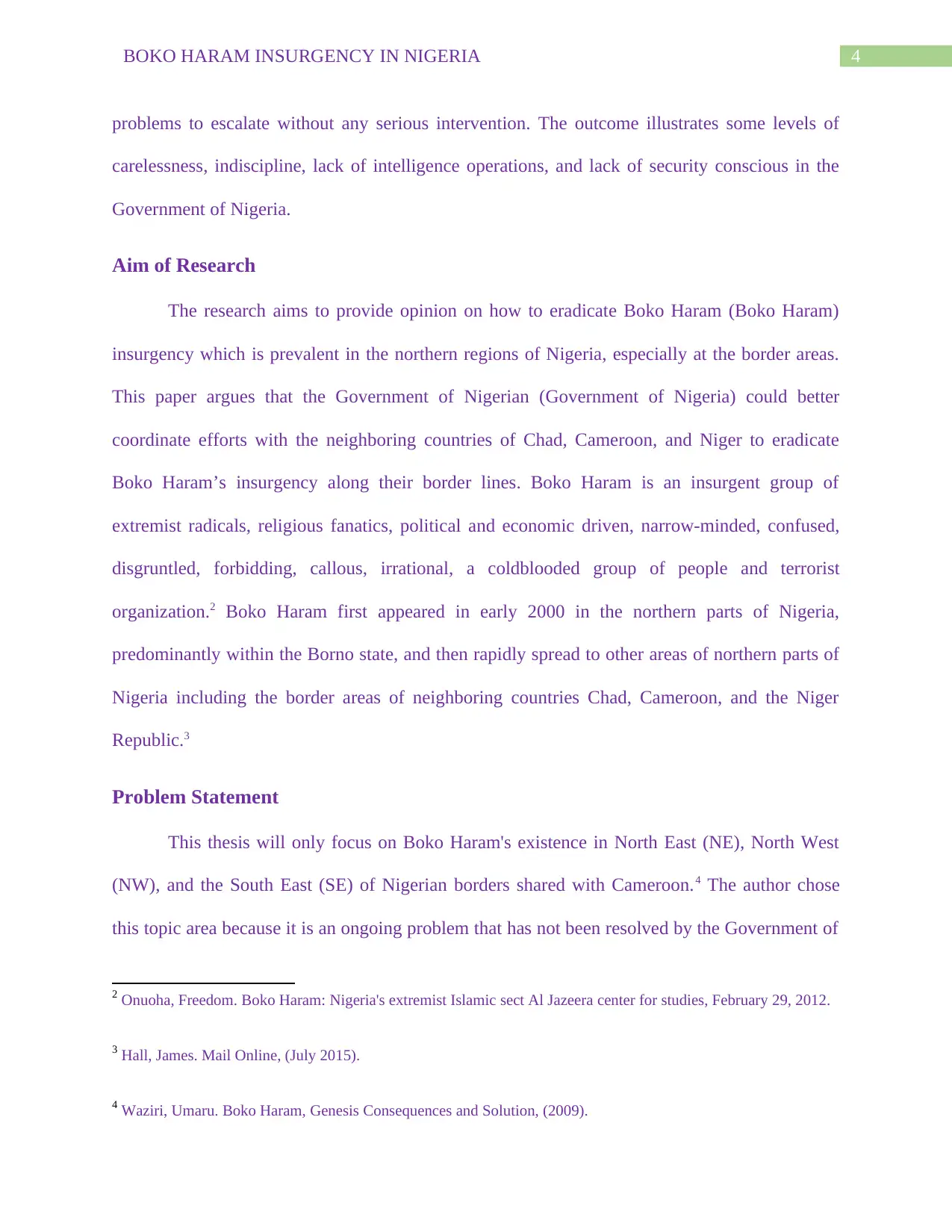
4BOKO HARAM INSURGENCY IN NIGERIA
problems to escalate without any serious intervention. The outcome illustrates some levels of
carelessness, indiscipline, lack of intelligence operations, and lack of security conscious in the
Government of Nigeria.
Aim of Research
The research aims to provide opinion on how to eradicate Boko Haram (Boko Haram)
insurgency which is prevalent in the northern regions of Nigeria, especially at the border areas.
This paper argues that the Government of Nigerian (Government of Nigeria) could better
coordinate efforts with the neighboring countries of Chad, Cameroon, and Niger to eradicate
Boko Haram’s insurgency along their border lines. Boko Haram is an insurgent group of
extremist radicals, religious fanatics, political and economic driven, narrow-minded, confused,
disgruntled, forbidding, callous, irrational, a coldblooded group of people and terrorist
organization.2 Boko Haram first appeared in early 2000 in the northern parts of Nigeria,
predominantly within the Borno state, and then rapidly spread to other areas of northern parts of
Nigeria including the border areas of neighboring countries Chad, Cameroon, and the Niger
Republic.3
Problem Statement
This thesis will only focus on Boko Haram's existence in North East (NE), North West
(NW), and the South East (SE) of Nigerian borders shared with Cameroon.4 The author chose
this topic area because it is an ongoing problem that has not been resolved by the Government of
2 Onuoha, Freedom. Boko Haram: Nigeria's extremist Islamic sect Al Jazeera center for studies, February 29, 2012.
3 Hall, James. Mail Online, (July 2015).
4 Waziri, Umaru. Boko Haram, Genesis Consequences and Solution, (2009).
problems to escalate without any serious intervention. The outcome illustrates some levels of
carelessness, indiscipline, lack of intelligence operations, and lack of security conscious in the
Government of Nigeria.
Aim of Research
The research aims to provide opinion on how to eradicate Boko Haram (Boko Haram)
insurgency which is prevalent in the northern regions of Nigeria, especially at the border areas.
This paper argues that the Government of Nigerian (Government of Nigeria) could better
coordinate efforts with the neighboring countries of Chad, Cameroon, and Niger to eradicate
Boko Haram’s insurgency along their border lines. Boko Haram is an insurgent group of
extremist radicals, religious fanatics, political and economic driven, narrow-minded, confused,
disgruntled, forbidding, callous, irrational, a coldblooded group of people and terrorist
organization.2 Boko Haram first appeared in early 2000 in the northern parts of Nigeria,
predominantly within the Borno state, and then rapidly spread to other areas of northern parts of
Nigeria including the border areas of neighboring countries Chad, Cameroon, and the Niger
Republic.3
Problem Statement
This thesis will only focus on Boko Haram's existence in North East (NE), North West
(NW), and the South East (SE) of Nigerian borders shared with Cameroon.4 The author chose
this topic area because it is an ongoing problem that has not been resolved by the Government of
2 Onuoha, Freedom. Boko Haram: Nigeria's extremist Islamic sect Al Jazeera center for studies, February 29, 2012.
3 Hall, James. Mail Online, (July 2015).
4 Waziri, Umaru. Boko Haram, Genesis Consequences and Solution, (2009).
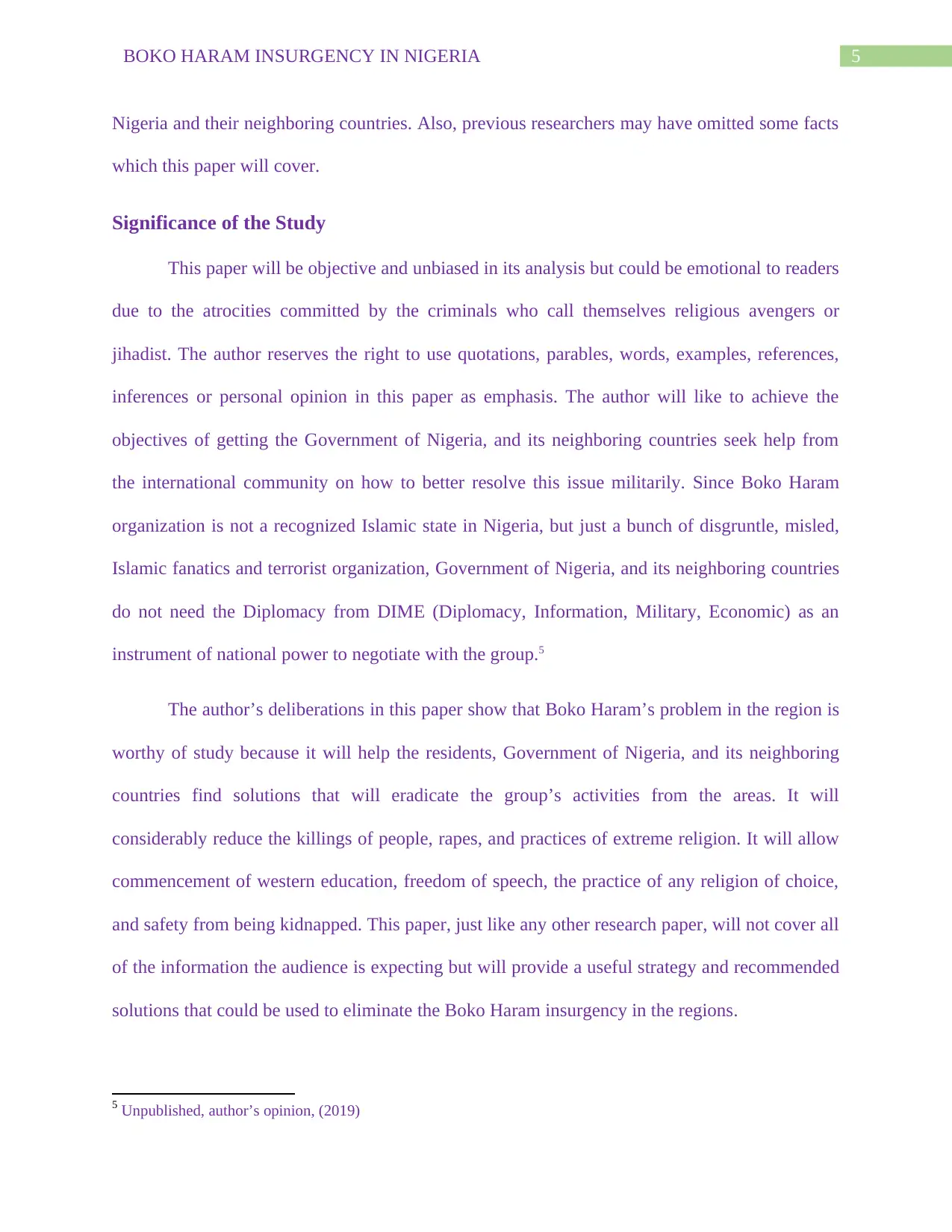
5BOKO HARAM INSURGENCY IN NIGERIA
Nigeria and their neighboring countries. Also, previous researchers may have omitted some facts
which this paper will cover.
Significance of the Study
This paper will be objective and unbiased in its analysis but could be emotional to readers
due to the atrocities committed by the criminals who call themselves religious avengers or
jihadist. The author reserves the right to use quotations, parables, words, examples, references,
inferences or personal opinion in this paper as emphasis. The author will like to achieve the
objectives of getting the Government of Nigeria, and its neighboring countries seek help from
the international community on how to better resolve this issue militarily. Since Boko Haram
organization is not a recognized Islamic state in Nigeria, but just a bunch of disgruntle, misled,
Islamic fanatics and terrorist organization, Government of Nigeria, and its neighboring countries
do not need the Diplomacy from DIME (Diplomacy, Information, Military, Economic) as an
instrument of national power to negotiate with the group.5
The author’s deliberations in this paper show that Boko Haram’s problem in the region is
worthy of study because it will help the residents, Government of Nigeria, and its neighboring
countries find solutions that will eradicate the group’s activities from the areas. It will
considerably reduce the killings of people, rapes, and practices of extreme religion. It will allow
commencement of western education, freedom of speech, the practice of any religion of choice,
and safety from being kidnapped. This paper, just like any other research paper, will not cover all
of the information the audience is expecting but will provide a useful strategy and recommended
solutions that could be used to eliminate the Boko Haram insurgency in the regions.
5 Unpublished, author’s opinion, (2019)
Nigeria and their neighboring countries. Also, previous researchers may have omitted some facts
which this paper will cover.
Significance of the Study
This paper will be objective and unbiased in its analysis but could be emotional to readers
due to the atrocities committed by the criminals who call themselves religious avengers or
jihadist. The author reserves the right to use quotations, parables, words, examples, references,
inferences or personal opinion in this paper as emphasis. The author will like to achieve the
objectives of getting the Government of Nigeria, and its neighboring countries seek help from
the international community on how to better resolve this issue militarily. Since Boko Haram
organization is not a recognized Islamic state in Nigeria, but just a bunch of disgruntle, misled,
Islamic fanatics and terrorist organization, Government of Nigeria, and its neighboring countries
do not need the Diplomacy from DIME (Diplomacy, Information, Military, Economic) as an
instrument of national power to negotiate with the group.5
The author’s deliberations in this paper show that Boko Haram’s problem in the region is
worthy of study because it will help the residents, Government of Nigeria, and its neighboring
countries find solutions that will eradicate the group’s activities from the areas. It will
considerably reduce the killings of people, rapes, and practices of extreme religion. It will allow
commencement of western education, freedom of speech, the practice of any religion of choice,
and safety from being kidnapped. This paper, just like any other research paper, will not cover all
of the information the audience is expecting but will provide a useful strategy and recommended
solutions that could be used to eliminate the Boko Haram insurgency in the regions.
5 Unpublished, author’s opinion, (2019)
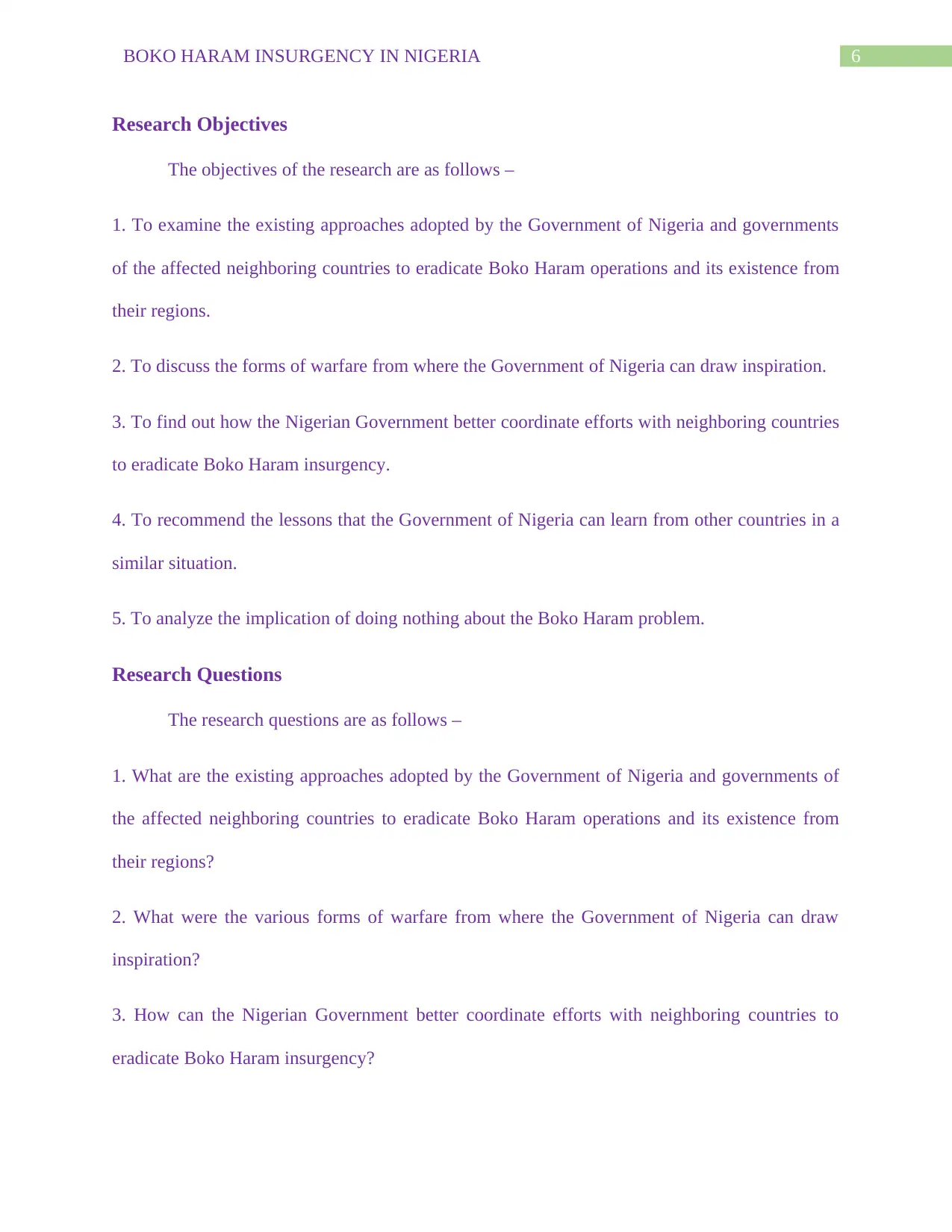
6BOKO HARAM INSURGENCY IN NIGERIA
Research Objectives
The objectives of the research are as follows –
1. To examine the existing approaches adopted by the Government of Nigeria and governments
of the affected neighboring countries to eradicate Boko Haram operations and its existence from
their regions.
2. To discuss the forms of warfare from where the Government of Nigeria can draw inspiration.
3. To find out how the Nigerian Government better coordinate efforts with neighboring countries
to eradicate Boko Haram insurgency.
4. To recommend the lessons that the Government of Nigeria can learn from other countries in a
similar situation.
5. To analyze the implication of doing nothing about the Boko Haram problem.
Research Questions
The research questions are as follows –
1. What are the existing approaches adopted by the Government of Nigeria and governments of
the affected neighboring countries to eradicate Boko Haram operations and its existence from
their regions?
2. What were the various forms of warfare from where the Government of Nigeria can draw
inspiration?
3. How can the Nigerian Government better coordinate efforts with neighboring countries to
eradicate Boko Haram insurgency?
Research Objectives
The objectives of the research are as follows –
1. To examine the existing approaches adopted by the Government of Nigeria and governments
of the affected neighboring countries to eradicate Boko Haram operations and its existence from
their regions.
2. To discuss the forms of warfare from where the Government of Nigeria can draw inspiration.
3. To find out how the Nigerian Government better coordinate efforts with neighboring countries
to eradicate Boko Haram insurgency.
4. To recommend the lessons that the Government of Nigeria can learn from other countries in a
similar situation.
5. To analyze the implication of doing nothing about the Boko Haram problem.
Research Questions
The research questions are as follows –
1. What are the existing approaches adopted by the Government of Nigeria and governments of
the affected neighboring countries to eradicate Boko Haram operations and its existence from
their regions?
2. What were the various forms of warfare from where the Government of Nigeria can draw
inspiration?
3. How can the Nigerian Government better coordinate efforts with neighboring countries to
eradicate Boko Haram insurgency?
Paraphrase This Document
Need a fresh take? Get an instant paraphrase of this document with our AI Paraphraser
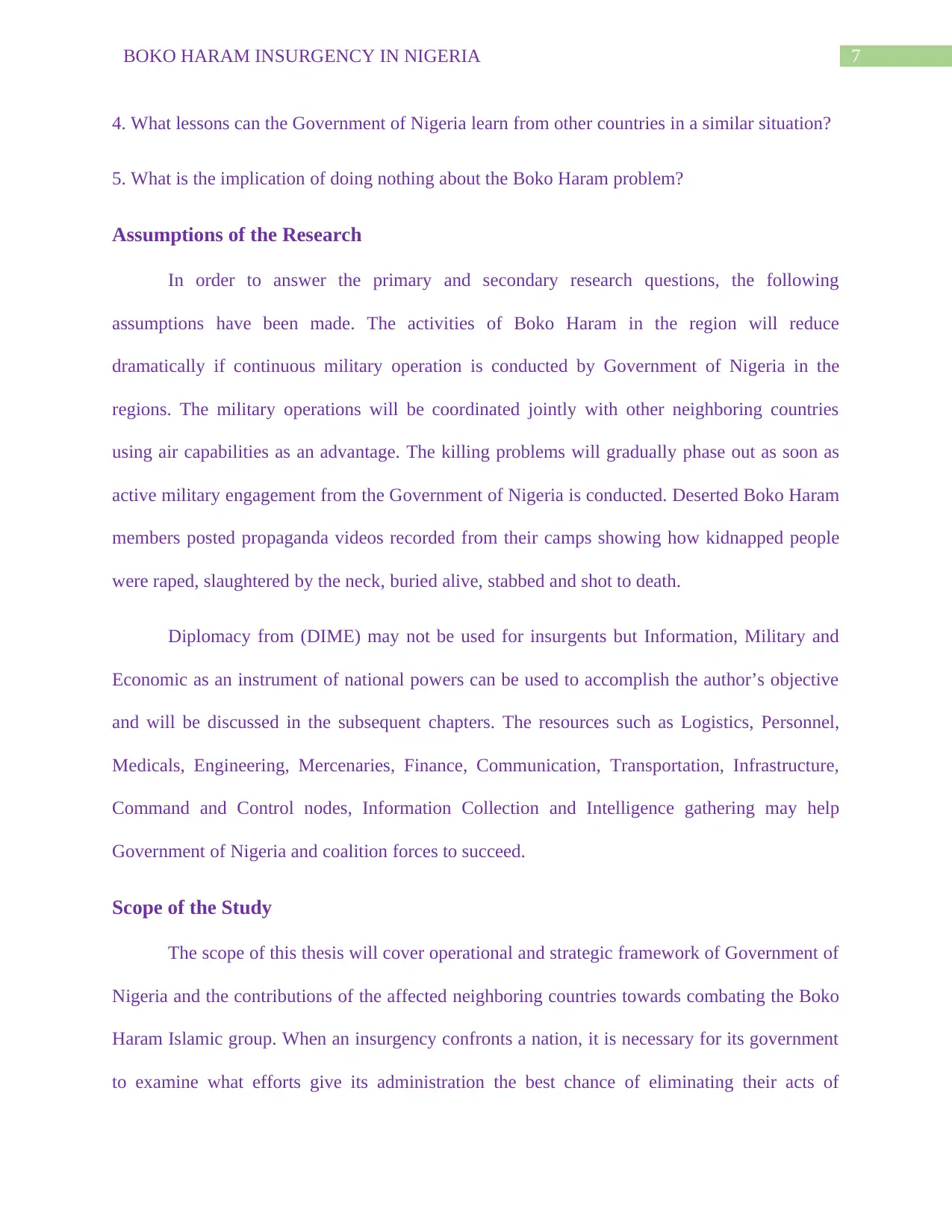
7BOKO HARAM INSURGENCY IN NIGERIA
4. What lessons can the Government of Nigeria learn from other countries in a similar situation?
5. What is the implication of doing nothing about the Boko Haram problem?
Assumptions of the Research
In order to answer the primary and secondary research questions, the following
assumptions have been made. The activities of Boko Haram in the region will reduce
dramatically if continuous military operation is conducted by Government of Nigeria in the
regions. The military operations will be coordinated jointly with other neighboring countries
using air capabilities as an advantage. The killing problems will gradually phase out as soon as
active military engagement from the Government of Nigeria is conducted. Deserted Boko Haram
members posted propaganda videos recorded from their camps showing how kidnapped people
were raped, slaughtered by the neck, buried alive, stabbed and shot to death.
Diplomacy from (DIME) may not be used for insurgents but Information, Military and
Economic as an instrument of national powers can be used to accomplish the author’s objective
and will be discussed in the subsequent chapters. The resources such as Logistics, Personnel,
Medicals, Engineering, Mercenaries, Finance, Communication, Transportation, Infrastructure,
Command and Control nodes, Information Collection and Intelligence gathering may help
Government of Nigeria and coalition forces to succeed.
Scope of the Study
The scope of this thesis will cover operational and strategic framework of Government of
Nigeria and the contributions of the affected neighboring countries towards combating the Boko
Haram Islamic group. When an insurgency confronts a nation, it is necessary for its government
to examine what efforts give its administration the best chance of eliminating their acts of
4. What lessons can the Government of Nigeria learn from other countries in a similar situation?
5. What is the implication of doing nothing about the Boko Haram problem?
Assumptions of the Research
In order to answer the primary and secondary research questions, the following
assumptions have been made. The activities of Boko Haram in the region will reduce
dramatically if continuous military operation is conducted by Government of Nigeria in the
regions. The military operations will be coordinated jointly with other neighboring countries
using air capabilities as an advantage. The killing problems will gradually phase out as soon as
active military engagement from the Government of Nigeria is conducted. Deserted Boko Haram
members posted propaganda videos recorded from their camps showing how kidnapped people
were raped, slaughtered by the neck, buried alive, stabbed and shot to death.
Diplomacy from (DIME) may not be used for insurgents but Information, Military and
Economic as an instrument of national powers can be used to accomplish the author’s objective
and will be discussed in the subsequent chapters. The resources such as Logistics, Personnel,
Medicals, Engineering, Mercenaries, Finance, Communication, Transportation, Infrastructure,
Command and Control nodes, Information Collection and Intelligence gathering may help
Government of Nigeria and coalition forces to succeed.
Scope of the Study
The scope of this thesis will cover operational and strategic framework of Government of
Nigeria and the contributions of the affected neighboring countries towards combating the Boko
Haram Islamic group. When an insurgency confronts a nation, it is necessary for its government
to examine what efforts give its administration the best chance of eliminating their acts of
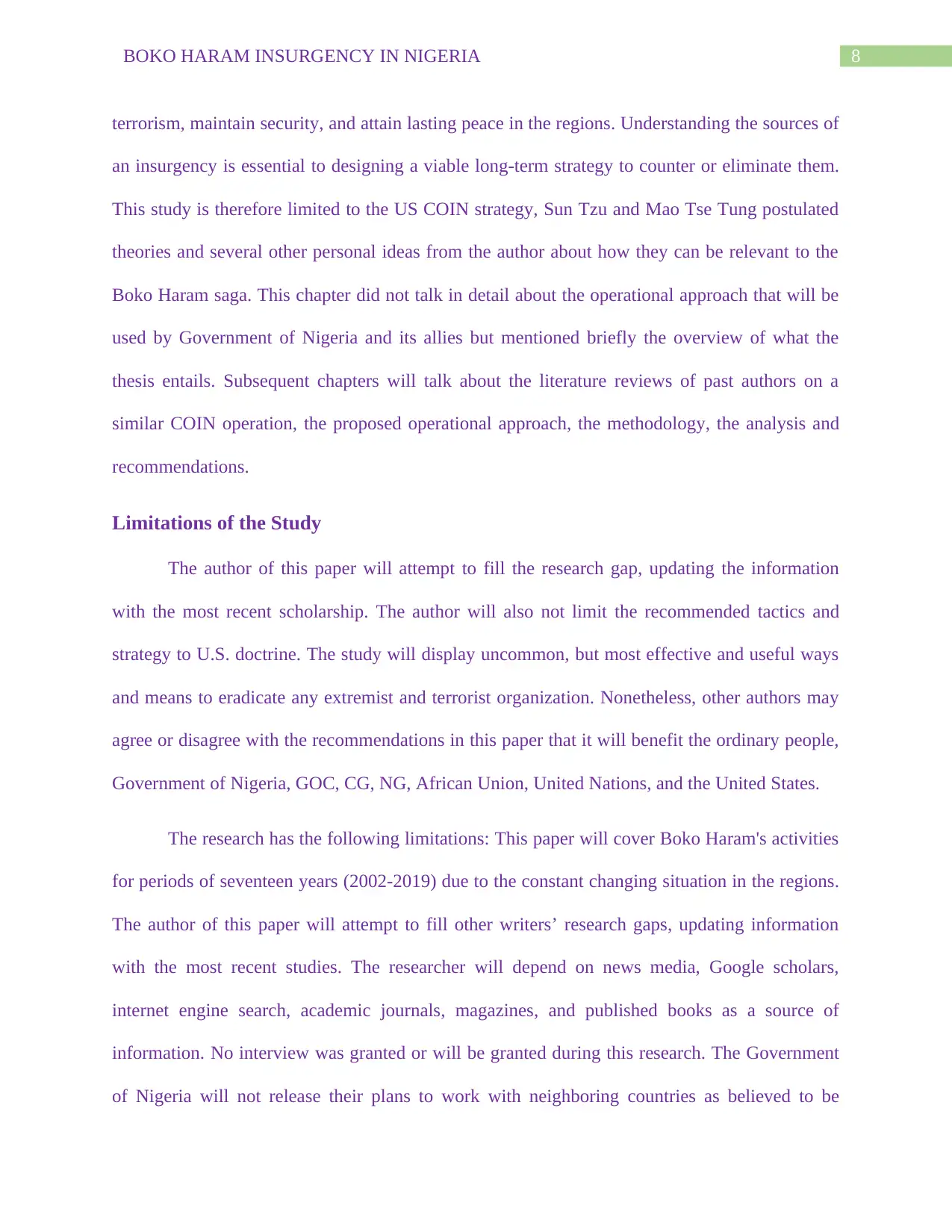
8BOKO HARAM INSURGENCY IN NIGERIA
terrorism, maintain security, and attain lasting peace in the regions. Understanding the sources of
an insurgency is essential to designing a viable long-term strategy to counter or eliminate them.
This study is therefore limited to the US COIN strategy, Sun Tzu and Mao Tse Tung postulated
theories and several other personal ideas from the author about how they can be relevant to the
Boko Haram saga. This chapter did not talk in detail about the operational approach that will be
used by Government of Nigeria and its allies but mentioned briefly the overview of what the
thesis entails. Subsequent chapters will talk about the literature reviews of past authors on a
similar COIN operation, the proposed operational approach, the methodology, the analysis and
recommendations.
Limitations of the Study
The author of this paper will attempt to fill the research gap, updating the information
with the most recent scholarship. The author will also not limit the recommended tactics and
strategy to U.S. doctrine. The study will display uncommon, but most effective and useful ways
and means to eradicate any extremist and terrorist organization. Nonetheless, other authors may
agree or disagree with the recommendations in this paper that it will benefit the ordinary people,
Government of Nigeria, GOC, CG, NG, African Union, United Nations, and the United States.
The research has the following limitations: This paper will cover Boko Haram's activities
for periods of seventeen years (2002-2019) due to the constant changing situation in the regions.
The author of this paper will attempt to fill other writers’ research gaps, updating information
with the most recent studies. The researcher will depend on news media, Google scholars,
internet engine search, academic journals, magazines, and published books as a source of
information. No interview was granted or will be granted during this research. The Government
of Nigeria will not release their plans to work with neighboring countries as believed to be
terrorism, maintain security, and attain lasting peace in the regions. Understanding the sources of
an insurgency is essential to designing a viable long-term strategy to counter or eliminate them.
This study is therefore limited to the US COIN strategy, Sun Tzu and Mao Tse Tung postulated
theories and several other personal ideas from the author about how they can be relevant to the
Boko Haram saga. This chapter did not talk in detail about the operational approach that will be
used by Government of Nigeria and its allies but mentioned briefly the overview of what the
thesis entails. Subsequent chapters will talk about the literature reviews of past authors on a
similar COIN operation, the proposed operational approach, the methodology, the analysis and
recommendations.
Limitations of the Study
The author of this paper will attempt to fill the research gap, updating the information
with the most recent scholarship. The author will also not limit the recommended tactics and
strategy to U.S. doctrine. The study will display uncommon, but most effective and useful ways
and means to eradicate any extremist and terrorist organization. Nonetheless, other authors may
agree or disagree with the recommendations in this paper that it will benefit the ordinary people,
Government of Nigeria, GOC, CG, NG, African Union, United Nations, and the United States.
The research has the following limitations: This paper will cover Boko Haram's activities
for periods of seventeen years (2002-2019) due to the constant changing situation in the regions.
The author of this paper will attempt to fill other writers’ research gaps, updating information
with the most recent studies. The researcher will depend on news media, Google scholars,
internet engine search, academic journals, magazines, and published books as a source of
information. No interview was granted or will be granted during this research. The Government
of Nigeria will not release their plans to work with neighboring countries as believed to be
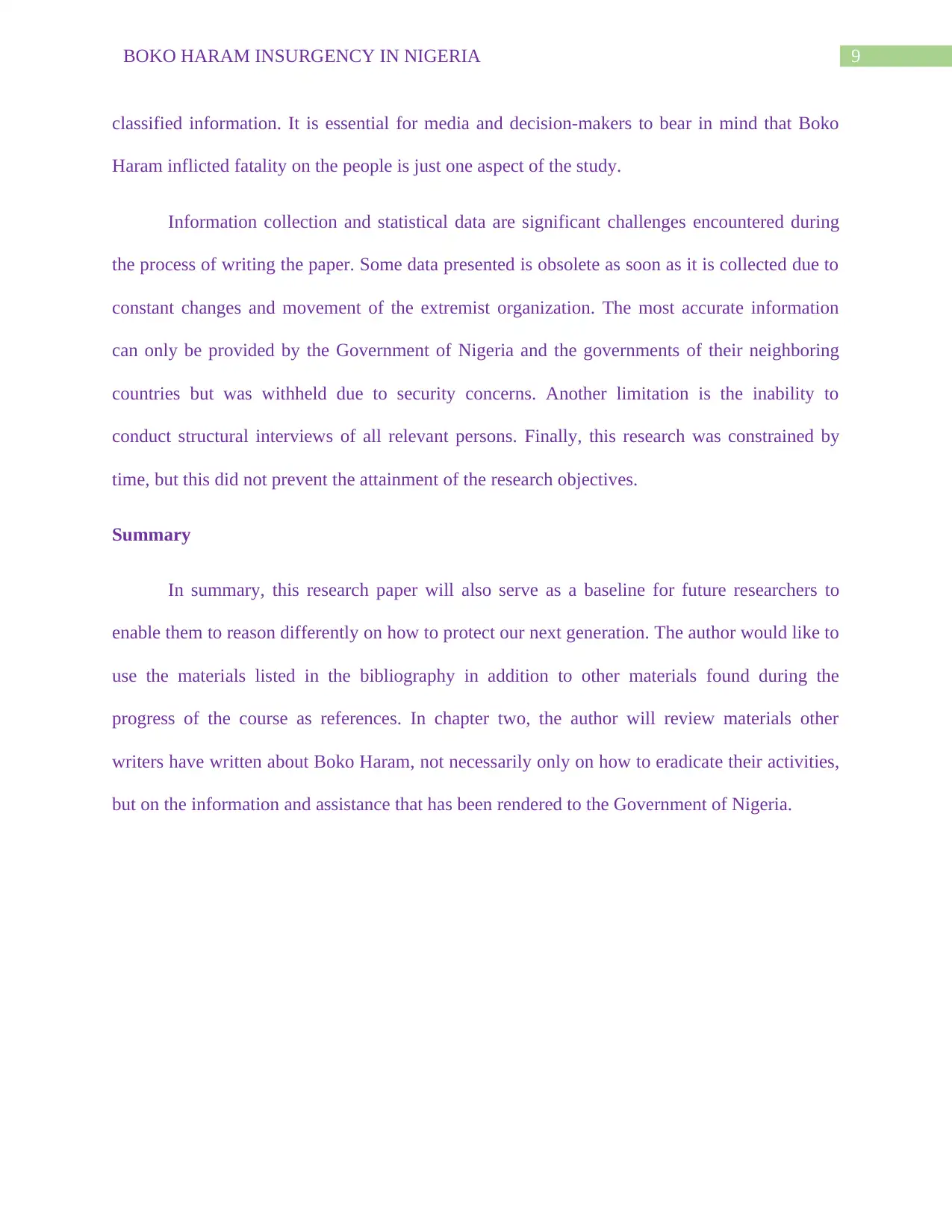
9BOKO HARAM INSURGENCY IN NIGERIA
classified information. It is essential for media and decision-makers to bear in mind that Boko
Haram inflicted fatality on the people is just one aspect of the study.
Information collection and statistical data are significant challenges encountered during
the process of writing the paper. Some data presented is obsolete as soon as it is collected due to
constant changes and movement of the extremist organization. The most accurate information
can only be provided by the Government of Nigeria and the governments of their neighboring
countries but was withheld due to security concerns. Another limitation is the inability to
conduct structural interviews of all relevant persons. Finally, this research was constrained by
time, but this did not prevent the attainment of the research objectives.
Summary
In summary, this research paper will also serve as a baseline for future researchers to
enable them to reason differently on how to protect our next generation. The author would like to
use the materials listed in the bibliography in addition to other materials found during the
progress of the course as references. In chapter two, the author will review materials other
writers have written about Boko Haram, not necessarily only on how to eradicate their activities,
but on the information and assistance that has been rendered to the Government of Nigeria.
classified information. It is essential for media and decision-makers to bear in mind that Boko
Haram inflicted fatality on the people is just one aspect of the study.
Information collection and statistical data are significant challenges encountered during
the process of writing the paper. Some data presented is obsolete as soon as it is collected due to
constant changes and movement of the extremist organization. The most accurate information
can only be provided by the Government of Nigeria and the governments of their neighboring
countries but was withheld due to security concerns. Another limitation is the inability to
conduct structural interviews of all relevant persons. Finally, this research was constrained by
time, but this did not prevent the attainment of the research objectives.
Summary
In summary, this research paper will also serve as a baseline for future researchers to
enable them to reason differently on how to protect our next generation. The author would like to
use the materials listed in the bibliography in addition to other materials found during the
progress of the course as references. In chapter two, the author will review materials other
writers have written about Boko Haram, not necessarily only on how to eradicate their activities,
but on the information and assistance that has been rendered to the Government of Nigeria.
Secure Best Marks with AI Grader
Need help grading? Try our AI Grader for instant feedback on your assignments.
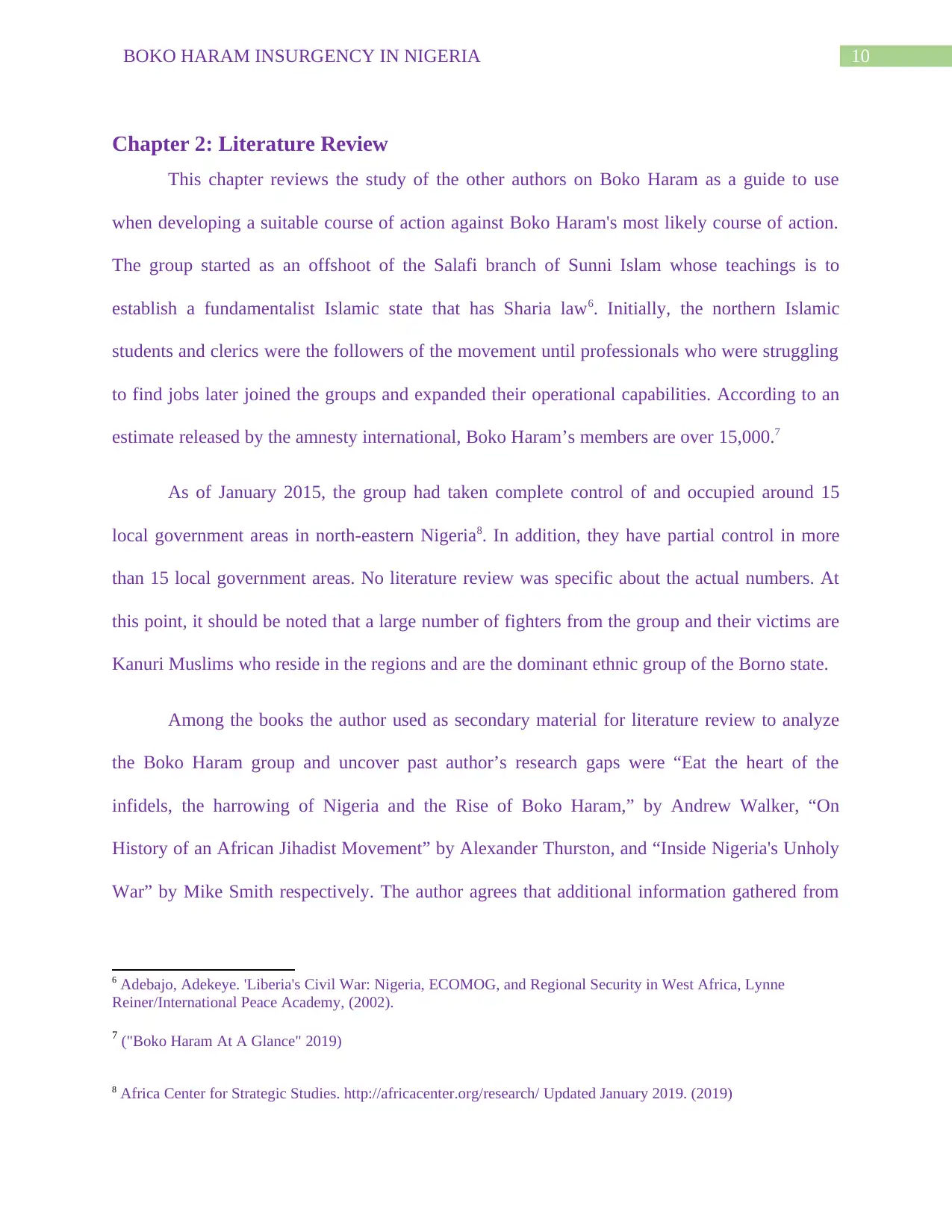
10BOKO HARAM INSURGENCY IN NIGERIA
Chapter 2: Literature Review
This chapter reviews the study of the other authors on Boko Haram as a guide to use
when developing a suitable course of action against Boko Haram's most likely course of action.
The group started as an offshoot of the Salafi branch of Sunni Islam whose teachings is to
establish a fundamentalist Islamic state that has Sharia law6. Initially, the northern Islamic
students and clerics were the followers of the movement until professionals who were struggling
to find jobs later joined the groups and expanded their operational capabilities. According to an
estimate released by the amnesty international, Boko Haram’s members are over 15,000.7
As of January 2015, the group had taken complete control of and occupied around 15
local government areas in north-eastern Nigeria8. In addition, they have partial control in more
than 15 local government areas. No literature review was specific about the actual numbers. At
this point, it should be noted that a large number of fighters from the group and their victims are
Kanuri Muslims who reside in the regions and are the dominant ethnic group of the Borno state.
Among the books the author used as secondary material for literature review to analyze
the Boko Haram group and uncover past author’s research gaps were “Eat the heart of the
infidels, the harrowing of Nigeria and the Rise of Boko Haram,” by Andrew Walker, “On
History of an African Jihadist Movement” by Alexander Thurston, and “Inside Nigeria's Unholy
War” by Mike Smith respectively. The author agrees that additional information gathered from
6 Adebajo, Adekeye. 'Liberia's Civil War: Nigeria, ECOMOG, and Regional Security in West Africa, Lynne
Reiner/International Peace Academy, (2002).
7 ("Boko Haram At A Glance" 2019)
8 Africa Center for Strategic Studies. http://africacenter.org/research/ Updated January 2019. (2019)
Chapter 2: Literature Review
This chapter reviews the study of the other authors on Boko Haram as a guide to use
when developing a suitable course of action against Boko Haram's most likely course of action.
The group started as an offshoot of the Salafi branch of Sunni Islam whose teachings is to
establish a fundamentalist Islamic state that has Sharia law6. Initially, the northern Islamic
students and clerics were the followers of the movement until professionals who were struggling
to find jobs later joined the groups and expanded their operational capabilities. According to an
estimate released by the amnesty international, Boko Haram’s members are over 15,000.7
As of January 2015, the group had taken complete control of and occupied around 15
local government areas in north-eastern Nigeria8. In addition, they have partial control in more
than 15 local government areas. No literature review was specific about the actual numbers. At
this point, it should be noted that a large number of fighters from the group and their victims are
Kanuri Muslims who reside in the regions and are the dominant ethnic group of the Borno state.
Among the books the author used as secondary material for literature review to analyze
the Boko Haram group and uncover past author’s research gaps were “Eat the heart of the
infidels, the harrowing of Nigeria and the Rise of Boko Haram,” by Andrew Walker, “On
History of an African Jihadist Movement” by Alexander Thurston, and “Inside Nigeria's Unholy
War” by Mike Smith respectively. The author agrees that additional information gathered from
6 Adebajo, Adekeye. 'Liberia's Civil War: Nigeria, ECOMOG, and Regional Security in West Africa, Lynne
Reiner/International Peace Academy, (2002).
7 ("Boko Haram At A Glance" 2019)
8 Africa Center for Strategic Studies. http://africacenter.org/research/ Updated January 2019. (2019)

11BOKO HARAM INSURGENCY IN NIGERIA
the books mentioned above in conjunction with other materials are suitable, feasible, and
acceptable guides to eradicate these problems.
The chapter on literature review shall be observed on the basis of the following themes –
Theme 1: Current scenario of Nigeria with respect to the insurgency of Boko Haram
It is known that Government of Nigeria and neighboring states do not have a standing
protective measure similar to what the United States and members of NATO have, which is the
collective security or defense that states an attack against one allied country is considered an
attack against all allied countries9. The principle of collective defense is enshrined in Article 5 of
the Washington Treaty. NATO invoked Article 5 for the first time in its history after the 9/11
terrorist attacks against the United States. NATO has taken collective defense measures on
several occasions, for instance in response to the situation in Syria and the wake of the Russia-
Ukraine crisis. NATO has standing forces on active duty that contribute to the alliance's
collective defense efforts permanently.10
Government of Nigeria and its neighboring states need to have a written agreement on
collective security of their states which means enemy action against one is an action against all11.
Therefore, effort must be made by Government of Nigeria and its future alliance to check or
defeat the Boko Haram organization in the ensuing conflict. “collective security is a security
arrangement, political, regional, or global, in which each state in the system accepts that the
9 Agbiboa, Daniel, oiling Domestic Terrorism. Boko Haram and State Response, Peace Review: A Journal of Social
Justice, 25:431-438, (2013).
10 Abimbola, J. O., and S. A. Adesote. "Domestic terrorism and Boko Haram insurgency in Nigeria, issues and
trends: A Historical Discourse." Journal of Arts and Contemporary Society 4, no. s 11 (2012): 29.
11 Agbiboa, Daniel, Peace at Daggers Drawn. Boko Haram and the State of Emergency in Nigeria, Studies in
Conflict & Terrorism, 2014, pg. 37:41–67, (2014).
the books mentioned above in conjunction with other materials are suitable, feasible, and
acceptable guides to eradicate these problems.
The chapter on literature review shall be observed on the basis of the following themes –
Theme 1: Current scenario of Nigeria with respect to the insurgency of Boko Haram
It is known that Government of Nigeria and neighboring states do not have a standing
protective measure similar to what the United States and members of NATO have, which is the
collective security or defense that states an attack against one allied country is considered an
attack against all allied countries9. The principle of collective defense is enshrined in Article 5 of
the Washington Treaty. NATO invoked Article 5 for the first time in its history after the 9/11
terrorist attacks against the United States. NATO has taken collective defense measures on
several occasions, for instance in response to the situation in Syria and the wake of the Russia-
Ukraine crisis. NATO has standing forces on active duty that contribute to the alliance's
collective defense efforts permanently.10
Government of Nigeria and its neighboring states need to have a written agreement on
collective security of their states which means enemy action against one is an action against all11.
Therefore, effort must be made by Government of Nigeria and its future alliance to check or
defeat the Boko Haram organization in the ensuing conflict. “collective security is a security
arrangement, political, regional, or global, in which each state in the system accepts that the
9 Agbiboa, Daniel, oiling Domestic Terrorism. Boko Haram and State Response, Peace Review: A Journal of Social
Justice, 25:431-438, (2013).
10 Abimbola, J. O., and S. A. Adesote. "Domestic terrorism and Boko Haram insurgency in Nigeria, issues and
trends: A Historical Discourse." Journal of Arts and Contemporary Society 4, no. s 11 (2012): 29.
11 Agbiboa, Daniel, Peace at Daggers Drawn. Boko Haram and the State of Emergency in Nigeria, Studies in
Conflict & Terrorism, 2014, pg. 37:41–67, (2014).
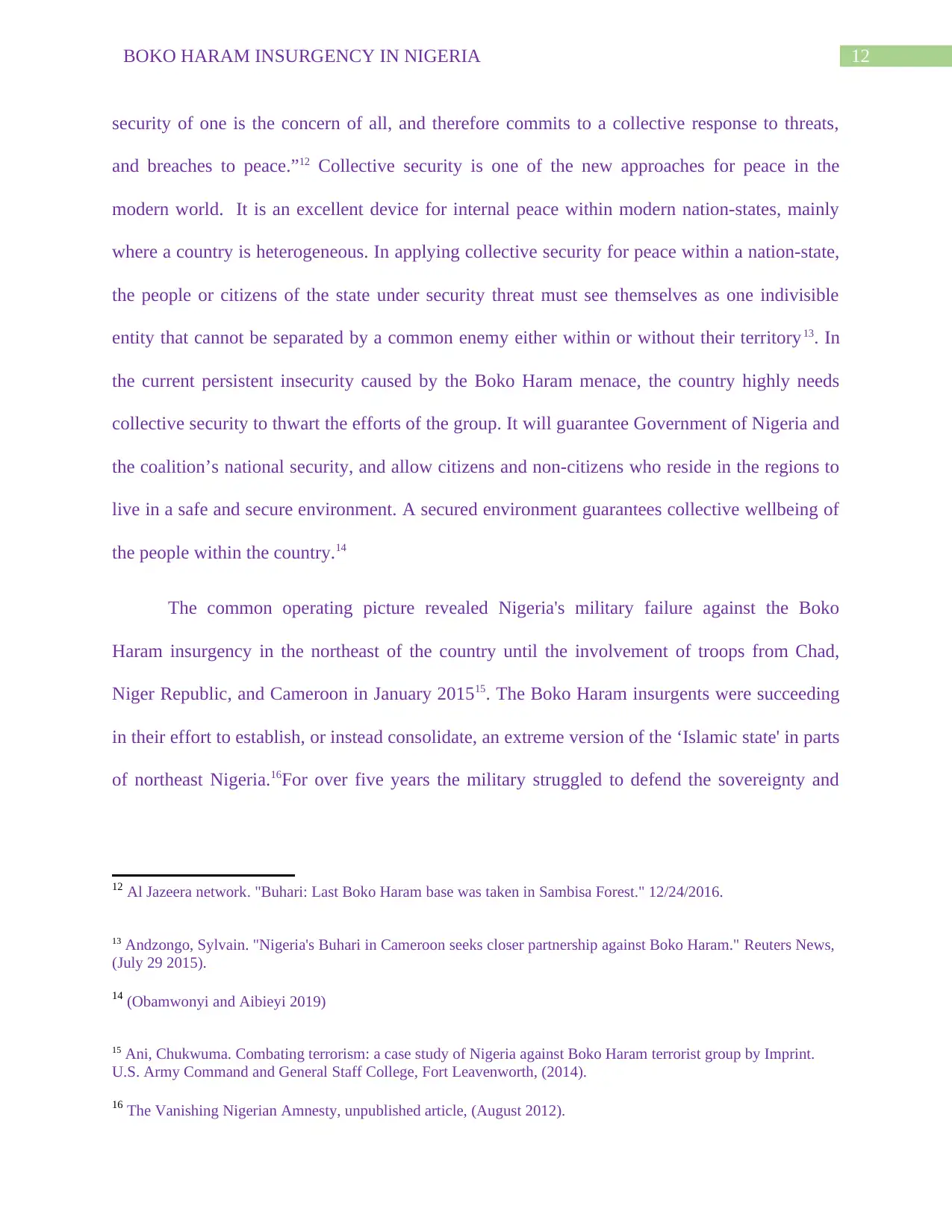
12BOKO HARAM INSURGENCY IN NIGERIA
security of one is the concern of all, and therefore commits to a collective response to threats,
and breaches to peace.”12 Collective security is one of the new approaches for peace in the
modern world. It is an excellent device for internal peace within modern nation-states, mainly
where a country is heterogeneous. In applying collective security for peace within a nation-state,
the people or citizens of the state under security threat must see themselves as one indivisible
entity that cannot be separated by a common enemy either within or without their territory13. In
the current persistent insecurity caused by the Boko Haram menace, the country highly needs
collective security to thwart the efforts of the group. It will guarantee Government of Nigeria and
the coalition’s national security, and allow citizens and non-citizens who reside in the regions to
live in a safe and secure environment. A secured environment guarantees collective wellbeing of
the people within the country.14
The common operating picture revealed Nigeria's military failure against the Boko
Haram insurgency in the northeast of the country until the involvement of troops from Chad,
Niger Republic, and Cameroon in January 201515. The Boko Haram insurgents were succeeding
in their effort to establish, or instead consolidate, an extreme version of the ‘Islamic state' in parts
of northeast Nigeria.16For over five years the military struggled to defend the sovereignty and
12 Al Jazeera network. "Buhari: Last Boko Haram base was taken in Sambisa Forest." 12/24/2016.
13 Andzongo, Sylvain. "Nigeria's Buhari in Cameroon seeks closer partnership against Boko Haram." Reuters News,
(July 29 2015).
14 (Obamwonyi and Aibieyi 2019)
15 Ani, Chukwuma. Combating terrorism: a case study of Nigeria against Boko Haram terrorist group by Imprint.
U.S. Army Command and General Staff College, Fort Leavenworth, (2014).
16 The Vanishing Nigerian Amnesty, unpublished article, (August 2012).
security of one is the concern of all, and therefore commits to a collective response to threats,
and breaches to peace.”12 Collective security is one of the new approaches for peace in the
modern world. It is an excellent device for internal peace within modern nation-states, mainly
where a country is heterogeneous. In applying collective security for peace within a nation-state,
the people or citizens of the state under security threat must see themselves as one indivisible
entity that cannot be separated by a common enemy either within or without their territory13. In
the current persistent insecurity caused by the Boko Haram menace, the country highly needs
collective security to thwart the efforts of the group. It will guarantee Government of Nigeria and
the coalition’s national security, and allow citizens and non-citizens who reside in the regions to
live in a safe and secure environment. A secured environment guarantees collective wellbeing of
the people within the country.14
The common operating picture revealed Nigeria's military failure against the Boko
Haram insurgency in the northeast of the country until the involvement of troops from Chad,
Niger Republic, and Cameroon in January 201515. The Boko Haram insurgents were succeeding
in their effort to establish, or instead consolidate, an extreme version of the ‘Islamic state' in parts
of northeast Nigeria.16For over five years the military struggled to defend the sovereignty and
12 Al Jazeera network. "Buhari: Last Boko Haram base was taken in Sambisa Forest." 12/24/2016.
13 Andzongo, Sylvain. "Nigeria's Buhari in Cameroon seeks closer partnership against Boko Haram." Reuters News,
(July 29 2015).
14 (Obamwonyi and Aibieyi 2019)
15 Ani, Chukwuma. Combating terrorism: a case study of Nigeria against Boko Haram terrorist group by Imprint.
U.S. Army Command and General Staff College, Fort Leavenworth, (2014).
16 The Vanishing Nigerian Amnesty, unpublished article, (August 2012).
Paraphrase This Document
Need a fresh take? Get an instant paraphrase of this document with our AI Paraphraser
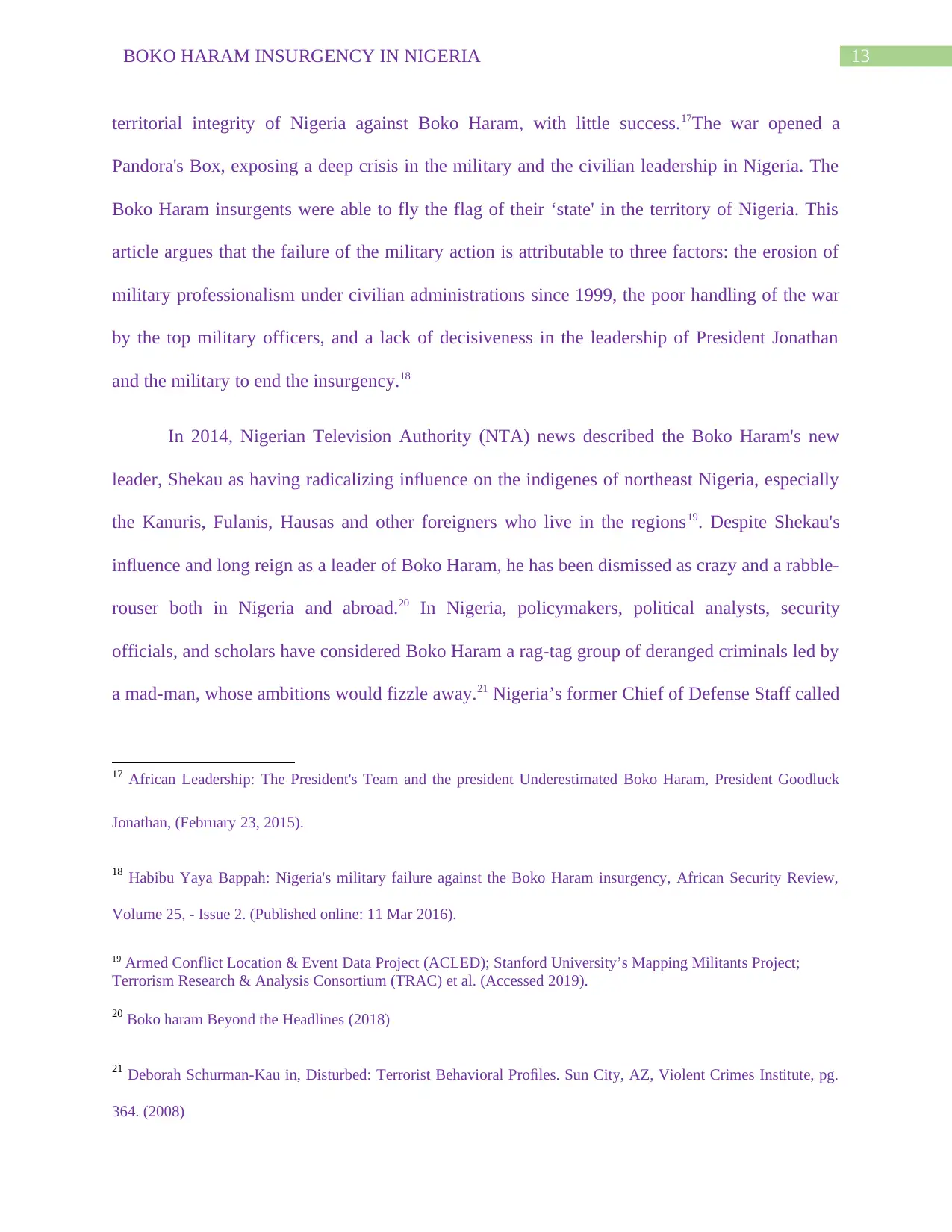
13BOKO HARAM INSURGENCY IN NIGERIA
territorial integrity of Nigeria against Boko Haram, with little success.17The war opened a
Pandora's Box, exposing a deep crisis in the military and the civilian leadership in Nigeria. The
Boko Haram insurgents were able to fly the flag of their ‘state' in the territory of Nigeria. This
article argues that the failure of the military action is attributable to three factors: the erosion of
military professionalism under civilian administrations since 1999, the poor handling of the war
by the top military officers, and a lack of decisiveness in the leadership of President Jonathan
and the military to end the insurgency.18
In 2014, Nigerian Television Authority (NTA) news described the Boko Haram's new
leader, Shekau as having radicalizing influence on the indigenes of northeast Nigeria, especially
the Kanuris, Fulanis, Hausas and other foreigners who live in the regions19. Despite Shekau's
influence and long reign as a leader of Boko Haram, he has been dismissed as crazy and a rabble-
rouser both in Nigeria and abroad.20 In Nigeria, policymakers, political analysts, security
officials, and scholars have considered Boko Haram a rag-tag group of deranged criminals led by
a mad-man, whose ambitions would fizzle away.21 Nigeria’s former Chief of Defense Staff called
17 African Leadership: The President's Team and the president Underestimated Boko Haram, President Goodluck
Jonathan, (February 23, 2015).
18 Habibu Yaya Bappah: Nigeria's military failure against the Boko Haram insurgency, African Security Review,
Volume 25, - Issue 2. (Published online: 11 Mar 2016).
19 Armed Conflict Location & Event Data Project (ACLED); Stanford University’s Mapping Militants Project;
Terrorism Research & Analysis Consortium (TRAC) et al. (Accessed 2019).
20 Boko haram Beyond the Headlines (2018)
21 Deborah Schurman-Kau in, Disturbed: Terrorist Behavioral Profiles. Sun City, AZ, Violent Crimes Institute, pg.
364. (2008)
territorial integrity of Nigeria against Boko Haram, with little success.17The war opened a
Pandora's Box, exposing a deep crisis in the military and the civilian leadership in Nigeria. The
Boko Haram insurgents were able to fly the flag of their ‘state' in the territory of Nigeria. This
article argues that the failure of the military action is attributable to three factors: the erosion of
military professionalism under civilian administrations since 1999, the poor handling of the war
by the top military officers, and a lack of decisiveness in the leadership of President Jonathan
and the military to end the insurgency.18
In 2014, Nigerian Television Authority (NTA) news described the Boko Haram's new
leader, Shekau as having radicalizing influence on the indigenes of northeast Nigeria, especially
the Kanuris, Fulanis, Hausas and other foreigners who live in the regions19. Despite Shekau's
influence and long reign as a leader of Boko Haram, he has been dismissed as crazy and a rabble-
rouser both in Nigeria and abroad.20 In Nigeria, policymakers, political analysts, security
officials, and scholars have considered Boko Haram a rag-tag group of deranged criminals led by
a mad-man, whose ambitions would fizzle away.21 Nigeria’s former Chief of Defense Staff called
17 African Leadership: The President's Team and the president Underestimated Boko Haram, President Goodluck
Jonathan, (February 23, 2015).
18 Habibu Yaya Bappah: Nigeria's military failure against the Boko Haram insurgency, African Security Review,
Volume 25, - Issue 2. (Published online: 11 Mar 2016).
19 Armed Conflict Location & Event Data Project (ACLED); Stanford University’s Mapping Militants Project;
Terrorism Research & Analysis Consortium (TRAC) et al. (Accessed 2019).
20 Boko haram Beyond the Headlines (2018)
21 Deborah Schurman-Kau in, Disturbed: Terrorist Behavioral Profiles. Sun City, AZ, Violent Crimes Institute, pg.
364. (2008)
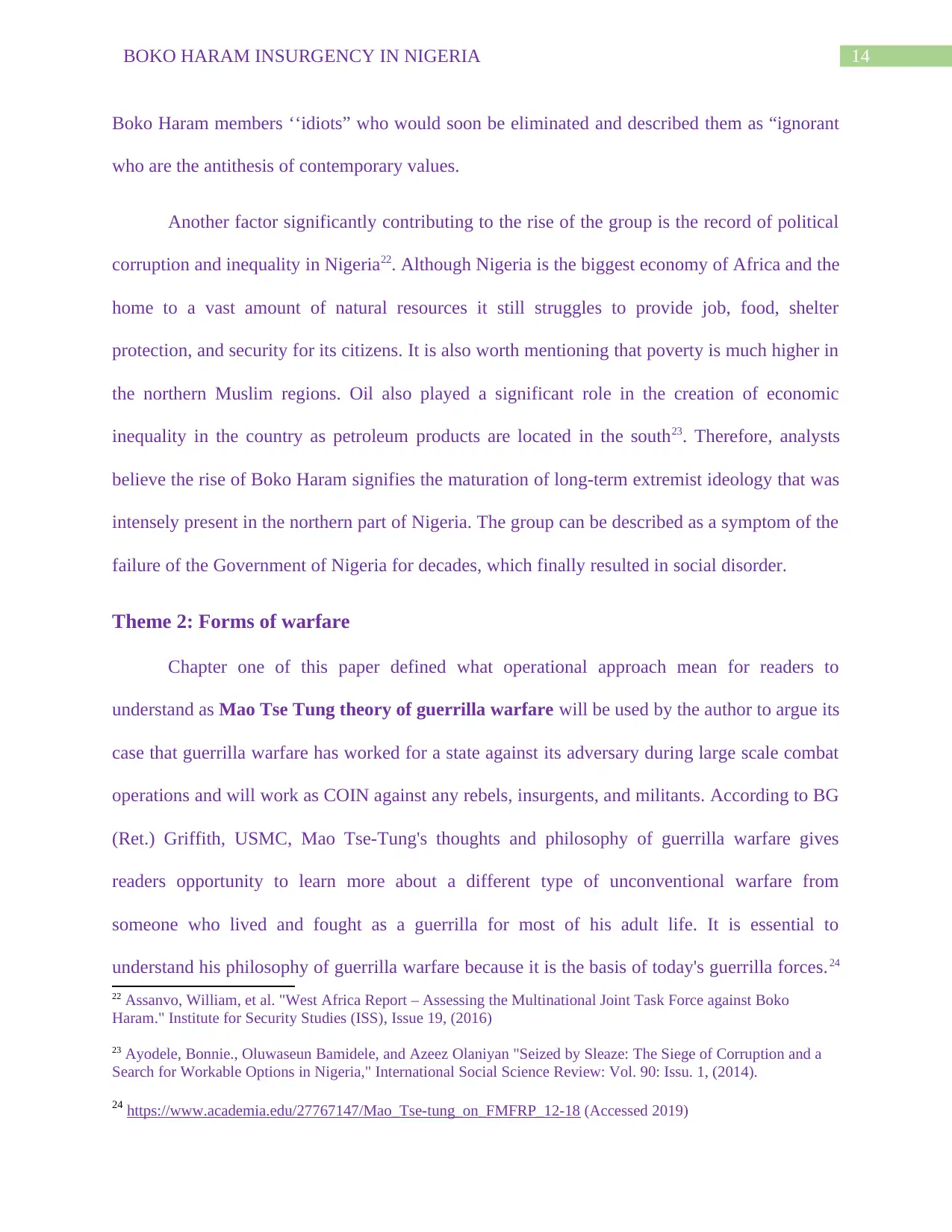
14BOKO HARAM INSURGENCY IN NIGERIA
Boko Haram members ‘‘idiots” who would soon be eliminated and described them as “ignorant
who are the antithesis of contemporary values.
Another factor significantly contributing to the rise of the group is the record of political
corruption and inequality in Nigeria22. Although Nigeria is the biggest economy of Africa and the
home to a vast amount of natural resources it still struggles to provide job, food, shelter
protection, and security for its citizens. It is also worth mentioning that poverty is much higher in
the northern Muslim regions. Oil also played a significant role in the creation of economic
inequality in the country as petroleum products are located in the south23. Therefore, analysts
believe the rise of Boko Haram signifies the maturation of long-term extremist ideology that was
intensely present in the northern part of Nigeria. The group can be described as a symptom of the
failure of the Government of Nigeria for decades, which finally resulted in social disorder.
Theme 2: Forms of warfare
Chapter one of this paper defined what operational approach mean for readers to
understand as Mao Tse Tung theory of guerrilla warfare will be used by the author to argue its
case that guerrilla warfare has worked for a state against its adversary during large scale combat
operations and will work as COIN against any rebels, insurgents, and militants. According to BG
(Ret.) Griffith, USMC, Mao Tse-Tung's thoughts and philosophy of guerrilla warfare gives
readers opportunity to learn more about a different type of unconventional warfare from
someone who lived and fought as a guerrilla for most of his adult life. It is essential to
understand his philosophy of guerrilla warfare because it is the basis of today's guerrilla forces.24
22 Assanvo, William, et al. "West Africa Report – Assessing the Multinational Joint Task Force against Boko
Haram." Institute for Security Studies (ISS), Issue 19, (2016)
23 Ayodele, Bonnie., Oluwaseun Bamidele, and Azeez Olaniyan "Seized by Sleaze: The Siege of Corruption and a
Search for Workable Options in Nigeria," International Social Science Review: Vol. 90: Issu. 1, (2014).
24 https://www.academia.edu/27767147/Mao_Tse-tung_on_FMFRP_12-18 (Accessed 2019)
Boko Haram members ‘‘idiots” who would soon be eliminated and described them as “ignorant
who are the antithesis of contemporary values.
Another factor significantly contributing to the rise of the group is the record of political
corruption and inequality in Nigeria22. Although Nigeria is the biggest economy of Africa and the
home to a vast amount of natural resources it still struggles to provide job, food, shelter
protection, and security for its citizens. It is also worth mentioning that poverty is much higher in
the northern Muslim regions. Oil also played a significant role in the creation of economic
inequality in the country as petroleum products are located in the south23. Therefore, analysts
believe the rise of Boko Haram signifies the maturation of long-term extremist ideology that was
intensely present in the northern part of Nigeria. The group can be described as a symptom of the
failure of the Government of Nigeria for decades, which finally resulted in social disorder.
Theme 2: Forms of warfare
Chapter one of this paper defined what operational approach mean for readers to
understand as Mao Tse Tung theory of guerrilla warfare will be used by the author to argue its
case that guerrilla warfare has worked for a state against its adversary during large scale combat
operations and will work as COIN against any rebels, insurgents, and militants. According to BG
(Ret.) Griffith, USMC, Mao Tse-Tung's thoughts and philosophy of guerrilla warfare gives
readers opportunity to learn more about a different type of unconventional warfare from
someone who lived and fought as a guerrilla for most of his adult life. It is essential to
understand his philosophy of guerrilla warfare because it is the basis of today's guerrilla forces.24
22 Assanvo, William, et al. "West Africa Report – Assessing the Multinational Joint Task Force against Boko
Haram." Institute for Security Studies (ISS), Issue 19, (2016)
23 Ayodele, Bonnie., Oluwaseun Bamidele, and Azeez Olaniyan "Seized by Sleaze: The Siege of Corruption and a
Search for Workable Options in Nigeria," International Social Science Review: Vol. 90: Issu. 1, (2014).
24 https://www.academia.edu/27767147/Mao_Tse-tung_on_FMFRP_12-18 (Accessed 2019)
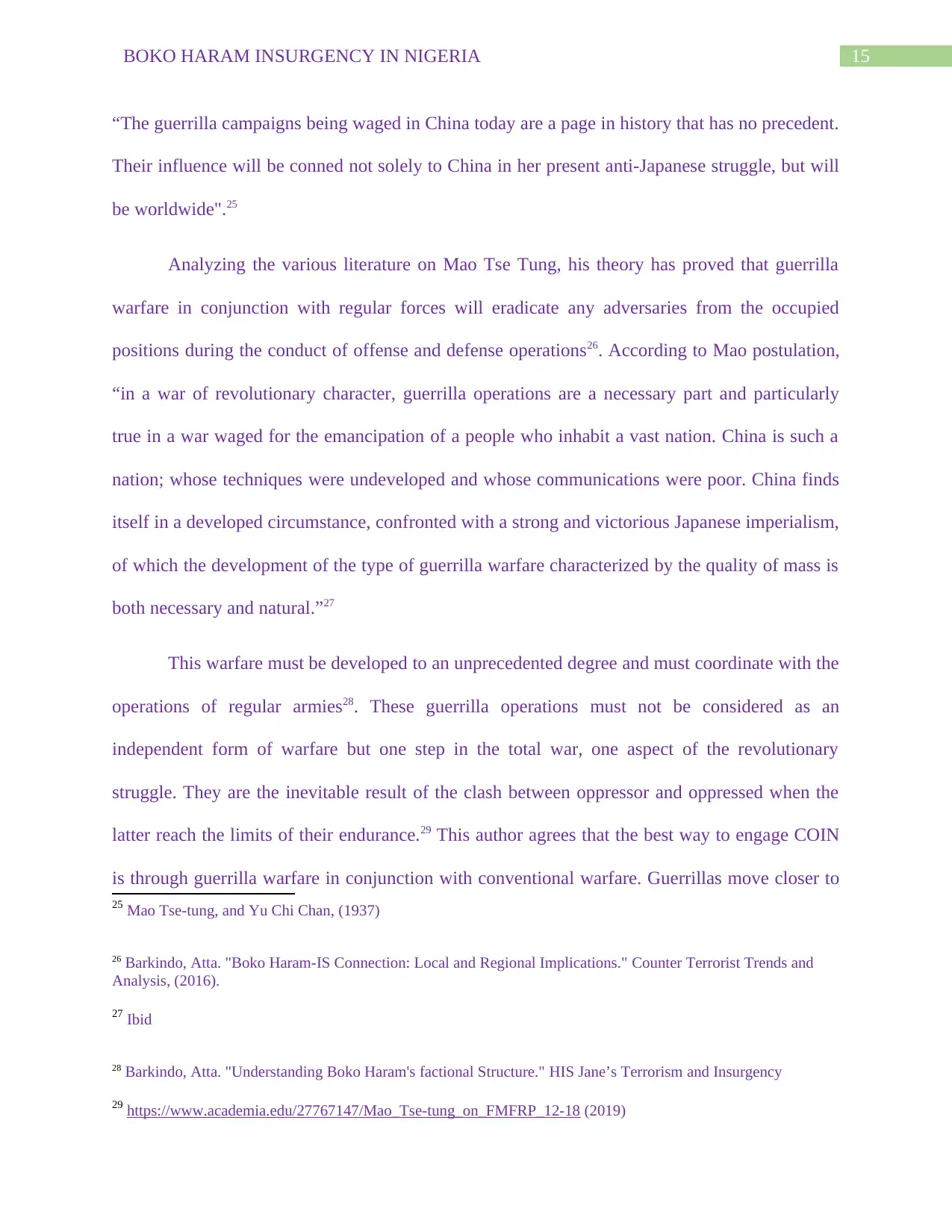
15BOKO HARAM INSURGENCY IN NIGERIA
“The guerrilla campaigns being waged in China today are a page in history that has no precedent.
Their influence will be conned not solely to China in her present anti-Japanese struggle, but will
be worldwide".25
Analyzing the various literature on Mao Tse Tung, his theory has proved that guerrilla
warfare in conjunction with regular forces will eradicate any adversaries from the occupied
positions during the conduct of offense and defense operations26. According to Mao postulation,
“in a war of revolutionary character, guerrilla operations are a necessary part and particularly
true in a war waged for the emancipation of a people who inhabit a vast nation. China is such a
nation; whose techniques were undeveloped and whose communications were poor. China finds
itself in a developed circumstance, confronted with a strong and victorious Japanese imperialism,
of which the development of the type of guerrilla warfare characterized by the quality of mass is
both necessary and natural.”27
This warfare must be developed to an unprecedented degree and must coordinate with the
operations of regular armies28. These guerrilla operations must not be considered as an
independent form of warfare but one step in the total war, one aspect of the revolutionary
struggle. They are the inevitable result of the clash between oppressor and oppressed when the
latter reach the limits of their endurance.29 This author agrees that the best way to engage COIN
is through guerrilla warfare in conjunction with conventional warfare. Guerrillas move closer to
25 Mao Tse-tung, and Yu Chi Chan, (1937)
26 Barkindo, Atta. "Boko Haram-IS Connection: Local and Regional Implications." Counter Terrorist Trends and
Analysis, (2016).
27 Ibid
28 Barkindo, Atta. "Understanding Boko Haram's factional Structure." HIS Jane’s Terrorism and Insurgency
29 https://www.academia.edu/27767147/Mao_Tse-tung_on_FMFRP_12-18 (2019)
“The guerrilla campaigns being waged in China today are a page in history that has no precedent.
Their influence will be conned not solely to China in her present anti-Japanese struggle, but will
be worldwide".25
Analyzing the various literature on Mao Tse Tung, his theory has proved that guerrilla
warfare in conjunction with regular forces will eradicate any adversaries from the occupied
positions during the conduct of offense and defense operations26. According to Mao postulation,
“in a war of revolutionary character, guerrilla operations are a necessary part and particularly
true in a war waged for the emancipation of a people who inhabit a vast nation. China is such a
nation; whose techniques were undeveloped and whose communications were poor. China finds
itself in a developed circumstance, confronted with a strong and victorious Japanese imperialism,
of which the development of the type of guerrilla warfare characterized by the quality of mass is
both necessary and natural.”27
This warfare must be developed to an unprecedented degree and must coordinate with the
operations of regular armies28. These guerrilla operations must not be considered as an
independent form of warfare but one step in the total war, one aspect of the revolutionary
struggle. They are the inevitable result of the clash between oppressor and oppressed when the
latter reach the limits of their endurance.29 This author agrees that the best way to engage COIN
is through guerrilla warfare in conjunction with conventional warfare. Guerrillas move closer to
25 Mao Tse-tung, and Yu Chi Chan, (1937)
26 Barkindo, Atta. "Boko Haram-IS Connection: Local and Regional Implications." Counter Terrorist Trends and
Analysis, (2016).
27 Ibid
28 Barkindo, Atta. "Understanding Boko Haram's factional Structure." HIS Jane’s Terrorism and Insurgency
29 https://www.academia.edu/27767147/Mao_Tse-tung_on_FMFRP_12-18 (2019)
Secure Best Marks with AI Grader
Need help grading? Try our AI Grader for instant feedback on your assignments.

16BOKO HARAM INSURGENCY IN NIGERIA
the fights without being noticed, fights one on one combat better than the conventional army, and
have the support of the locals.30. In this situation, the Boko Haram group is the adversary while
Government of Nigeria and its affected neighboring countries are the friendly forces. The
common objective to eradicate the terrorist group is the end, the how to eradicate this group from
these regions is the way; and the mean is the use of combined armed forces from the
multinational task force created by the Government of Nigeria, GOC, CG, and NG31.
A systematic combat is never confined within the bounds of military action because its
purpose is to destroy an existing society, Government of Nigeria policy and its institutions and to
replace them with entirely new state policy (sharia law). Any conflict is a unity of which the
constituent parts are military, political, economic, social, and psychological. The guerrilla war is
not dependent for success on the efficient operation of sophisticated mechanical devices, highly
organized logistical systems, or the accuracy of electronic computers32. Guerrillas can be conduct
in any terrain (swamps, mountains, and farmlands), climate, or weather. The fundamental
element of guerrilla warfare is the people, who are more complex than any of the machines.
Guerrilla warfare is therefore covered with and reflects man's admirable qualities as well as the
less pleasant ones. While guerrilla warfare is not always sympathetic, they are carried out by
competent people whose purpose is to destroy and displace the adversary from positions of
advantage and make them flee.33
30 Mao Tse - Tung on Guerrilla Warfare (Accessed 2019).
31 BBC Monitoring. “Is Islamic State shaping Boko Haram media?” (04 March 2015).
32 BBC News. "Who is Nigeria's Boko Haram Islamist Group?" (November 24, 2016)
33 Boko Haram beyond the Headlines (2019)
the fights without being noticed, fights one on one combat better than the conventional army, and
have the support of the locals.30. In this situation, the Boko Haram group is the adversary while
Government of Nigeria and its affected neighboring countries are the friendly forces. The
common objective to eradicate the terrorist group is the end, the how to eradicate this group from
these regions is the way; and the mean is the use of combined armed forces from the
multinational task force created by the Government of Nigeria, GOC, CG, and NG31.
A systematic combat is never confined within the bounds of military action because its
purpose is to destroy an existing society, Government of Nigeria policy and its institutions and to
replace them with entirely new state policy (sharia law). Any conflict is a unity of which the
constituent parts are military, political, economic, social, and psychological. The guerrilla war is
not dependent for success on the efficient operation of sophisticated mechanical devices, highly
organized logistical systems, or the accuracy of electronic computers32. Guerrillas can be conduct
in any terrain (swamps, mountains, and farmlands), climate, or weather. The fundamental
element of guerrilla warfare is the people, who are more complex than any of the machines.
Guerrilla warfare is therefore covered with and reflects man's admirable qualities as well as the
less pleasant ones. While guerrilla warfare is not always sympathetic, they are carried out by
competent people whose purpose is to destroy and displace the adversary from positions of
advantage and make them flee.33
30 Mao Tse - Tung on Guerrilla Warfare (Accessed 2019).
31 BBC Monitoring. “Is Islamic State shaping Boko Haram media?” (04 March 2015).
32 BBC News. "Who is Nigeria's Boko Haram Islamist Group?" (November 24, 2016)
33 Boko Haram beyond the Headlines (2019)
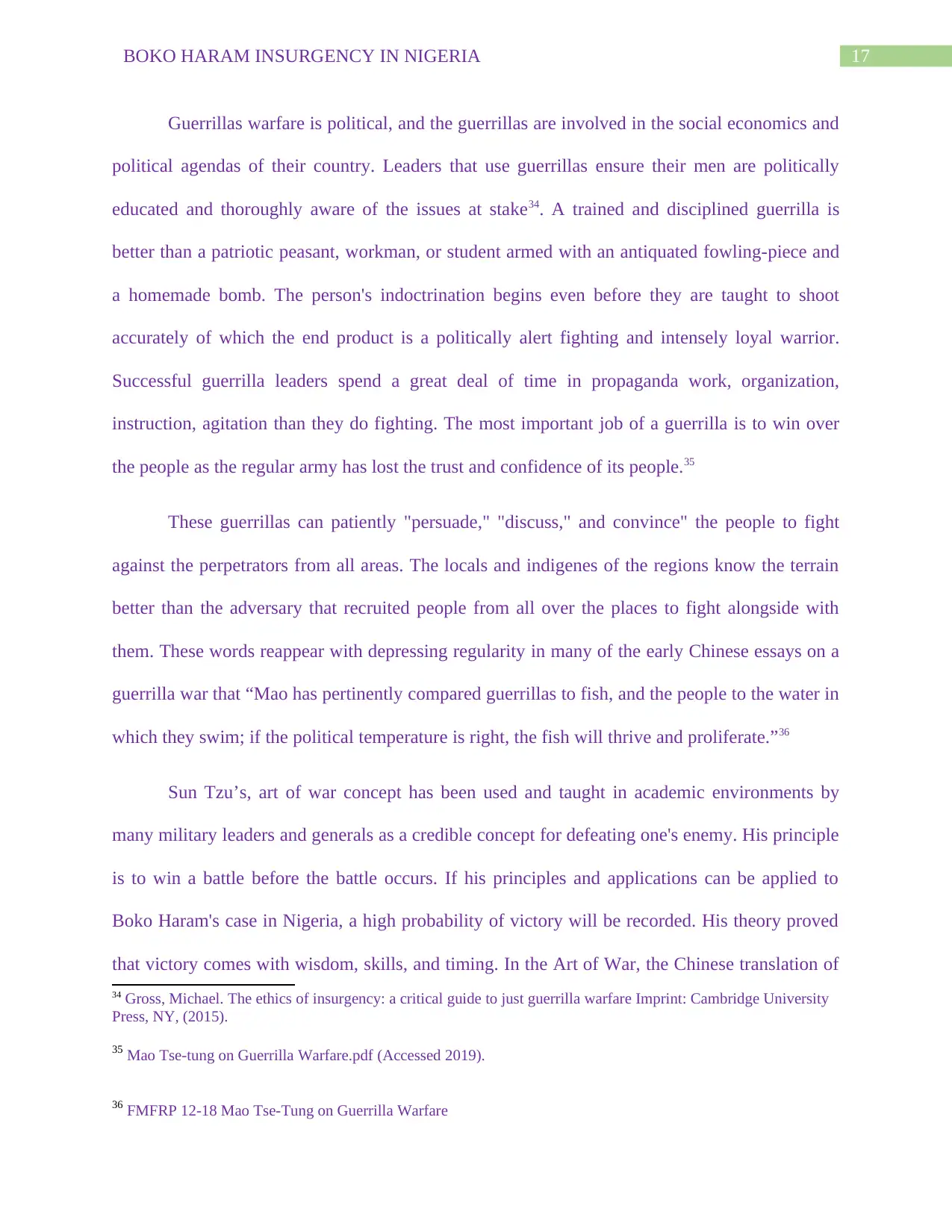
17BOKO HARAM INSURGENCY IN NIGERIA
Guerrillas warfare is political, and the guerrillas are involved in the social economics and
political agendas of their country. Leaders that use guerrillas ensure their men are politically
educated and thoroughly aware of the issues at stake34. A trained and disciplined guerrilla is
better than a patriotic peasant, workman, or student armed with an antiquated fowling-piece and
a homemade bomb. The person's indoctrination begins even before they are taught to shoot
accurately of which the end product is a politically alert fighting and intensely loyal warrior.
Successful guerrilla leaders spend a great deal of time in propaganda work, organization,
instruction, agitation than they do fighting. The most important job of a guerrilla is to win over
the people as the regular army has lost the trust and confidence of its people.35
These guerrillas can patiently "persuade," "discuss," and convince" the people to fight
against the perpetrators from all areas. The locals and indigenes of the regions know the terrain
better than the adversary that recruited people from all over the places to fight alongside with
them. These words reappear with depressing regularity in many of the early Chinese essays on a
guerrilla war that “Mao has pertinently compared guerrillas to fish, and the people to the water in
which they swim; if the political temperature is right, the fish will thrive and proliferate.”36
Sun Tzu’s, art of war concept has been used and taught in academic environments by
many military leaders and generals as a credible concept for defeating one's enemy. His principle
is to win a battle before the battle occurs. If his principles and applications can be applied to
Boko Haram's case in Nigeria, a high probability of victory will be recorded. His theory proved
that victory comes with wisdom, skills, and timing. In the Art of War, the Chinese translation of
34 Gross, Michael. The ethics of insurgency: a critical guide to just guerrilla warfare Imprint: Cambridge University
Press, NY, (2015).
35 Mao Tse-tung on Guerrilla Warfare.pdf (Accessed 2019).
36 FMFRP 12-18 Mao Tse-Tung on Guerrilla Warfare
Guerrillas warfare is political, and the guerrillas are involved in the social economics and
political agendas of their country. Leaders that use guerrillas ensure their men are politically
educated and thoroughly aware of the issues at stake34. A trained and disciplined guerrilla is
better than a patriotic peasant, workman, or student armed with an antiquated fowling-piece and
a homemade bomb. The person's indoctrination begins even before they are taught to shoot
accurately of which the end product is a politically alert fighting and intensely loyal warrior.
Successful guerrilla leaders spend a great deal of time in propaganda work, organization,
instruction, agitation than they do fighting. The most important job of a guerrilla is to win over
the people as the regular army has lost the trust and confidence of its people.35
These guerrillas can patiently "persuade," "discuss," and convince" the people to fight
against the perpetrators from all areas. The locals and indigenes of the regions know the terrain
better than the adversary that recruited people from all over the places to fight alongside with
them. These words reappear with depressing regularity in many of the early Chinese essays on a
guerrilla war that “Mao has pertinently compared guerrillas to fish, and the people to the water in
which they swim; if the political temperature is right, the fish will thrive and proliferate.”36
Sun Tzu’s, art of war concept has been used and taught in academic environments by
many military leaders and generals as a credible concept for defeating one's enemy. His principle
is to win a battle before the battle occurs. If his principles and applications can be applied to
Boko Haram's case in Nigeria, a high probability of victory will be recorded. His theory proved
that victory comes with wisdom, skills, and timing. In the Art of War, the Chinese translation of
34 Gross, Michael. The ethics of insurgency: a critical guide to just guerrilla warfare Imprint: Cambridge University
Press, NY, (2015).
35 Mao Tse-tung on Guerrilla Warfare.pdf (Accessed 2019).
36 FMFRP 12-18 Mao Tse-Tung on Guerrilla Warfare
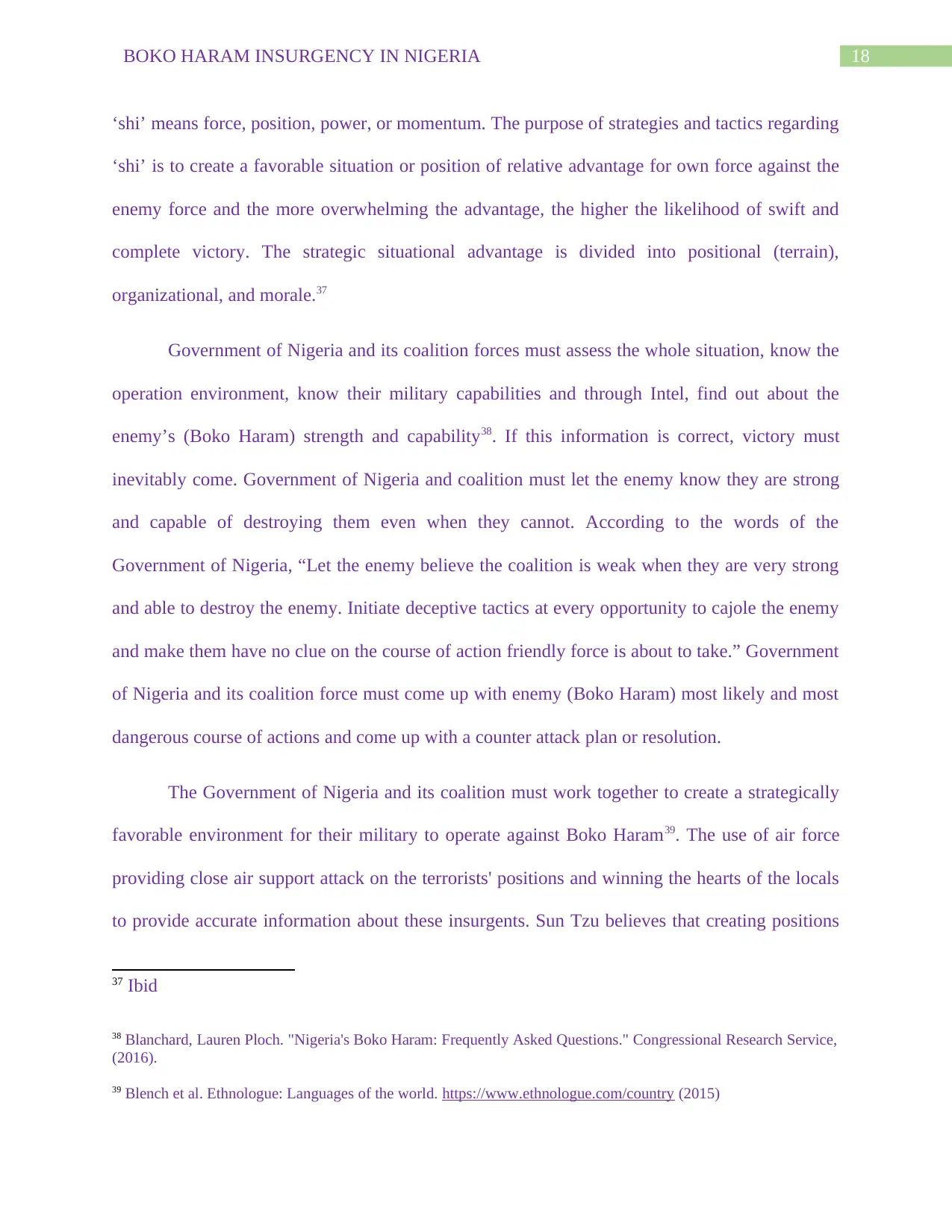
18BOKO HARAM INSURGENCY IN NIGERIA
‘shi’ means force, position, power, or momentum. The purpose of strategies and tactics regarding
‘shi’ is to create a favorable situation or position of relative advantage for own force against the
enemy force and the more overwhelming the advantage, the higher the likelihood of swift and
complete victory. The strategic situational advantage is divided into positional (terrain),
organizational, and morale.37
Government of Nigeria and its coalition forces must assess the whole situation, know the
operation environment, know their military capabilities and through Intel, find out about the
enemy’s (Boko Haram) strength and capability38. If this information is correct, victory must
inevitably come. Government of Nigeria and coalition must let the enemy know they are strong
and capable of destroying them even when they cannot. According to the words of the
Government of Nigeria, “Let the enemy believe the coalition is weak when they are very strong
and able to destroy the enemy. Initiate deceptive tactics at every opportunity to cajole the enemy
and make them have no clue on the course of action friendly force is about to take.” Government
of Nigeria and its coalition force must come up with enemy (Boko Haram) most likely and most
dangerous course of actions and come up with a counter attack plan or resolution.
The Government of Nigeria and its coalition must work together to create a strategically
favorable environment for their military to operate against Boko Haram39. The use of air force
providing close air support attack on the terrorists' positions and winning the hearts of the locals
to provide accurate information about these insurgents. Sun Tzu believes that creating positions
37 Ibid
38 Blanchard, Lauren Ploch. "Nigeria's Boko Haram: Frequently Asked Questions." Congressional Research Service,
(2016).
39 Blench et al. Ethnologue: Languages of the world. https://www.ethnologue.com/country (2015)
‘shi’ means force, position, power, or momentum. The purpose of strategies and tactics regarding
‘shi’ is to create a favorable situation or position of relative advantage for own force against the
enemy force and the more overwhelming the advantage, the higher the likelihood of swift and
complete victory. The strategic situational advantage is divided into positional (terrain),
organizational, and morale.37
Government of Nigeria and its coalition forces must assess the whole situation, know the
operation environment, know their military capabilities and through Intel, find out about the
enemy’s (Boko Haram) strength and capability38. If this information is correct, victory must
inevitably come. Government of Nigeria and coalition must let the enemy know they are strong
and capable of destroying them even when they cannot. According to the words of the
Government of Nigeria, “Let the enemy believe the coalition is weak when they are very strong
and able to destroy the enemy. Initiate deceptive tactics at every opportunity to cajole the enemy
and make them have no clue on the course of action friendly force is about to take.” Government
of Nigeria and its coalition force must come up with enemy (Boko Haram) most likely and most
dangerous course of actions and come up with a counter attack plan or resolution.
The Government of Nigeria and its coalition must work together to create a strategically
favorable environment for their military to operate against Boko Haram39. The use of air force
providing close air support attack on the terrorists' positions and winning the hearts of the locals
to provide accurate information about these insurgents. Sun Tzu believes that creating positions
37 Ibid
38 Blanchard, Lauren Ploch. "Nigeria's Boko Haram: Frequently Asked Questions." Congressional Research Service,
(2016).
39 Blench et al. Ethnologue: Languages of the world. https://www.ethnologue.com/country (2015)
Paraphrase This Document
Need a fresh take? Get an instant paraphrase of this document with our AI Paraphraser
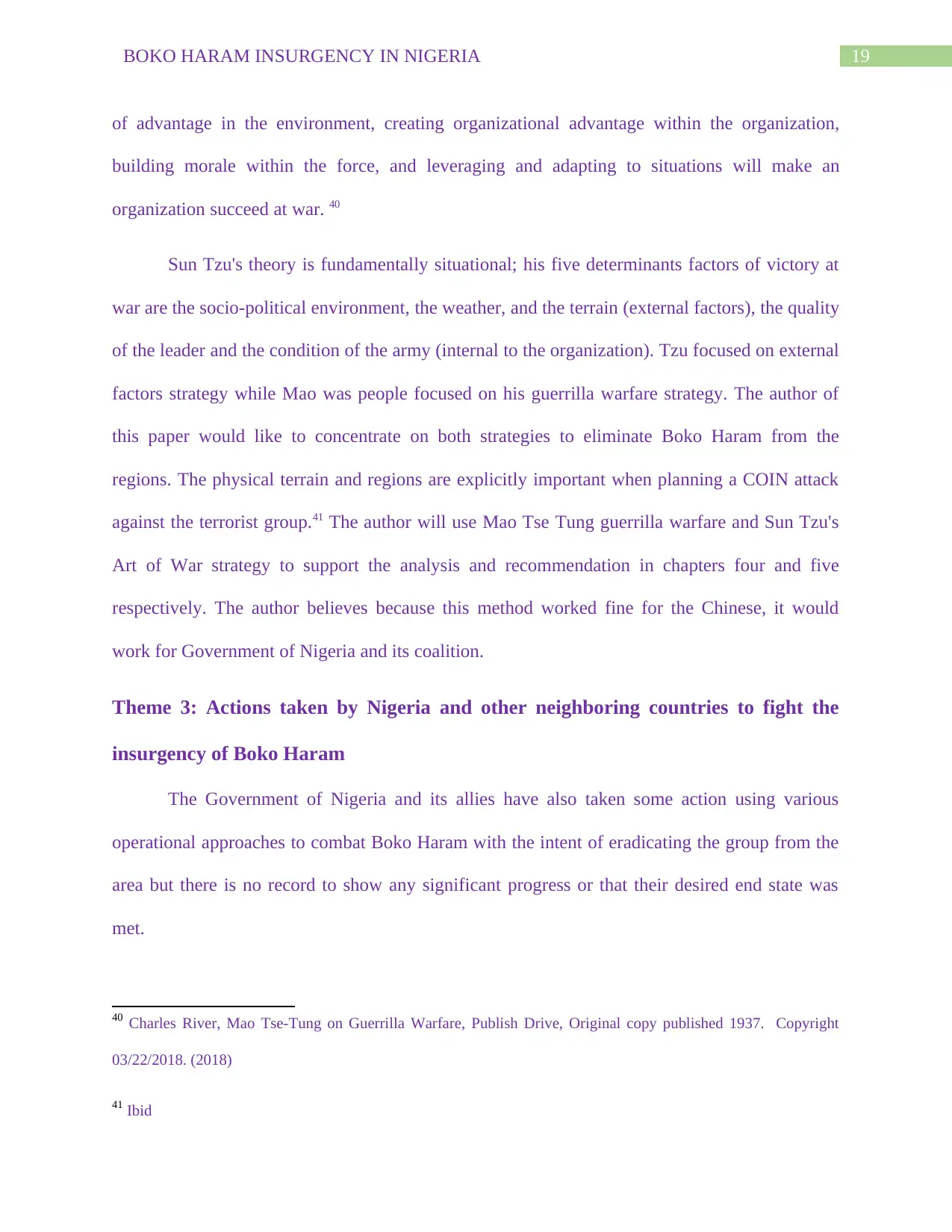
19BOKO HARAM INSURGENCY IN NIGERIA
of advantage in the environment, creating organizational advantage within the organization,
building morale within the force, and leveraging and adapting to situations will make an
organization succeed at war. 40
Sun Tzu's theory is fundamentally situational; his five determinants factors of victory at
war are the socio-political environment, the weather, and the terrain (external factors), the quality
of the leader and the condition of the army (internal to the organization). Tzu focused on external
factors strategy while Mao was people focused on his guerrilla warfare strategy. The author of
this paper would like to concentrate on both strategies to eliminate Boko Haram from the
regions. The physical terrain and regions are explicitly important when planning a COIN attack
against the terrorist group.41 The author will use Mao Tse Tung guerrilla warfare and Sun Tzu's
Art of War strategy to support the analysis and recommendation in chapters four and five
respectively. The author believes because this method worked fine for the Chinese, it would
work for Government of Nigeria and its coalition.
Theme 3: Actions taken by Nigeria and other neighboring countries to fight the
insurgency of Boko Haram
The Government of Nigeria and its allies have also taken some action using various
operational approaches to combat Boko Haram with the intent of eradicating the group from the
area but there is no record to show any significant progress or that their desired end state was
met.
40 Charles River, Mao Tse-Tung on Guerrilla Warfare, Publish Drive, Original copy published 1937. Copyright
03/22/2018. (2018)
41 Ibid
of advantage in the environment, creating organizational advantage within the organization,
building morale within the force, and leveraging and adapting to situations will make an
organization succeed at war. 40
Sun Tzu's theory is fundamentally situational; his five determinants factors of victory at
war are the socio-political environment, the weather, and the terrain (external factors), the quality
of the leader and the condition of the army (internal to the organization). Tzu focused on external
factors strategy while Mao was people focused on his guerrilla warfare strategy. The author of
this paper would like to concentrate on both strategies to eliminate Boko Haram from the
regions. The physical terrain and regions are explicitly important when planning a COIN attack
against the terrorist group.41 The author will use Mao Tse Tung guerrilla warfare and Sun Tzu's
Art of War strategy to support the analysis and recommendation in chapters four and five
respectively. The author believes because this method worked fine for the Chinese, it would
work for Government of Nigeria and its coalition.
Theme 3: Actions taken by Nigeria and other neighboring countries to fight the
insurgency of Boko Haram
The Government of Nigeria and its allies have also taken some action using various
operational approaches to combat Boko Haram with the intent of eradicating the group from the
area but there is no record to show any significant progress or that their desired end state was
met.
40 Charles River, Mao Tse-Tung on Guerrilla Warfare, Publish Drive, Original copy published 1937. Copyright
03/22/2018. (2018)
41 Ibid
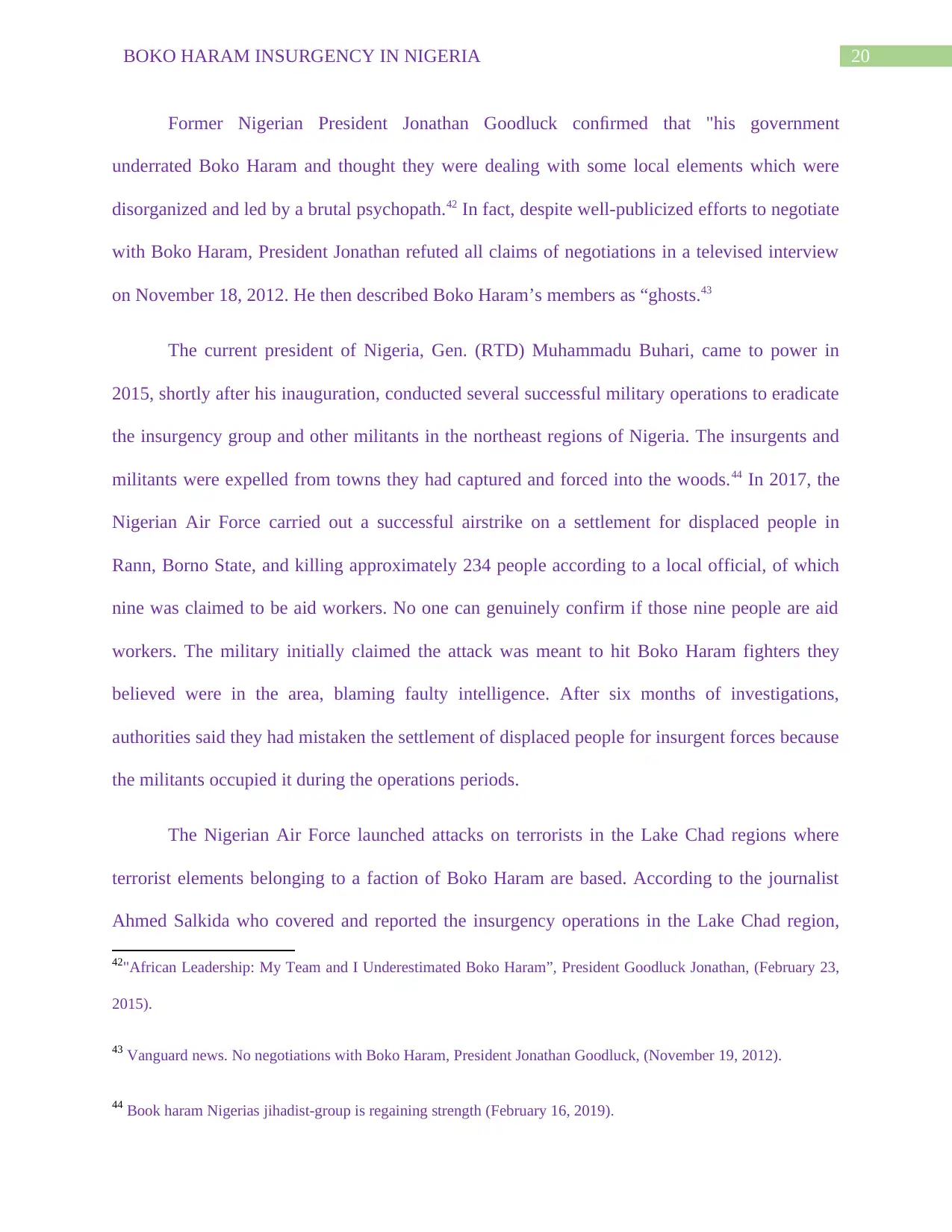
20BOKO HARAM INSURGENCY IN NIGERIA
Former Nigerian President Jonathan Goodluck confirmed that "his government
underrated Boko Haram and thought they were dealing with some local elements which were
disorganized and led by a brutal psychopath.42 In fact, despite well-publicized efforts to negotiate
with Boko Haram, President Jonathan refuted all claims of negotiations in a televised interview
on November 18, 2012. He then described Boko Haram’s members as “ghosts.43
The current president of Nigeria, Gen. (RTD) Muhammadu Buhari, came to power in
2015, shortly after his inauguration, conducted several successful military operations to eradicate
the insurgency group and other militants in the northeast regions of Nigeria. The insurgents and
militants were expelled from towns they had captured and forced into the woods.44 In 2017, the
Nigerian Air Force carried out a successful airstrike on a settlement for displaced people in
Rann, Borno State, and killing approximately 234 people according to a local official, of which
nine was claimed to be aid workers. No one can genuinely confirm if those nine people are aid
workers. The military initially claimed the attack was meant to hit Boko Haram fighters they
believed were in the area, blaming faulty intelligence. After six months of investigations,
authorities said they had mistaken the settlement of displaced people for insurgent forces because
the militants occupied it during the operations periods.
The Nigerian Air Force launched attacks on terrorists in the Lake Chad regions where
terrorist elements belonging to a faction of Boko Haram are based. According to the journalist
Ahmed Salkida who covered and reported the insurgency operations in the Lake Chad region,
42"African Leadership: My Team and I Underestimated Boko Haram”, President Goodluck Jonathan, (February 23,
2015).
43 Vanguard news. No negotiations with Boko Haram, President Jonathan Goodluck, (November 19, 2012).
44 Book haram Nigerias jihadist-group is regaining strength (February 16, 2019).
Former Nigerian President Jonathan Goodluck confirmed that "his government
underrated Boko Haram and thought they were dealing with some local elements which were
disorganized and led by a brutal psychopath.42 In fact, despite well-publicized efforts to negotiate
with Boko Haram, President Jonathan refuted all claims of negotiations in a televised interview
on November 18, 2012. He then described Boko Haram’s members as “ghosts.43
The current president of Nigeria, Gen. (RTD) Muhammadu Buhari, came to power in
2015, shortly after his inauguration, conducted several successful military operations to eradicate
the insurgency group and other militants in the northeast regions of Nigeria. The insurgents and
militants were expelled from towns they had captured and forced into the woods.44 In 2017, the
Nigerian Air Force carried out a successful airstrike on a settlement for displaced people in
Rann, Borno State, and killing approximately 234 people according to a local official, of which
nine was claimed to be aid workers. No one can genuinely confirm if those nine people are aid
workers. The military initially claimed the attack was meant to hit Boko Haram fighters they
believed were in the area, blaming faulty intelligence. After six months of investigations,
authorities said they had mistaken the settlement of displaced people for insurgent forces because
the militants occupied it during the operations periods.
The Nigerian Air Force launched attacks on terrorists in the Lake Chad regions where
terrorist elements belonging to a faction of Boko Haram are based. According to the journalist
Ahmed Salkida who covered and reported the insurgency operations in the Lake Chad region,
42"African Leadership: My Team and I Underestimated Boko Haram”, President Goodluck Jonathan, (February 23,
2015).
43 Vanguard news. No negotiations with Boko Haram, President Jonathan Goodluck, (November 19, 2012).
44 Book haram Nigerias jihadist-group is regaining strength (February 16, 2019).
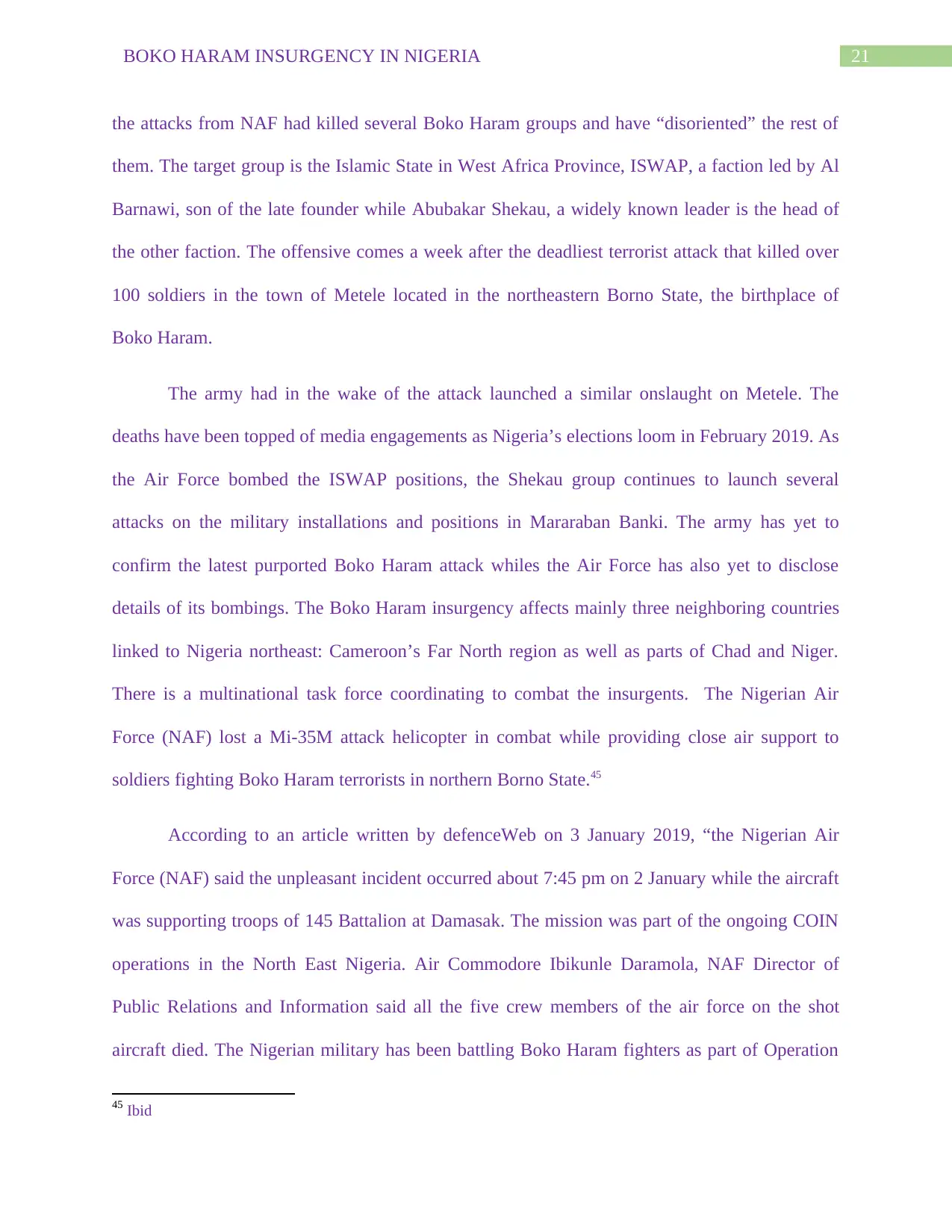
21BOKO HARAM INSURGENCY IN NIGERIA
the attacks from NAF had killed several Boko Haram groups and have “disoriented” the rest of
them. The target group is the Islamic State in West Africa Province, ISWAP, a faction led by Al
Barnawi, son of the late founder while Abubakar Shekau, a widely known leader is the head of
the other faction. The offensive comes a week after the deadliest terrorist attack that killed over
100 soldiers in the town of Metele located in the northeastern Borno State, the birthplace of
Boko Haram.
The army had in the wake of the attack launched a similar onslaught on Metele. The
deaths have been topped of media engagements as Nigeria’s elections loom in February 2019. As
the Air Force bombed the ISWAP positions, the Shekau group continues to launch several
attacks on the military installations and positions in Mararaban Banki. The army has yet to
confirm the latest purported Boko Haram attack whiles the Air Force has also yet to disclose
details of its bombings. The Boko Haram insurgency affects mainly three neighboring countries
linked to Nigeria northeast: Cameroon’s Far North region as well as parts of Chad and Niger.
There is a multinational task force coordinating to combat the insurgents. The Nigerian Air
Force (NAF) lost a Mi-35M attack helicopter in combat while providing close air support to
soldiers fighting Boko Haram terrorists in northern Borno State.45
According to an article written by defenceWeb on 3 January 2019, “the Nigerian Air
Force (NAF) said the unpleasant incident occurred about 7:45 pm on 2 January while the aircraft
was supporting troops of 145 Battalion at Damasak. The mission was part of the ongoing COIN
operations in the North East Nigeria. Air Commodore Ibikunle Daramola, NAF Director of
Public Relations and Information said all the five crew members of the air force on the shot
aircraft died. The Nigerian military has been battling Boko Haram fighters as part of Operation
45 Ibid
the attacks from NAF had killed several Boko Haram groups and have “disoriented” the rest of
them. The target group is the Islamic State in West Africa Province, ISWAP, a faction led by Al
Barnawi, son of the late founder while Abubakar Shekau, a widely known leader is the head of
the other faction. The offensive comes a week after the deadliest terrorist attack that killed over
100 soldiers in the town of Metele located in the northeastern Borno State, the birthplace of
Boko Haram.
The army had in the wake of the attack launched a similar onslaught on Metele. The
deaths have been topped of media engagements as Nigeria’s elections loom in February 2019. As
the Air Force bombed the ISWAP positions, the Shekau group continues to launch several
attacks on the military installations and positions in Mararaban Banki. The army has yet to
confirm the latest purported Boko Haram attack whiles the Air Force has also yet to disclose
details of its bombings. The Boko Haram insurgency affects mainly three neighboring countries
linked to Nigeria northeast: Cameroon’s Far North region as well as parts of Chad and Niger.
There is a multinational task force coordinating to combat the insurgents. The Nigerian Air
Force (NAF) lost a Mi-35M attack helicopter in combat while providing close air support to
soldiers fighting Boko Haram terrorists in northern Borno State.45
According to an article written by defenceWeb on 3 January 2019, “the Nigerian Air
Force (NAF) said the unpleasant incident occurred about 7:45 pm on 2 January while the aircraft
was supporting troops of 145 Battalion at Damasak. The mission was part of the ongoing COIN
operations in the North East Nigeria. Air Commodore Ibikunle Daramola, NAF Director of
Public Relations and Information said all the five crew members of the air force on the shot
aircraft died. The Nigerian military has been battling Boko Haram fighters as part of Operation
45 Ibid
Secure Best Marks with AI Grader
Need help grading? Try our AI Grader for instant feedback on your assignments.
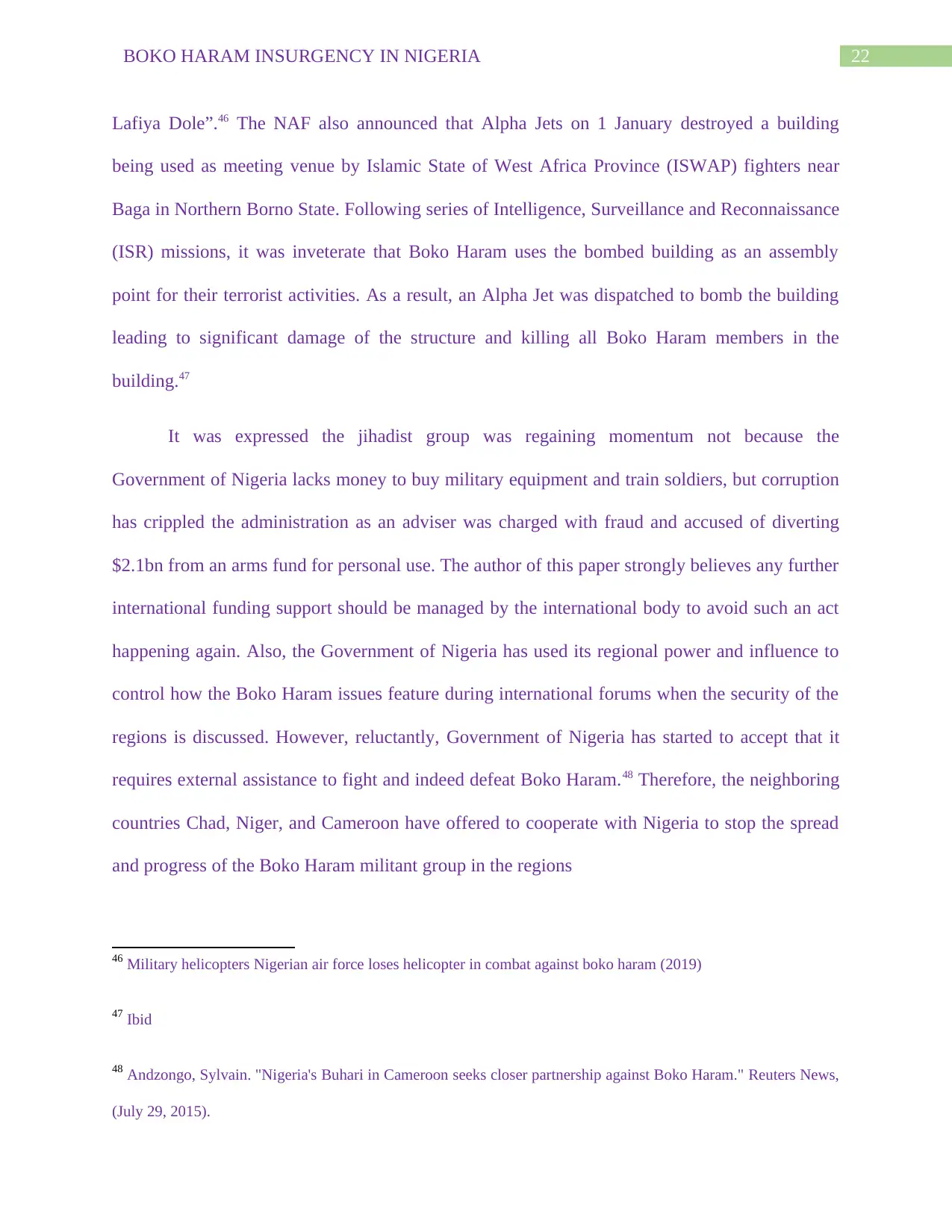
22BOKO HARAM INSURGENCY IN NIGERIA
Lafiya Dole”.46 The NAF also announced that Alpha Jets on 1 January destroyed a building
being used as meeting venue by Islamic State of West Africa Province (ISWAP) fighters near
Baga in Northern Borno State. Following series of Intelligence, Surveillance and Reconnaissance
(ISR) missions, it was inveterate that Boko Haram uses the bombed building as an assembly
point for their terrorist activities. As a result, an Alpha Jet was dispatched to bomb the building
leading to significant damage of the structure and killing all Boko Haram members in the
building.47
It was expressed the jihadist group was regaining momentum not because the
Government of Nigeria lacks money to buy military equipment and train soldiers, but corruption
has crippled the administration as an adviser was charged with fraud and accused of diverting
$2.1bn from an arms fund for personal use. The author of this paper strongly believes any further
international funding support should be managed by the international body to avoid such an act
happening again. Also, the Government of Nigeria has used its regional power and influence to
control how the Boko Haram issues feature during international forums when the security of the
regions is discussed. However, reluctantly, Government of Nigeria has started to accept that it
requires external assistance to fight and indeed defeat Boko Haram.48 Therefore, the neighboring
countries Chad, Niger, and Cameroon have offered to cooperate with Nigeria to stop the spread
and progress of the Boko Haram militant group in the regions
46 Military helicopters Nigerian air force loses helicopter in combat against boko haram (2019)
47 Ibid
48 Andzongo, Sylvain. "Nigeria's Buhari in Cameroon seeks closer partnership against Boko Haram." Reuters News,
(July 29, 2015).
Lafiya Dole”.46 The NAF also announced that Alpha Jets on 1 January destroyed a building
being used as meeting venue by Islamic State of West Africa Province (ISWAP) fighters near
Baga in Northern Borno State. Following series of Intelligence, Surveillance and Reconnaissance
(ISR) missions, it was inveterate that Boko Haram uses the bombed building as an assembly
point for their terrorist activities. As a result, an Alpha Jet was dispatched to bomb the building
leading to significant damage of the structure and killing all Boko Haram members in the
building.47
It was expressed the jihadist group was regaining momentum not because the
Government of Nigeria lacks money to buy military equipment and train soldiers, but corruption
has crippled the administration as an adviser was charged with fraud and accused of diverting
$2.1bn from an arms fund for personal use. The author of this paper strongly believes any further
international funding support should be managed by the international body to avoid such an act
happening again. Also, the Government of Nigeria has used its regional power and influence to
control how the Boko Haram issues feature during international forums when the security of the
regions is discussed. However, reluctantly, Government of Nigeria has started to accept that it
requires external assistance to fight and indeed defeat Boko Haram.48 Therefore, the neighboring
countries Chad, Niger, and Cameroon have offered to cooperate with Nigeria to stop the spread
and progress of the Boko Haram militant group in the regions
46 Military helicopters Nigerian air force loses helicopter in combat against boko haram (2019)
47 Ibid
48 Andzongo, Sylvain. "Nigeria's Buhari in Cameroon seeks closer partnership against Boko Haram." Reuters News,
(July 29, 2015).
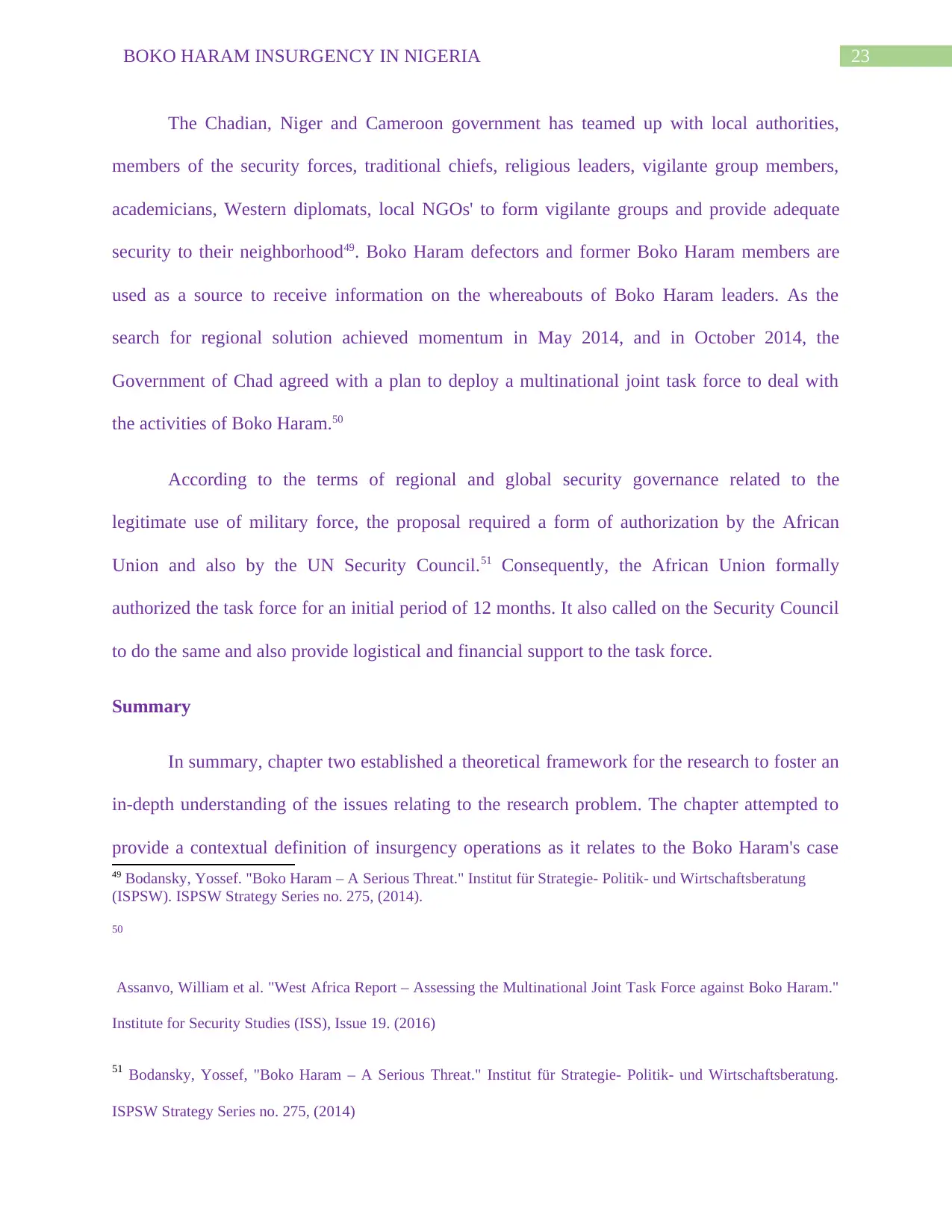
23BOKO HARAM INSURGENCY IN NIGERIA
The Chadian, Niger and Cameroon government has teamed up with local authorities,
members of the security forces, traditional chiefs, religious leaders, vigilante group members,
academicians, Western diplomats, local NGOs' to form vigilante groups and provide adequate
security to their neighborhood49. Boko Haram defectors and former Boko Haram members are
used as a source to receive information on the whereabouts of Boko Haram leaders. As the
search for regional solution achieved momentum in May 2014, and in October 2014, the
Government of Chad agreed with a plan to deploy a multinational joint task force to deal with
the activities of Boko Haram.50
According to the terms of regional and global security governance related to the
legitimate use of military force, the proposal required a form of authorization by the African
Union and also by the UN Security Council.51 Consequently, the African Union formally
authorized the task force for an initial period of 12 months. It also called on the Security Council
to do the same and also provide logistical and financial support to the task force.
Summary
In summary, chapter two established a theoretical framework for the research to foster an
in-depth understanding of the issues relating to the research problem. The chapter attempted to
provide a contextual definition of insurgency operations as it relates to the Boko Haram's case
49 Bodansky, Yossef. "Boko Haram – A Serious Threat." Institut für Strategie- Politik- und Wirtschaftsberatung
(ISPSW). ISPSW Strategy Series no. 275, (2014).
50
Assanvo, William et al. "West Africa Report – Assessing the Multinational Joint Task Force against Boko Haram."
Institute for Security Studies (ISS), Issue 19. (2016)
51 Bodansky, Yossef, "Boko Haram – A Serious Threat." Institut für Strategie- Politik- und Wirtschaftsberatung.
ISPSW Strategy Series no. 275, (2014)
The Chadian, Niger and Cameroon government has teamed up with local authorities,
members of the security forces, traditional chiefs, religious leaders, vigilante group members,
academicians, Western diplomats, local NGOs' to form vigilante groups and provide adequate
security to their neighborhood49. Boko Haram defectors and former Boko Haram members are
used as a source to receive information on the whereabouts of Boko Haram leaders. As the
search for regional solution achieved momentum in May 2014, and in October 2014, the
Government of Chad agreed with a plan to deploy a multinational joint task force to deal with
the activities of Boko Haram.50
According to the terms of regional and global security governance related to the
legitimate use of military force, the proposal required a form of authorization by the African
Union and also by the UN Security Council.51 Consequently, the African Union formally
authorized the task force for an initial period of 12 months. It also called on the Security Council
to do the same and also provide logistical and financial support to the task force.
Summary
In summary, chapter two established a theoretical framework for the research to foster an
in-depth understanding of the issues relating to the research problem. The chapter attempted to
provide a contextual definition of insurgency operations as it relates to the Boko Haram's case
49 Bodansky, Yossef. "Boko Haram – A Serious Threat." Institut für Strategie- Politik- und Wirtschaftsberatung
(ISPSW). ISPSW Strategy Series no. 275, (2014).
50
Assanvo, William et al. "West Africa Report – Assessing the Multinational Joint Task Force against Boko Haram."
Institute for Security Studies (ISS), Issue 19. (2016)
51 Bodansky, Yossef, "Boko Haram – A Serious Threat." Institut für Strategie- Politik- und Wirtschaftsberatung.
ISPSW Strategy Series no. 275, (2014)
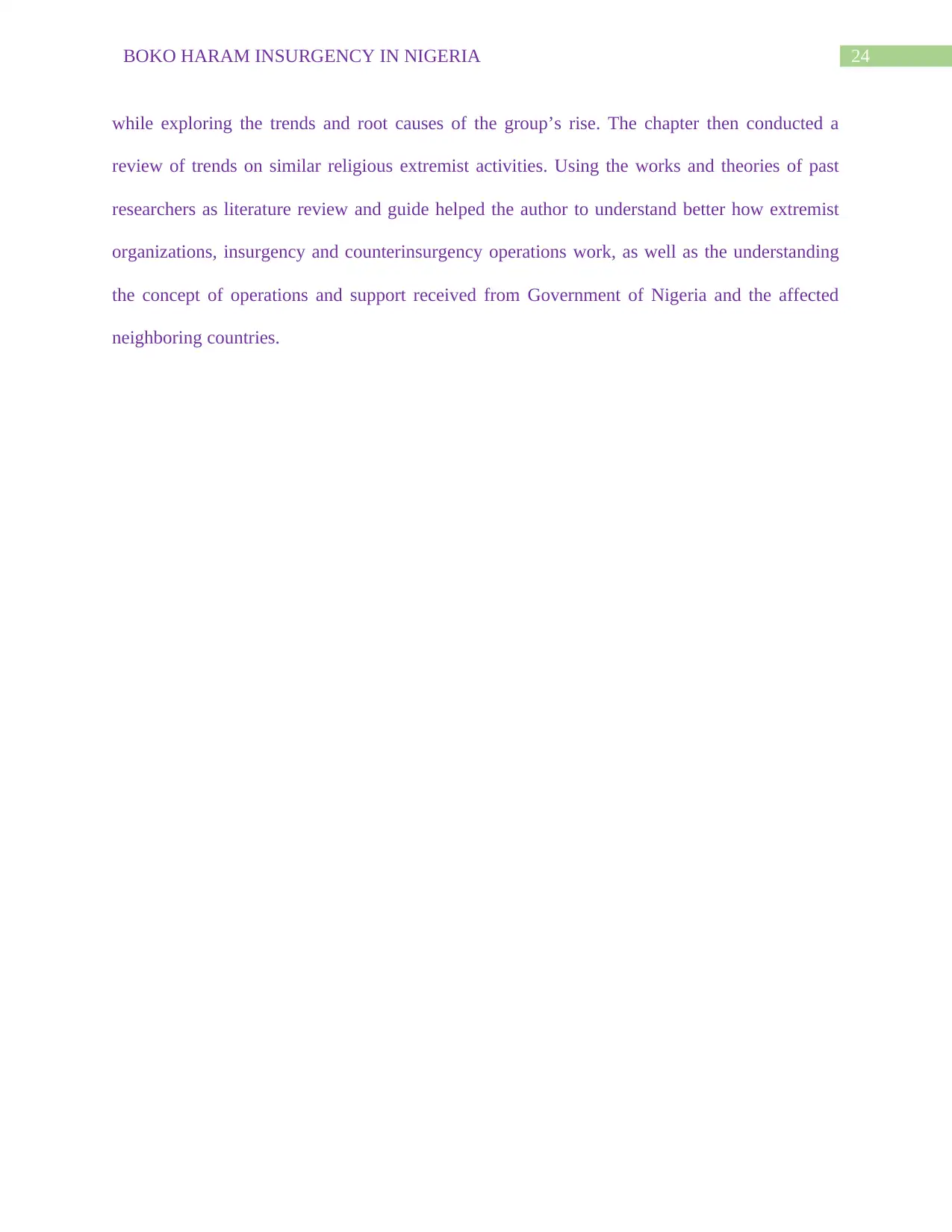
24BOKO HARAM INSURGENCY IN NIGERIA
while exploring the trends and root causes of the group’s rise. The chapter then conducted a
review of trends on similar religious extremist activities. Using the works and theories of past
researchers as literature review and guide helped the author to understand better how extremist
organizations, insurgency and counterinsurgency operations work, as well as the understanding
the concept of operations and support received from Government of Nigeria and the affected
neighboring countries.
while exploring the trends and root causes of the group’s rise. The chapter then conducted a
review of trends on similar religious extremist activities. Using the works and theories of past
researchers as literature review and guide helped the author to understand better how extremist
organizations, insurgency and counterinsurgency operations work, as well as the understanding
the concept of operations and support received from Government of Nigeria and the affected
neighboring countries.
Paraphrase This Document
Need a fresh take? Get an instant paraphrase of this document with our AI Paraphraser
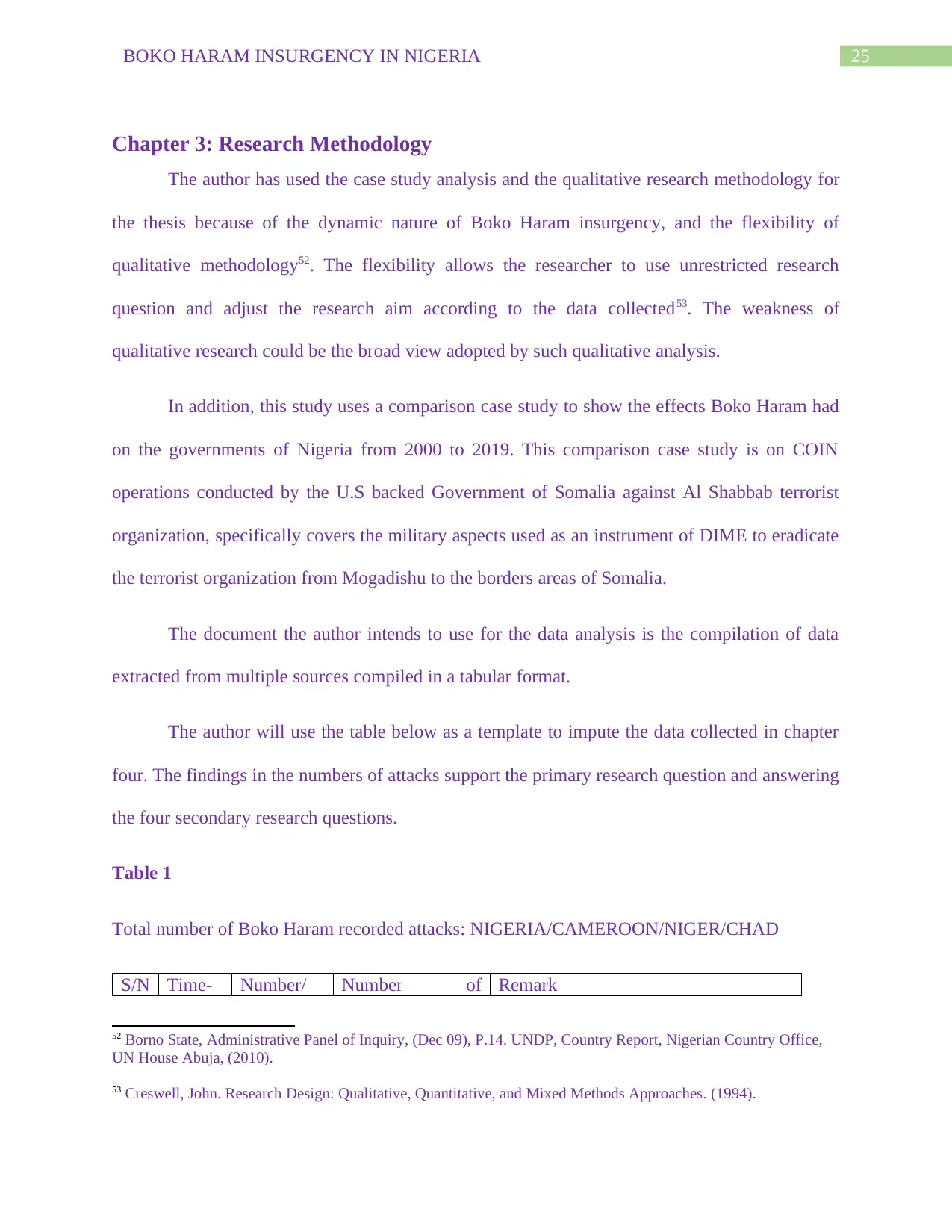
25BOKO HARAM INSURGENCY IN NIGERIA
Chapter 3: Research Methodology
The author has used the case study analysis and the qualitative research methodology for
the thesis because of the dynamic nature of Boko Haram insurgency, and the flexibility of
qualitative methodology52. The flexibility allows the researcher to use unrestricted research
question and adjust the research aim according to the data collected53. The weakness of
qualitative research could be the broad view adopted by such qualitative analysis.
In addition, this study uses a comparison case study to show the effects Boko Haram had
on the governments of Nigeria from 2000 to 2019. This comparison case study is on COIN
operations conducted by the U.S backed Government of Somalia against Al Shabbab terrorist
organization, specifically covers the military aspects used as an instrument of DIME to eradicate
the terrorist organization from Mogadishu to the borders areas of Somalia.
The document the author intends to use for the data analysis is the compilation of data
extracted from multiple sources compiled in a tabular format.
The author will use the table below as a template to impute the data collected in chapter
four. The findings in the numbers of attacks support the primary research question and answering
the four secondary research questions.
Table 1
Total number of Boko Haram recorded attacks: NIGERIA/CAMEROON/NIGER/CHAD
S/N Time- Number/ Number of Remark
52 Borno State, Administrative Panel of Inquiry, (Dec 09), P.14. UNDP, Country Report, Nigerian Country Office,
UN House Abuja, (2010).
53 Creswell, John. Research Design: Qualitative, Quantitative, and Mixed Methods Approaches. (1994).
Chapter 3: Research Methodology
The author has used the case study analysis and the qualitative research methodology for
the thesis because of the dynamic nature of Boko Haram insurgency, and the flexibility of
qualitative methodology52. The flexibility allows the researcher to use unrestricted research
question and adjust the research aim according to the data collected53. The weakness of
qualitative research could be the broad view adopted by such qualitative analysis.
In addition, this study uses a comparison case study to show the effects Boko Haram had
on the governments of Nigeria from 2000 to 2019. This comparison case study is on COIN
operations conducted by the U.S backed Government of Somalia against Al Shabbab terrorist
organization, specifically covers the military aspects used as an instrument of DIME to eradicate
the terrorist organization from Mogadishu to the borders areas of Somalia.
The document the author intends to use for the data analysis is the compilation of data
extracted from multiple sources compiled in a tabular format.
The author will use the table below as a template to impute the data collected in chapter
four. The findings in the numbers of attacks support the primary research question and answering
the four secondary research questions.
Table 1
Total number of Boko Haram recorded attacks: NIGERIA/CAMEROON/NIGER/CHAD
S/N Time- Number/ Number of Remark
52 Borno State, Administrative Panel of Inquiry, (Dec 09), P.14. UNDP, Country Report, Nigerian Country Office,
UN House Abuja, (2010).
53 Creswell, John. Research Design: Qualitative, Quantitative, and Mixed Methods Approaches. (1994).
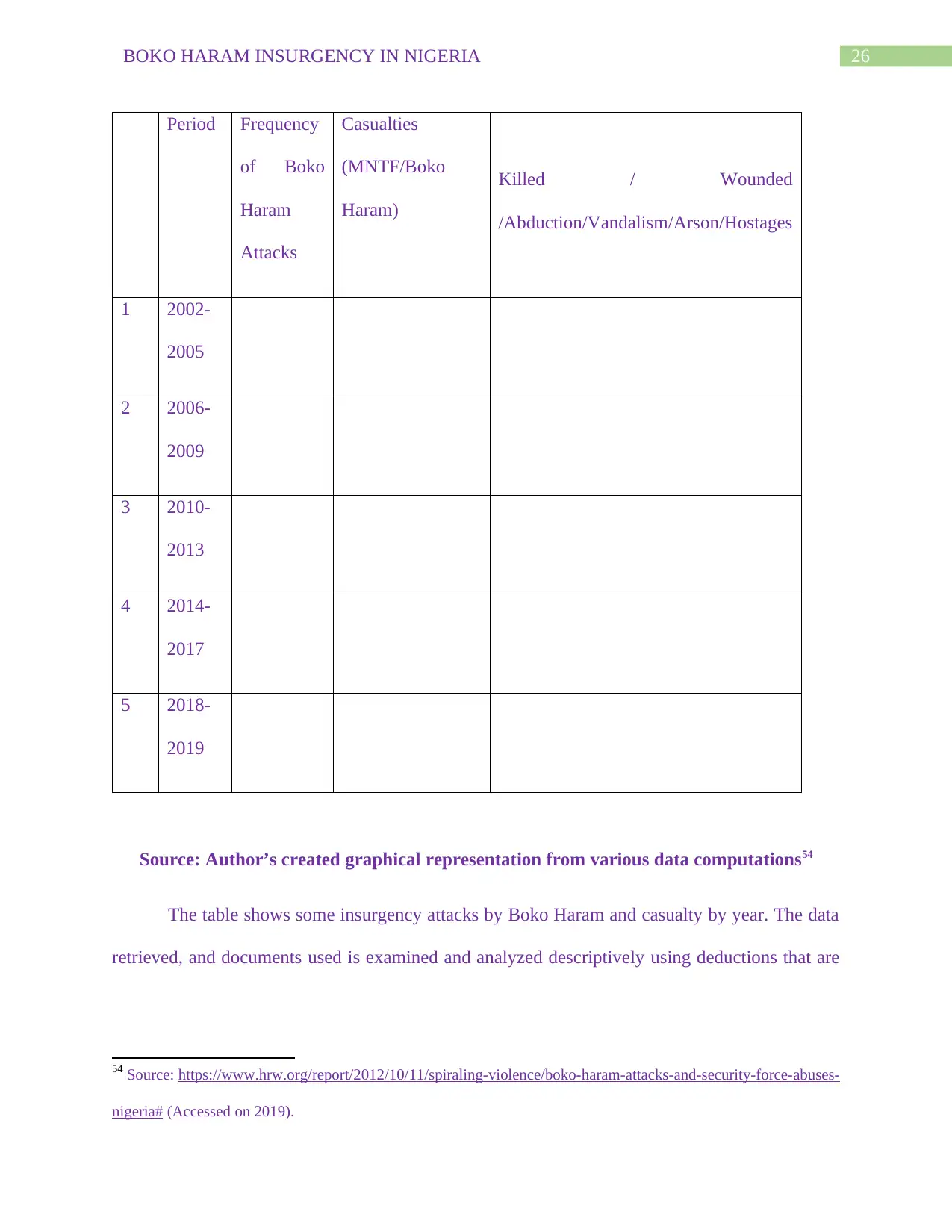
26BOKO HARAM INSURGENCY IN NIGERIA
Period Frequency
of Boko
Haram
Attacks
Casualties
(MNTF/Boko
Haram)
Killed / Wounded
/Abduction/Vandalism/Arson/Hostages
1 2002-
2005
2 2006-
2009
3 2010-
2013
4 2014-
2017
5 2018-
2019
Source: Author’s created graphical representation from various data computations54
The table shows some insurgency attacks by Boko Haram and casualty by year. The data
retrieved, and documents used is examined and analyzed descriptively using deductions that are
54 Source: https://www.hrw.org/report/2012/10/11/spiraling-violence/boko-haram-attacks-and-security-force-abuses-
nigeria# (Accessed on 2019).
Period Frequency
of Boko
Haram
Attacks
Casualties
(MNTF/Boko
Haram)
Killed / Wounded
/Abduction/Vandalism/Arson/Hostages
1 2002-
2005
2 2006-
2009
3 2010-
2013
4 2014-
2017
5 2018-
2019
Source: Author’s created graphical representation from various data computations54
The table shows some insurgency attacks by Boko Haram and casualty by year. The data
retrieved, and documents used is examined and analyzed descriptively using deductions that are
54 Source: https://www.hrw.org/report/2012/10/11/spiraling-violence/boko-haram-attacks-and-security-force-abuses-
nigeria# (Accessed on 2019).

27BOKO HARAM INSURGENCY IN NIGERIA
relevant, reliable, and facts from proven events. After that, the author has explained the
interpretation of the data to draw a conclusion and make a recommendation.
Data Collection
The author uses the method of case study analysis, proposition and analysis to drive the
research into defining the data that are to be collected55. After that, the author concentrates on
the rationale of linking the data to the proposition. This enables in the use of data and what
outcome to expect from the analysis (Creswell 2009, and Yin 2014).56
The author has collected the data from secondary sources using documents generated by
the Armed Conflict Location & Event Data Project (ACLED) on the patterns of Boko Haram’s
violence and associated fatalities since 2002-201957, documents generated by other various
credible sources like U.S. Africa Command, academic websites, and several other websites that
are credible for research purpose. This method is feasible to use by many researchers, and it will
be acceptable due to the case study the author chose and why he chose the case study on Al
Shabbab to compare Boko Haram insurgency. It is suitable to support the author's work and
validate the research paper and draws attention to the research of other authors who wrote or
shared similar ideas found in this paper.
55 George, Alexander L., and Andrew Bennet. Case Studies and Theory Development in the Social Sciences.
Cambridge: MIT Press, pg. 205-232, (2005)
56 Creswell (2009) and Yin (2014)
57 Armed Conflict Location & Event Data Project (ACLED)Stanford University’s Mapping Militants Project;
Terrorism Research & Analysis Consortium (TRAC) et al. [Accessed from ACLED websites, 2019]
relevant, reliable, and facts from proven events. After that, the author has explained the
interpretation of the data to draw a conclusion and make a recommendation.
Data Collection
The author uses the method of case study analysis, proposition and analysis to drive the
research into defining the data that are to be collected55. After that, the author concentrates on
the rationale of linking the data to the proposition. This enables in the use of data and what
outcome to expect from the analysis (Creswell 2009, and Yin 2014).56
The author has collected the data from secondary sources using documents generated by
the Armed Conflict Location & Event Data Project (ACLED) on the patterns of Boko Haram’s
violence and associated fatalities since 2002-201957, documents generated by other various
credible sources like U.S. Africa Command, academic websites, and several other websites that
are credible for research purpose. This method is feasible to use by many researchers, and it will
be acceptable due to the case study the author chose and why he chose the case study on Al
Shabbab to compare Boko Haram insurgency. It is suitable to support the author's work and
validate the research paper and draws attention to the research of other authors who wrote or
shared similar ideas found in this paper.
55 George, Alexander L., and Andrew Bennet. Case Studies and Theory Development in the Social Sciences.
Cambridge: MIT Press, pg. 205-232, (2005)
56 Creswell (2009) and Yin (2014)
57 Armed Conflict Location & Event Data Project (ACLED)Stanford University’s Mapping Militants Project;
Terrorism Research & Analysis Consortium (TRAC) et al. [Accessed from ACLED websites, 2019]
Secure Best Marks with AI Grader
Need help grading? Try our AI Grader for instant feedback on your assignments.
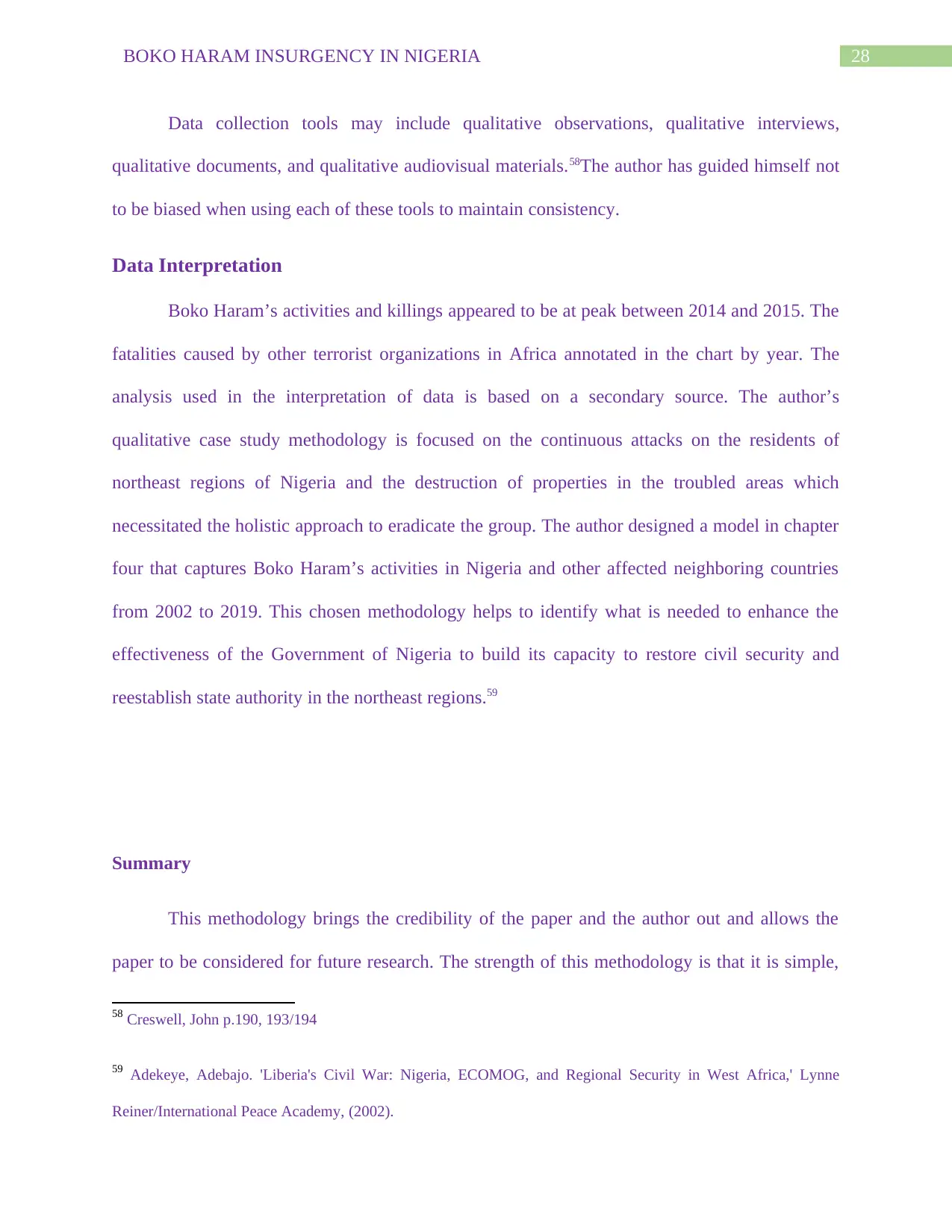
28BOKO HARAM INSURGENCY IN NIGERIA
Data collection tools may include qualitative observations, qualitative interviews,
qualitative documents, and qualitative audiovisual materials.58The author has guided himself not
to be biased when using each of these tools to maintain consistency.
Data Interpretation
Boko Haram’s activities and killings appeared to be at peak between 2014 and 2015. The
fatalities caused by other terrorist organizations in Africa annotated in the chart by year. The
analysis used in the interpretation of data is based on a secondary source. The author’s
qualitative case study methodology is focused on the continuous attacks on the residents of
northeast regions of Nigeria and the destruction of properties in the troubled areas which
necessitated the holistic approach to eradicate the group. The author designed a model in chapter
four that captures Boko Haram’s activities in Nigeria and other affected neighboring countries
from 2002 to 2019. This chosen methodology helps to identify what is needed to enhance the
effectiveness of the Government of Nigeria to build its capacity to restore civil security and
reestablish state authority in the northeast regions.59
Summary
This methodology brings the credibility of the paper and the author out and allows the
paper to be considered for future research. The strength of this methodology is that it is simple,
58 Creswell, John p.190, 193/194
59 Adekeye, Adebajo. 'Liberia's Civil War: Nigeria, ECOMOG, and Regional Security in West Africa,' Lynne
Reiner/International Peace Academy, (2002).
Data collection tools may include qualitative observations, qualitative interviews,
qualitative documents, and qualitative audiovisual materials.58The author has guided himself not
to be biased when using each of these tools to maintain consistency.
Data Interpretation
Boko Haram’s activities and killings appeared to be at peak between 2014 and 2015. The
fatalities caused by other terrorist organizations in Africa annotated in the chart by year. The
analysis used in the interpretation of data is based on a secondary source. The author’s
qualitative case study methodology is focused on the continuous attacks on the residents of
northeast regions of Nigeria and the destruction of properties in the troubled areas which
necessitated the holistic approach to eradicate the group. The author designed a model in chapter
four that captures Boko Haram’s activities in Nigeria and other affected neighboring countries
from 2002 to 2019. This chosen methodology helps to identify what is needed to enhance the
effectiveness of the Government of Nigeria to build its capacity to restore civil security and
reestablish state authority in the northeast regions.59
Summary
This methodology brings the credibility of the paper and the author out and allows the
paper to be considered for future research. The strength of this methodology is that it is simple,
58 Creswell, John p.190, 193/194
59 Adekeye, Adebajo. 'Liberia's Civil War: Nigeria, ECOMOG, and Regional Security in West Africa,' Lynne
Reiner/International Peace Academy, (2002).
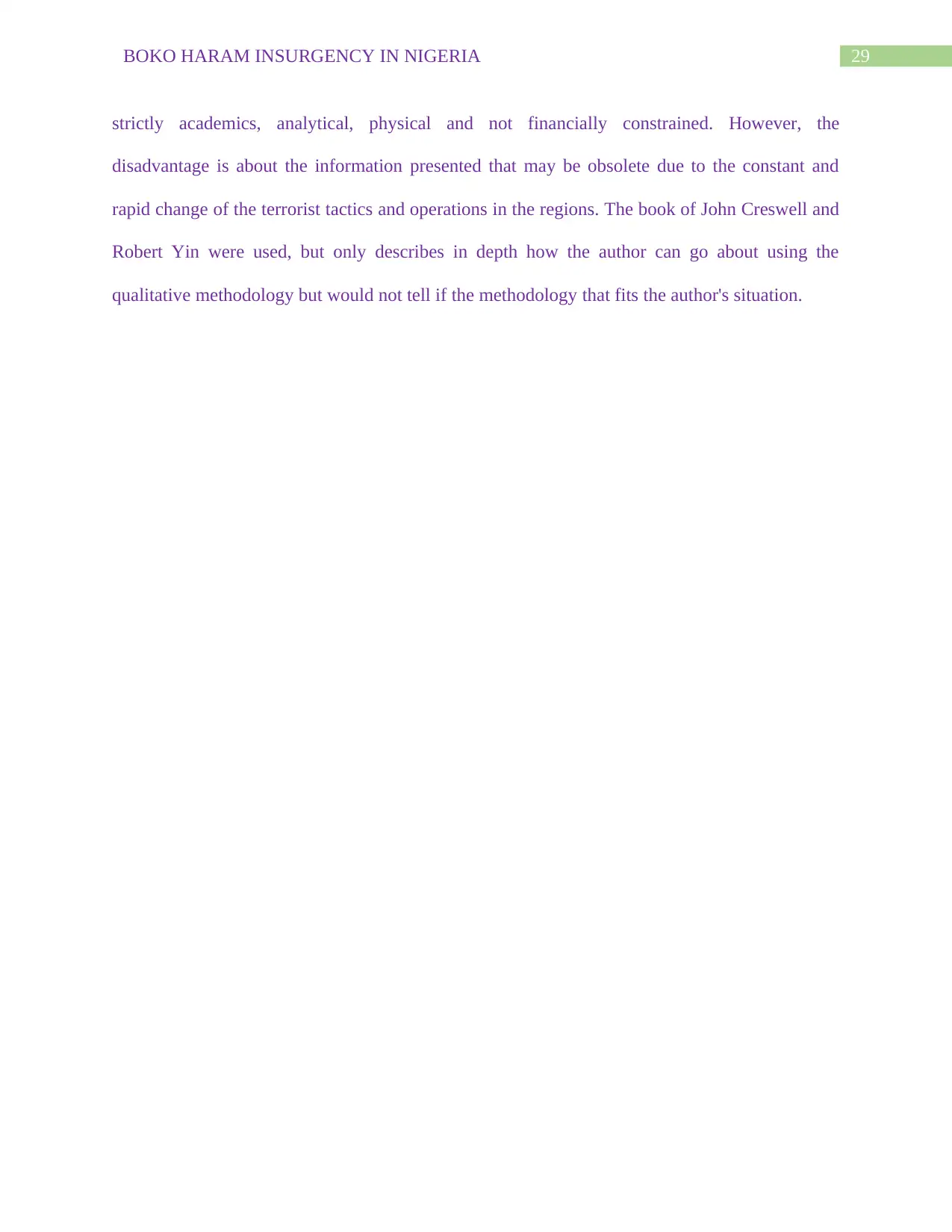
29BOKO HARAM INSURGENCY IN NIGERIA
strictly academics, analytical, physical and not financially constrained. However, the
disadvantage is about the information presented that may be obsolete due to the constant and
rapid change of the terrorist tactics and operations in the regions. The book of John Creswell and
Robert Yin were used, but only describes in depth how the author can go about using the
qualitative methodology but would not tell if the methodology that fits the author's situation.
strictly academics, analytical, physical and not financially constrained. However, the
disadvantage is about the information presented that may be obsolete due to the constant and
rapid change of the terrorist tactics and operations in the regions. The book of John Creswell and
Robert Yin were used, but only describes in depth how the author can go about using the
qualitative methodology but would not tell if the methodology that fits the author's situation.
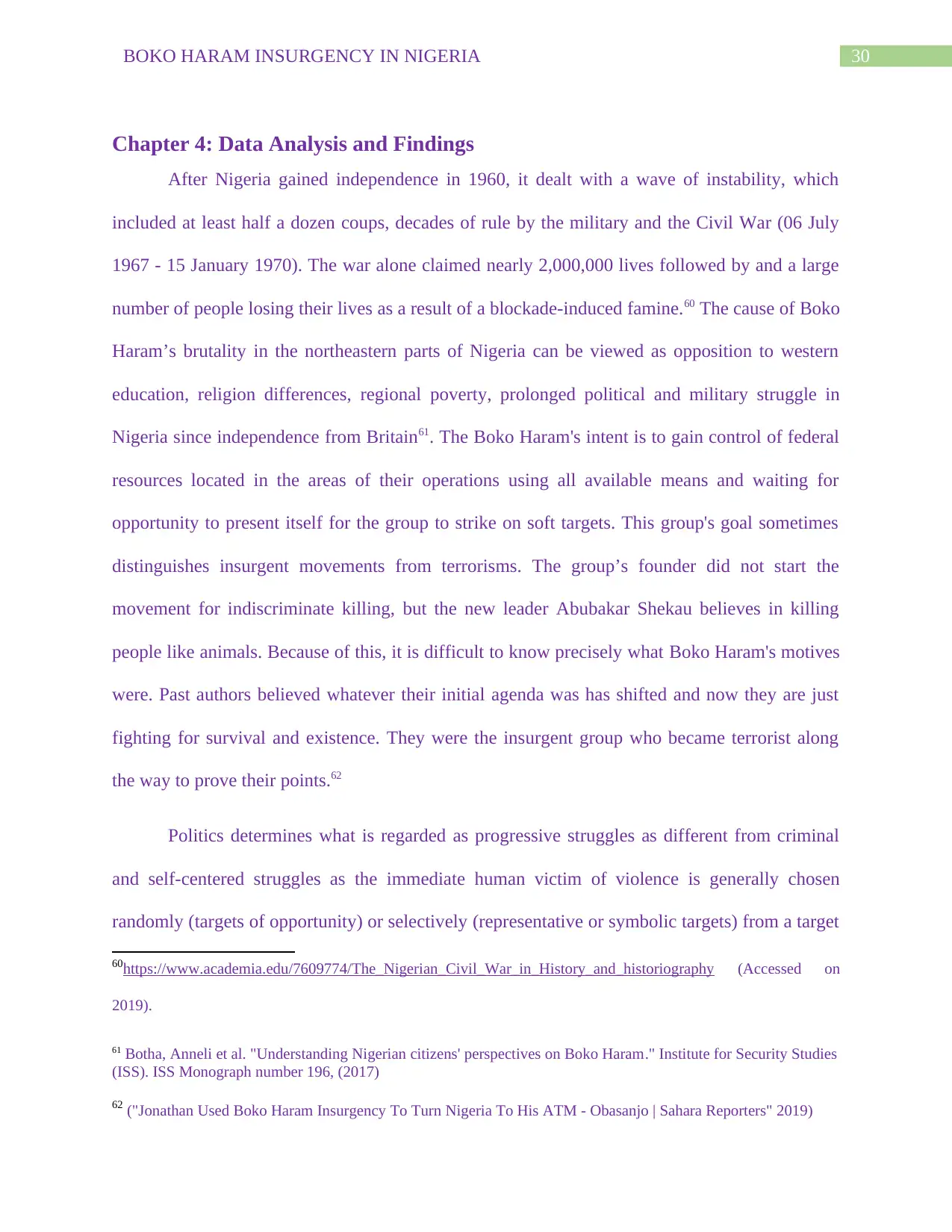
30BOKO HARAM INSURGENCY IN NIGERIA
Chapter 4: Data Analysis and Findings
After Nigeria gained independence in 1960, it dealt with a wave of instability, which
included at least half a dozen coups, decades of rule by the military and the Civil War (06 July
1967 - 15 January 1970). The war alone claimed nearly 2,000,000 lives followed by and a large
number of people losing their lives as a result of a blockade-induced famine.60 The cause of Boko
Haram’s brutality in the northeastern parts of Nigeria can be viewed as opposition to western
education, religion differences, regional poverty, prolonged political and military struggle in
Nigeria since independence from Britain61. The Boko Haram's intent is to gain control of federal
resources located in the areas of their operations using all available means and waiting for
opportunity to present itself for the group to strike on soft targets. This group's goal sometimes
distinguishes insurgent movements from terrorisms. The group’s founder did not start the
movement for indiscriminate killing, but the new leader Abubakar Shekau believes in killing
people like animals. Because of this, it is difficult to know precisely what Boko Haram's motives
were. Past authors believed whatever their initial agenda was has shifted and now they are just
fighting for survival and existence. They were the insurgent group who became terrorist along
the way to prove their points.62
Politics determines what is regarded as progressive struggles as different from criminal
and self-centered struggles as the immediate human victim of violence is generally chosen
randomly (targets of opportunity) or selectively (representative or symbolic targets) from a target
60https://www.academia.edu/7609774/The_Nigerian_Civil_War_in_History_and_historiography (Accessed on
2019).
61 Botha, Anneli et al. "Understanding Nigerian citizens' perspectives on Boko Haram." Institute for Security Studies
(ISS). ISS Monograph number 196, (2017)
62 ("Jonathan Used Boko Haram Insurgency To Turn Nigeria To His ATM - Obasanjo | Sahara Reporters" 2019)
Chapter 4: Data Analysis and Findings
After Nigeria gained independence in 1960, it dealt with a wave of instability, which
included at least half a dozen coups, decades of rule by the military and the Civil War (06 July
1967 - 15 January 1970). The war alone claimed nearly 2,000,000 lives followed by and a large
number of people losing their lives as a result of a blockade-induced famine.60 The cause of Boko
Haram’s brutality in the northeastern parts of Nigeria can be viewed as opposition to western
education, religion differences, regional poverty, prolonged political and military struggle in
Nigeria since independence from Britain61. The Boko Haram's intent is to gain control of federal
resources located in the areas of their operations using all available means and waiting for
opportunity to present itself for the group to strike on soft targets. This group's goal sometimes
distinguishes insurgent movements from terrorisms. The group’s founder did not start the
movement for indiscriminate killing, but the new leader Abubakar Shekau believes in killing
people like animals. Because of this, it is difficult to know precisely what Boko Haram's motives
were. Past authors believed whatever their initial agenda was has shifted and now they are just
fighting for survival and existence. They were the insurgent group who became terrorist along
the way to prove their points.62
Politics determines what is regarded as progressive struggles as different from criminal
and self-centered struggles as the immediate human victim of violence is generally chosen
randomly (targets of opportunity) or selectively (representative or symbolic targets) from a target
60https://www.academia.edu/7609774/The_Nigerian_Civil_War_in_History_and_historiography (Accessed on
2019).
61 Botha, Anneli et al. "Understanding Nigerian citizens' perspectives on Boko Haram." Institute for Security Studies
(ISS). ISS Monograph number 196, (2017)
62 ("Jonathan Used Boko Haram Insurgency To Turn Nigeria To His ATM - Obasanjo | Sahara Reporters" 2019)
Paraphrase This Document
Need a fresh take? Get an instant paraphrase of this document with our AI Paraphraser
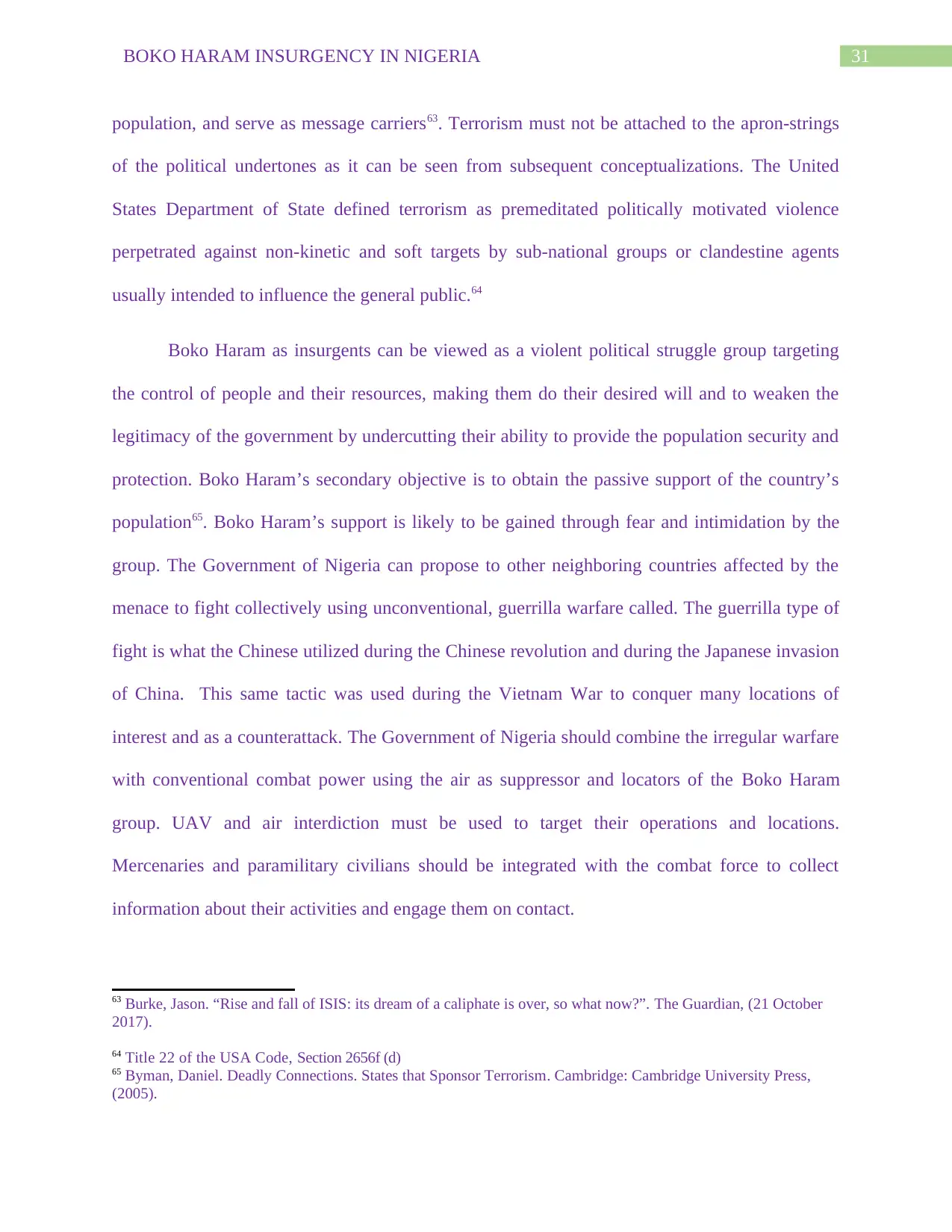
31BOKO HARAM INSURGENCY IN NIGERIA
population, and serve as message carriers63. Terrorism must not be attached to the apron-strings
of the political undertones as it can be seen from subsequent conceptualizations. The United
States Department of State defined terrorism as premeditated politically motivated violence
perpetrated against non-kinetic and soft targets by sub-national groups or clandestine agents
usually intended to influence the general public.64
Boko Haram as insurgents can be viewed as a violent political struggle group targeting
the control of people and their resources, making them do their desired will and to weaken the
legitimacy of the government by undercutting their ability to provide the population security and
protection. Boko Haram’s secondary objective is to obtain the passive support of the country’s
population65. Boko Haram’s support is likely to be gained through fear and intimidation by the
group. The Government of Nigeria can propose to other neighboring countries affected by the
menace to fight collectively using unconventional, guerrilla warfare called. The guerrilla type of
fight is what the Chinese utilized during the Chinese revolution and during the Japanese invasion
of China. This same tactic was used during the Vietnam War to conquer many locations of
interest and as a counterattack. The Government of Nigeria should combine the irregular warfare
with conventional combat power using the air as suppressor and locators of the Boko Haram
group. UAV and air interdiction must be used to target their operations and locations.
Mercenaries and paramilitary civilians should be integrated with the combat force to collect
information about their activities and engage them on contact.
63 Burke, Jason. “Rise and fall of ISIS: its dream of a caliphate is over, so what now?”. The Guardian, (21 October
2017).
64 Title 22 of the USA Code, Section 2656f (d)
65 Byman, Daniel. Deadly Connections. States that Sponsor Terrorism. Cambridge: Cambridge University Press,
(2005).
population, and serve as message carriers63. Terrorism must not be attached to the apron-strings
of the political undertones as it can be seen from subsequent conceptualizations. The United
States Department of State defined terrorism as premeditated politically motivated violence
perpetrated against non-kinetic and soft targets by sub-national groups or clandestine agents
usually intended to influence the general public.64
Boko Haram as insurgents can be viewed as a violent political struggle group targeting
the control of people and their resources, making them do their desired will and to weaken the
legitimacy of the government by undercutting their ability to provide the population security and
protection. Boko Haram’s secondary objective is to obtain the passive support of the country’s
population65. Boko Haram’s support is likely to be gained through fear and intimidation by the
group. The Government of Nigeria can propose to other neighboring countries affected by the
menace to fight collectively using unconventional, guerrilla warfare called. The guerrilla type of
fight is what the Chinese utilized during the Chinese revolution and during the Japanese invasion
of China. This same tactic was used during the Vietnam War to conquer many locations of
interest and as a counterattack. The Government of Nigeria should combine the irregular warfare
with conventional combat power using the air as suppressor and locators of the Boko Haram
group. UAV and air interdiction must be used to target their operations and locations.
Mercenaries and paramilitary civilians should be integrated with the combat force to collect
information about their activities and engage them on contact.
63 Burke, Jason. “Rise and fall of ISIS: its dream of a caliphate is over, so what now?”. The Guardian, (21 October
2017).
64 Title 22 of the USA Code, Section 2656f (d)
65 Byman, Daniel. Deadly Connections. States that Sponsor Terrorism. Cambridge: Cambridge University Press,
(2005).
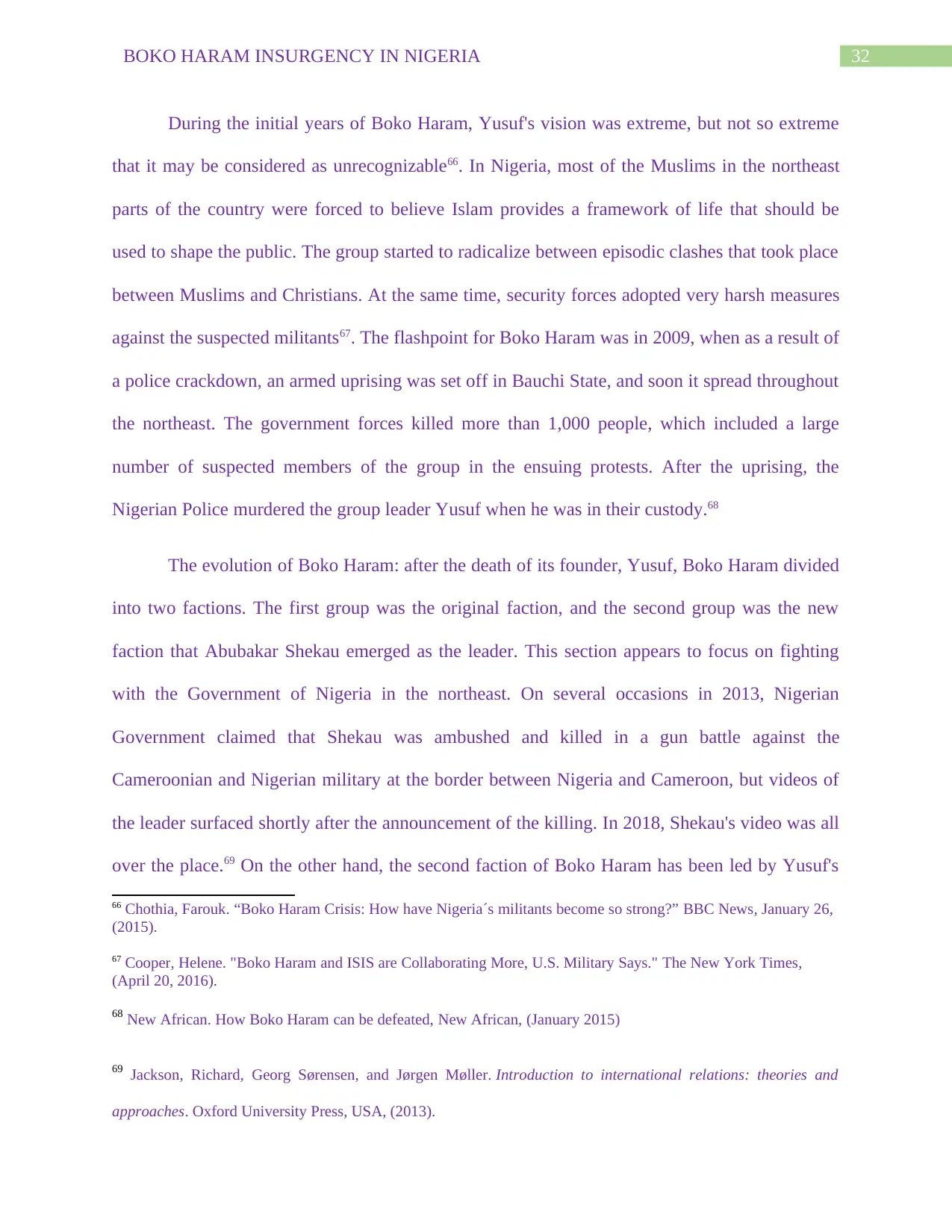
32BOKO HARAM INSURGENCY IN NIGERIA
During the initial years of Boko Haram, Yusuf's vision was extreme, but not so extreme
that it may be considered as unrecognizable66. In Nigeria, most of the Muslims in the northeast
parts of the country were forced to believe Islam provides a framework of life that should be
used to shape the public. The group started to radicalize between episodic clashes that took place
between Muslims and Christians. At the same time, security forces adopted very harsh measures
against the suspected militants67. The flashpoint for Boko Haram was in 2009, when as a result of
a police crackdown, an armed uprising was set off in Bauchi State, and soon it spread throughout
the northeast. The government forces killed more than 1,000 people, which included a large
number of suspected members of the group in the ensuing protests. After the uprising, the
Nigerian Police murdered the group leader Yusuf when he was in their custody.68
The evolution of Boko Haram: after the death of its founder, Yusuf, Boko Haram divided
into two factions. The first group was the original faction, and the second group was the new
faction that Abubakar Shekau emerged as the leader. This section appears to focus on fighting
with the Government of Nigeria in the northeast. On several occasions in 2013, Nigerian
Government claimed that Shekau was ambushed and killed in a gun battle against the
Cameroonian and Nigerian military at the border between Nigeria and Cameroon, but videos of
the leader surfaced shortly after the announcement of the killing. In 2018, Shekau's video was all
over the place.69 On the other hand, the second faction of Boko Haram has been led by Yusuf's
66 Chothia, Farouk. “Boko Haram Crisis: How have Nigeria´s militants become so strong?” BBC News, January 26,
(2015).
67 Cooper, Helene. "Boko Haram and ISIS are Collaborating More, U.S. Military Says." The New York Times,
(April 20, 2016).
68 New African. How Boko Haram can be defeated, New African, (January 2015)
69 Jackson, Richard, Georg Sørensen, and Jørgen Møller. Introduction to international relations: theories and
approaches. Oxford University Press, USA, (2013).
During the initial years of Boko Haram, Yusuf's vision was extreme, but not so extreme
that it may be considered as unrecognizable66. In Nigeria, most of the Muslims in the northeast
parts of the country were forced to believe Islam provides a framework of life that should be
used to shape the public. The group started to radicalize between episodic clashes that took place
between Muslims and Christians. At the same time, security forces adopted very harsh measures
against the suspected militants67. The flashpoint for Boko Haram was in 2009, when as a result of
a police crackdown, an armed uprising was set off in Bauchi State, and soon it spread throughout
the northeast. The government forces killed more than 1,000 people, which included a large
number of suspected members of the group in the ensuing protests. After the uprising, the
Nigerian Police murdered the group leader Yusuf when he was in their custody.68
The evolution of Boko Haram: after the death of its founder, Yusuf, Boko Haram divided
into two factions. The first group was the original faction, and the second group was the new
faction that Abubakar Shekau emerged as the leader. This section appears to focus on fighting
with the Government of Nigeria in the northeast. On several occasions in 2013, Nigerian
Government claimed that Shekau was ambushed and killed in a gun battle against the
Cameroonian and Nigerian military at the border between Nigeria and Cameroon, but videos of
the leader surfaced shortly after the announcement of the killing. In 2018, Shekau's video was all
over the place.69 On the other hand, the second faction of Boko Haram has been led by Yusuf's
66 Chothia, Farouk. “Boko Haram Crisis: How have Nigeria´s militants become so strong?” BBC News, January 26,
(2015).
67 Cooper, Helene. "Boko Haram and ISIS are Collaborating More, U.S. Military Says." The New York Times,
(April 20, 2016).
68 New African. How Boko Haram can be defeated, New African, (January 2015)
69 Jackson, Richard, Georg Sørensen, and Jørgen Møller. Introduction to international relations: theories and
approaches. Oxford University Press, USA, (2013).
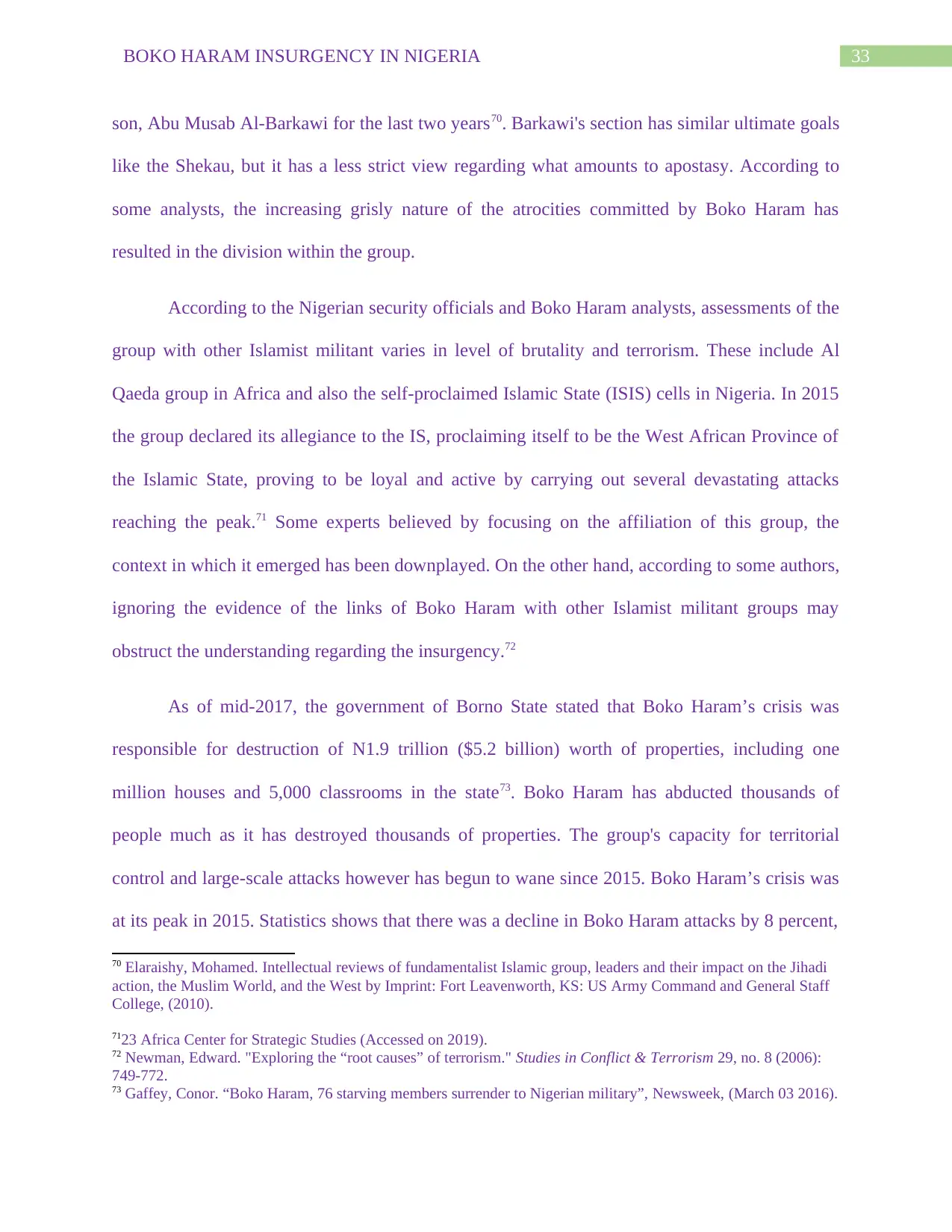
33BOKO HARAM INSURGENCY IN NIGERIA
son, Abu Musab Al-Barkawi for the last two years70. Barkawi's section has similar ultimate goals
like the Shekau, but it has a less strict view regarding what amounts to apostasy. According to
some analysts, the increasing grisly nature of the atrocities committed by Boko Haram has
resulted in the division within the group.
According to the Nigerian security officials and Boko Haram analysts, assessments of the
group with other Islamist militant varies in level of brutality and terrorism. These include Al
Qaeda group in Africa and also the self-proclaimed Islamic State (ISIS) cells in Nigeria. In 2015
the group declared its allegiance to the IS, proclaiming itself to be the West African Province of
the Islamic State, proving to be loyal and active by carrying out several devastating attacks
reaching the peak.71 Some experts believed by focusing on the affiliation of this group, the
context in which it emerged has been downplayed. On the other hand, according to some authors,
ignoring the evidence of the links of Boko Haram with other Islamist militant groups may
obstruct the understanding regarding the insurgency.72
As of mid-2017, the government of Borno State stated that Boko Haram’s crisis was
responsible for destruction of N1.9 trillion ($5.2 billion) worth of properties, including one
million houses and 5,000 classrooms in the state73. Boko Haram has abducted thousands of
people much as it has destroyed thousands of properties. The group's capacity for territorial
control and large-scale attacks however has begun to wane since 2015. Boko Haram’s crisis was
at its peak in 2015. Statistics shows that there was a decline in Boko Haram attacks by 8 percent,
70 Elaraishy, Mohamed. Intellectual reviews of fundamentalist Islamic group, leaders and their impact on the Jihadi
action, the Muslim World, and the West by Imprint: Fort Leavenworth, KS: US Army Command and General Staff
College, (2010).
7123 Africa Center for Strategic Studies (Accessed on 2019).
72 Newman, Edward. "Exploring the “root causes” of terrorism." Studies in Conflict & Terrorism 29, no. 8 (2006):
749-772.
73 Gaffey, Conor. “Boko Haram, 76 starving members surrender to Nigerian military”, Newsweek, (March 03 2016).
son, Abu Musab Al-Barkawi for the last two years70. Barkawi's section has similar ultimate goals
like the Shekau, but it has a less strict view regarding what amounts to apostasy. According to
some analysts, the increasing grisly nature of the atrocities committed by Boko Haram has
resulted in the division within the group.
According to the Nigerian security officials and Boko Haram analysts, assessments of the
group with other Islamist militant varies in level of brutality and terrorism. These include Al
Qaeda group in Africa and also the self-proclaimed Islamic State (ISIS) cells in Nigeria. In 2015
the group declared its allegiance to the IS, proclaiming itself to be the West African Province of
the Islamic State, proving to be loyal and active by carrying out several devastating attacks
reaching the peak.71 Some experts believed by focusing on the affiliation of this group, the
context in which it emerged has been downplayed. On the other hand, according to some authors,
ignoring the evidence of the links of Boko Haram with other Islamist militant groups may
obstruct the understanding regarding the insurgency.72
As of mid-2017, the government of Borno State stated that Boko Haram’s crisis was
responsible for destruction of N1.9 trillion ($5.2 billion) worth of properties, including one
million houses and 5,000 classrooms in the state73. Boko Haram has abducted thousands of
people much as it has destroyed thousands of properties. The group's capacity for territorial
control and large-scale attacks however has begun to wane since 2015. Boko Haram’s crisis was
at its peak in 2015. Statistics shows that there was a decline in Boko Haram attacks by 8 percent,
70 Elaraishy, Mohamed. Intellectual reviews of fundamentalist Islamic group, leaders and their impact on the Jihadi
action, the Muslim World, and the West by Imprint: Fort Leavenworth, KS: US Army Command and General Staff
College, (2010).
7123 Africa Center for Strategic Studies (Accessed on 2019).
72 Newman, Edward. "Exploring the “root causes” of terrorism." Studies in Conflict & Terrorism 29, no. 8 (2006):
749-772.
73 Gaffey, Conor. “Boko Haram, 76 starving members surrender to Nigerian military”, Newsweek, (March 03 2016).
Secure Best Marks with AI Grader
Need help grading? Try our AI Grader for instant feedback on your assignments.
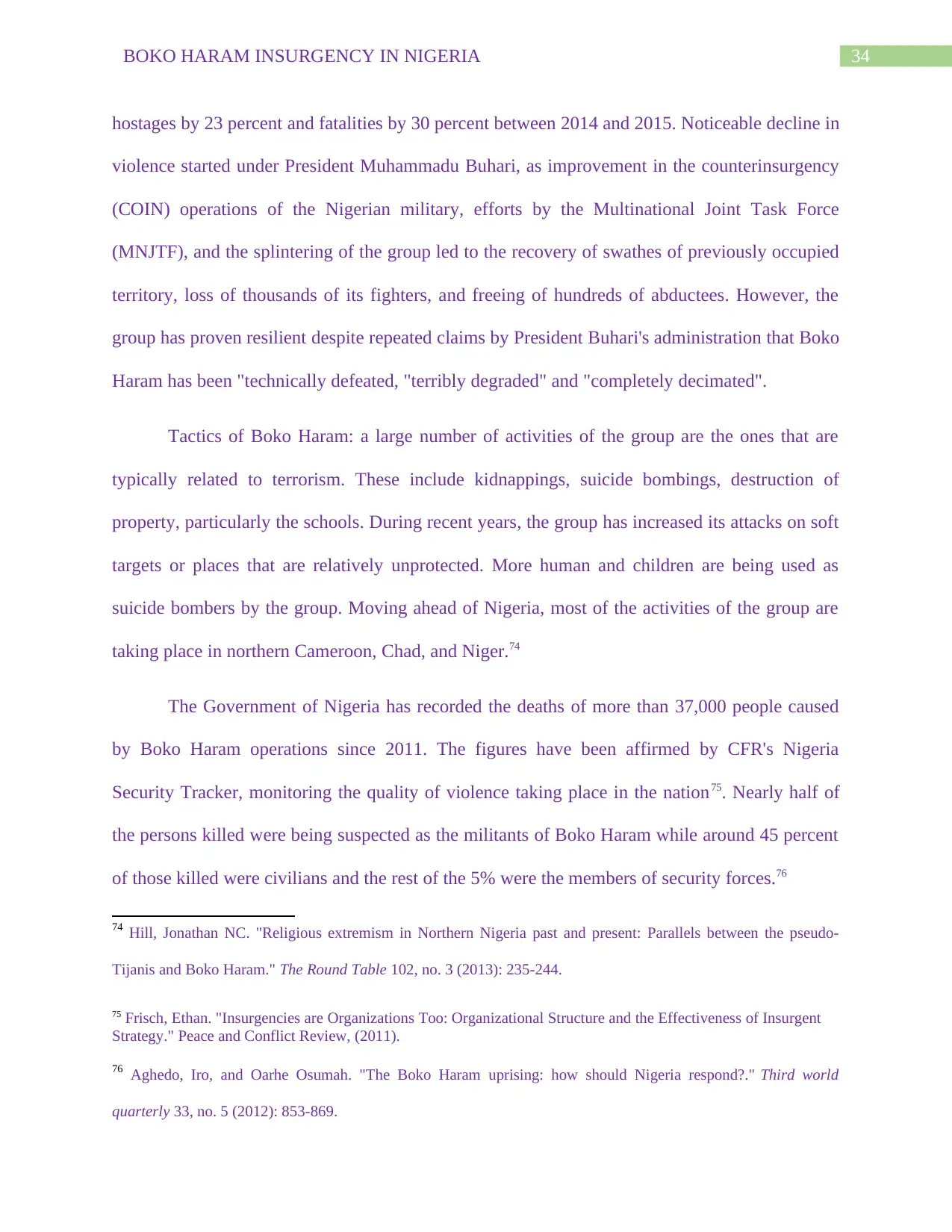
34BOKO HARAM INSURGENCY IN NIGERIA
hostages by 23 percent and fatalities by 30 percent between 2014 and 2015. Noticeable decline in
violence started under President Muhammadu Buhari, as improvement in the counterinsurgency
(COIN) operations of the Nigerian military, efforts by the Multinational Joint Task Force
(MNJTF), and the splintering of the group led to the recovery of swathes of previously occupied
territory, loss of thousands of its fighters, and freeing of hundreds of abductees. However, the
group has proven resilient despite repeated claims by President Buhari's administration that Boko
Haram has been "technically defeated, "terribly degraded" and "completely decimated".
Tactics of Boko Haram: a large number of activities of the group are the ones that are
typically related to terrorism. These include kidnappings, suicide bombings, destruction of
property, particularly the schools. During recent years, the group has increased its attacks on soft
targets or places that are relatively unprotected. More human and children are being used as
suicide bombers by the group. Moving ahead of Nigeria, most of the activities of the group are
taking place in northern Cameroon, Chad, and Niger.74
The Government of Nigeria has recorded the deaths of more than 37,000 people caused
by Boko Haram operations since 2011. The figures have been affirmed by CFR's Nigeria
Security Tracker, monitoring the quality of violence taking place in the nation75. Nearly half of
the persons killed were being suspected as the militants of Boko Haram while around 45 percent
of those killed were civilians and the rest of the 5% were the members of security forces.76
74 Hill, Jonathan NC. "Religious extremism in Northern Nigeria past and present: Parallels between the pseudo-
Tijanis and Boko Haram." The Round Table 102, no. 3 (2013): 235-244.
75 Frisch, Ethan. "Insurgencies are Organizations Too: Organizational Structure and the Effectiveness of Insurgent
Strategy." Peace and Conflict Review, (2011).
76 Aghedo, Iro, and Oarhe Osumah. "The Boko Haram uprising: how should Nigeria respond?." Third world
quarterly 33, no. 5 (2012): 853-869.
hostages by 23 percent and fatalities by 30 percent between 2014 and 2015. Noticeable decline in
violence started under President Muhammadu Buhari, as improvement in the counterinsurgency
(COIN) operations of the Nigerian military, efforts by the Multinational Joint Task Force
(MNJTF), and the splintering of the group led to the recovery of swathes of previously occupied
territory, loss of thousands of its fighters, and freeing of hundreds of abductees. However, the
group has proven resilient despite repeated claims by President Buhari's administration that Boko
Haram has been "technically defeated, "terribly degraded" and "completely decimated".
Tactics of Boko Haram: a large number of activities of the group are the ones that are
typically related to terrorism. These include kidnappings, suicide bombings, destruction of
property, particularly the schools. During recent years, the group has increased its attacks on soft
targets or places that are relatively unprotected. More human and children are being used as
suicide bombers by the group. Moving ahead of Nigeria, most of the activities of the group are
taking place in northern Cameroon, Chad, and Niger.74
The Government of Nigeria has recorded the deaths of more than 37,000 people caused
by Boko Haram operations since 2011. The figures have been affirmed by CFR's Nigeria
Security Tracker, monitoring the quality of violence taking place in the nation75. Nearly half of
the persons killed were being suspected as the militants of Boko Haram while around 45 percent
of those killed were civilians and the rest of the 5% were the members of security forces.76
74 Hill, Jonathan NC. "Religious extremism in Northern Nigeria past and present: Parallels between the pseudo-
Tijanis and Boko Haram." The Round Table 102, no. 3 (2013): 235-244.
75 Frisch, Ethan. "Insurgencies are Organizations Too: Organizational Structure and the Effectiveness of Insurgent
Strategy." Peace and Conflict Review, (2011).
76 Aghedo, Iro, and Oarhe Osumah. "The Boko Haram uprising: how should Nigeria respond?." Third world
quarterly 33, no. 5 (2012): 853-869.
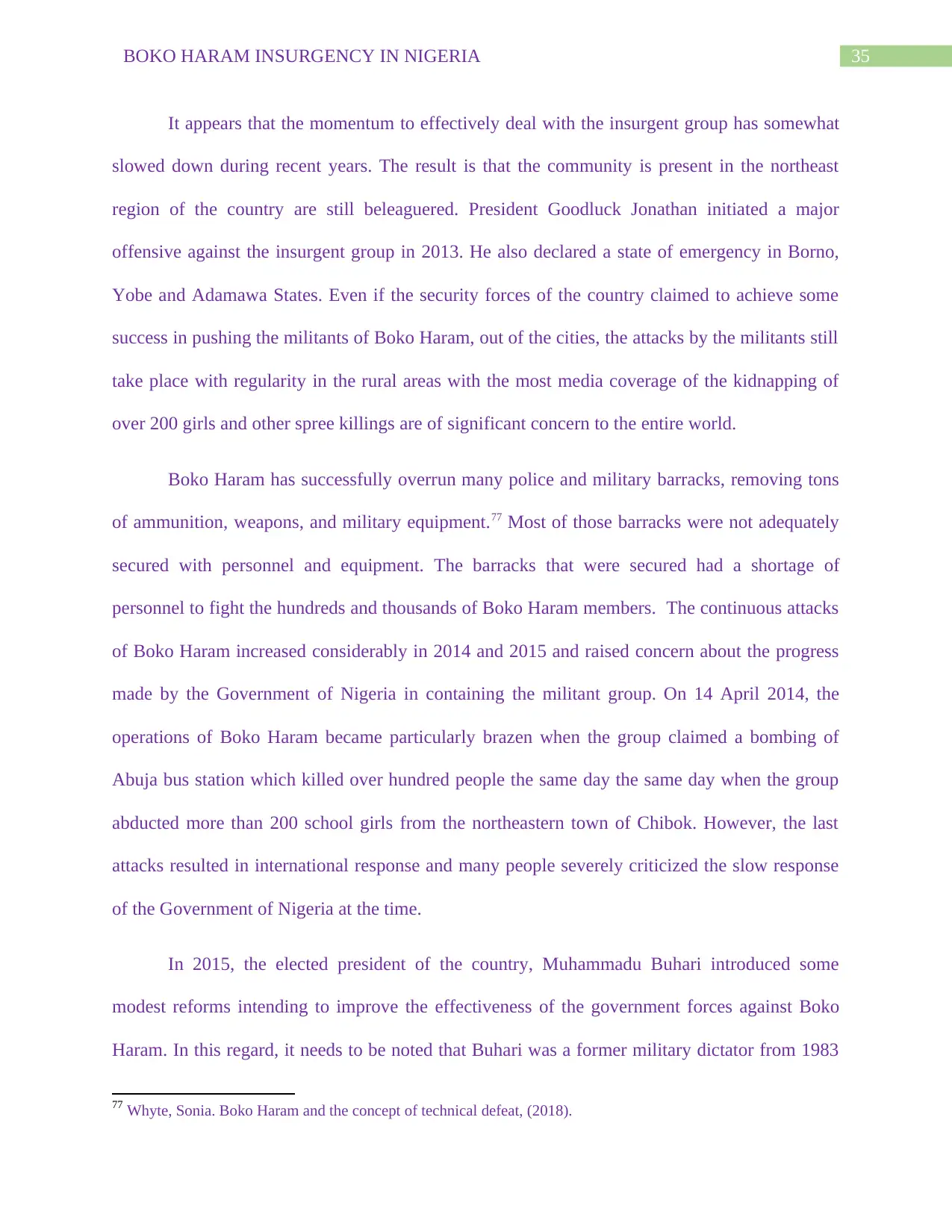
35BOKO HARAM INSURGENCY IN NIGERIA
It appears that the momentum to effectively deal with the insurgent group has somewhat
slowed down during recent years. The result is that the community is present in the northeast
region of the country are still beleaguered. President Goodluck Jonathan initiated a major
offensive against the insurgent group in 2013. He also declared a state of emergency in Borno,
Yobe and Adamawa States. Even if the security forces of the country claimed to achieve some
success in pushing the militants of Boko Haram, out of the cities, the attacks by the militants still
take place with regularity in the rural areas with the most media coverage of the kidnapping of
over 200 girls and other spree killings are of significant concern to the entire world.
Boko Haram has successfully overrun many police and military barracks, removing tons
of ammunition, weapons, and military equipment.77 Most of those barracks were not adequately
secured with personnel and equipment. The barracks that were secured had a shortage of
personnel to fight the hundreds and thousands of Boko Haram members. The continuous attacks
of Boko Haram increased considerably in 2014 and 2015 and raised concern about the progress
made by the Government of Nigeria in containing the militant group. On 14 April 2014, the
operations of Boko Haram became particularly brazen when the group claimed a bombing of
Abuja bus station which killed over hundred people the same day the same day when the group
abducted more than 200 school girls from the northeastern town of Chibok. However, the last
attacks resulted in international response and many people severely criticized the slow response
of the Government of Nigeria at the time.
In 2015, the elected president of the country, Muhammadu Buhari introduced some
modest reforms intending to improve the effectiveness of the government forces against Boko
Haram. In this regard, it needs to be noted that Buhari was a former military dictator from 1983
77 Whyte, Sonia. Boko Haram and the concept of technical defeat, (2018).
It appears that the momentum to effectively deal with the insurgent group has somewhat
slowed down during recent years. The result is that the community is present in the northeast
region of the country are still beleaguered. President Goodluck Jonathan initiated a major
offensive against the insurgent group in 2013. He also declared a state of emergency in Borno,
Yobe and Adamawa States. Even if the security forces of the country claimed to achieve some
success in pushing the militants of Boko Haram, out of the cities, the attacks by the militants still
take place with regularity in the rural areas with the most media coverage of the kidnapping of
over 200 girls and other spree killings are of significant concern to the entire world.
Boko Haram has successfully overrun many police and military barracks, removing tons
of ammunition, weapons, and military equipment.77 Most of those barracks were not adequately
secured with personnel and equipment. The barracks that were secured had a shortage of
personnel to fight the hundreds and thousands of Boko Haram members. The continuous attacks
of Boko Haram increased considerably in 2014 and 2015 and raised concern about the progress
made by the Government of Nigeria in containing the militant group. On 14 April 2014, the
operations of Boko Haram became particularly brazen when the group claimed a bombing of
Abuja bus station which killed over hundred people the same day the same day when the group
abducted more than 200 school girls from the northeastern town of Chibok. However, the last
attacks resulted in international response and many people severely criticized the slow response
of the Government of Nigeria at the time.
In 2015, the elected president of the country, Muhammadu Buhari introduced some
modest reforms intending to improve the effectiveness of the government forces against Boko
Haram. In this regard, it needs to be noted that Buhari was a former military dictator from 1983
77 Whyte, Sonia. Boko Haram and the concept of technical defeat, (2018).
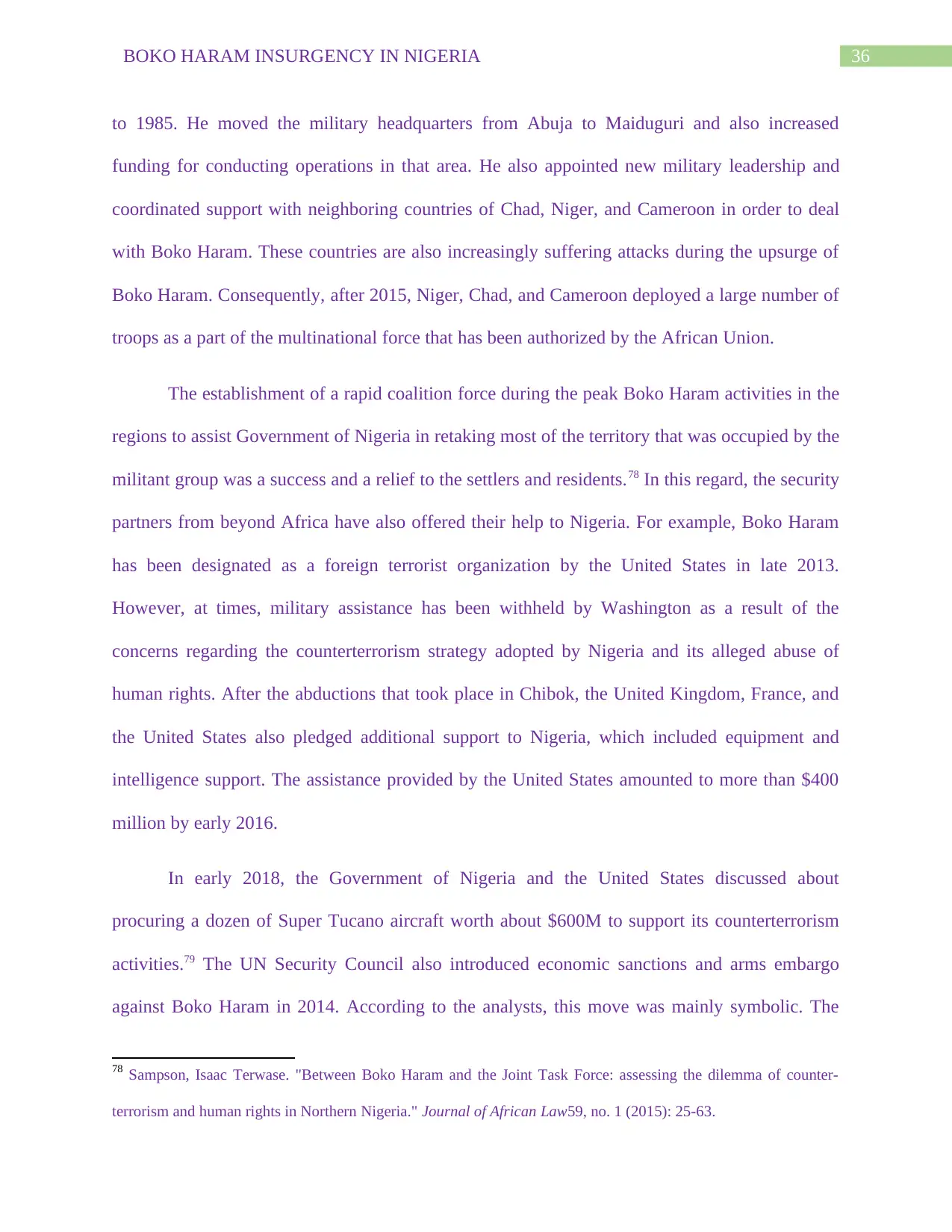
36BOKO HARAM INSURGENCY IN NIGERIA
to 1985. He moved the military headquarters from Abuja to Maiduguri and also increased
funding for conducting operations in that area. He also appointed new military leadership and
coordinated support with neighboring countries of Chad, Niger, and Cameroon in order to deal
with Boko Haram. These countries are also increasingly suffering attacks during the upsurge of
Boko Haram. Consequently, after 2015, Niger, Chad, and Cameroon deployed a large number of
troops as a part of the multinational force that has been authorized by the African Union.
The establishment of a rapid coalition force during the peak Boko Haram activities in the
regions to assist Government of Nigeria in retaking most of the territory that was occupied by the
militant group was a success and a relief to the settlers and residents.78 In this regard, the security
partners from beyond Africa have also offered their help to Nigeria. For example, Boko Haram
has been designated as a foreign terrorist organization by the United States in late 2013.
However, at times, military assistance has been withheld by Washington as a result of the
concerns regarding the counterterrorism strategy adopted by Nigeria and its alleged abuse of
human rights. After the abductions that took place in Chibok, the United Kingdom, France, and
the United States also pledged additional support to Nigeria, which included equipment and
intelligence support. The assistance provided by the United States amounted to more than $400
million by early 2016.
In early 2018, the Government of Nigeria and the United States discussed about
procuring a dozen of Super Tucano aircraft worth about $600M to support its counterterrorism
activities.79 The UN Security Council also introduced economic sanctions and arms embargo
against Boko Haram in 2014. According to the analysts, this move was mainly symbolic. The
78 Sampson, Isaac Terwase. "Between Boko Haram and the Joint Task Force: assessing the dilemma of counter-
terrorism and human rights in Northern Nigeria." Journal of African Law59, no. 1 (2015): 25-63.
to 1985. He moved the military headquarters from Abuja to Maiduguri and also increased
funding for conducting operations in that area. He also appointed new military leadership and
coordinated support with neighboring countries of Chad, Niger, and Cameroon in order to deal
with Boko Haram. These countries are also increasingly suffering attacks during the upsurge of
Boko Haram. Consequently, after 2015, Niger, Chad, and Cameroon deployed a large number of
troops as a part of the multinational force that has been authorized by the African Union.
The establishment of a rapid coalition force during the peak Boko Haram activities in the
regions to assist Government of Nigeria in retaking most of the territory that was occupied by the
militant group was a success and a relief to the settlers and residents.78 In this regard, the security
partners from beyond Africa have also offered their help to Nigeria. For example, Boko Haram
has been designated as a foreign terrorist organization by the United States in late 2013.
However, at times, military assistance has been withheld by Washington as a result of the
concerns regarding the counterterrorism strategy adopted by Nigeria and its alleged abuse of
human rights. After the abductions that took place in Chibok, the United Kingdom, France, and
the United States also pledged additional support to Nigeria, which included equipment and
intelligence support. The assistance provided by the United States amounted to more than $400
million by early 2016.
In early 2018, the Government of Nigeria and the United States discussed about
procuring a dozen of Super Tucano aircraft worth about $600M to support its counterterrorism
activities.79 The UN Security Council also introduced economic sanctions and arms embargo
against Boko Haram in 2014. According to the analysts, this move was mainly symbolic. The
78 Sampson, Isaac Terwase. "Between Boko Haram and the Joint Task Force: assessing the dilemma of counter-
terrorism and human rights in Northern Nigeria." Journal of African Law59, no. 1 (2015): 25-63.
Paraphrase This Document
Need a fresh take? Get an instant paraphrase of this document with our AI Paraphraser
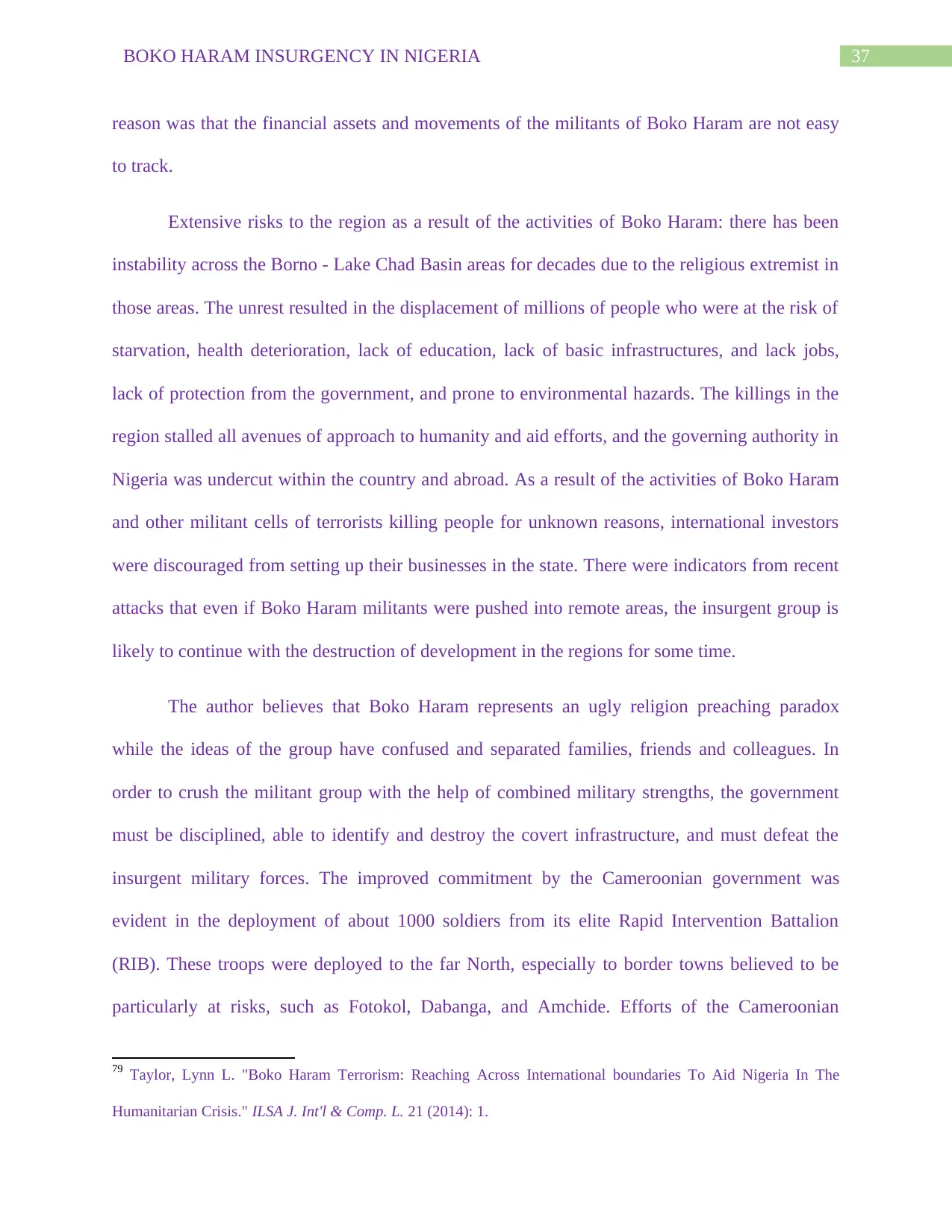
37BOKO HARAM INSURGENCY IN NIGERIA
reason was that the financial assets and movements of the militants of Boko Haram are not easy
to track.
Extensive risks to the region as a result of the activities of Boko Haram: there has been
instability across the Borno - Lake Chad Basin areas for decades due to the religious extremist in
those areas. The unrest resulted in the displacement of millions of people who were at the risk of
starvation, health deterioration, lack of education, lack of basic infrastructures, and lack jobs,
lack of protection from the government, and prone to environmental hazards. The killings in the
region stalled all avenues of approach to humanity and aid efforts, and the governing authority in
Nigeria was undercut within the country and abroad. As a result of the activities of Boko Haram
and other militant cells of terrorists killing people for unknown reasons, international investors
were discouraged from setting up their businesses in the state. There were indicators from recent
attacks that even if Boko Haram militants were pushed into remote areas, the insurgent group is
likely to continue with the destruction of development in the regions for some time.
The author believes that Boko Haram represents an ugly religion preaching paradox
while the ideas of the group have confused and separated families, friends and colleagues. In
order to crush the militant group with the help of combined military strengths, the government
must be disciplined, able to identify and destroy the covert infrastructure, and must defeat the
insurgent military forces. The improved commitment by the Cameroonian government was
evident in the deployment of about 1000 soldiers from its elite Rapid Intervention Battalion
(RIB). These troops were deployed to the far North, especially to border towns believed to be
particularly at risks, such as Fotokol, Dabanga, and Amchide. Efforts of the Cameroonian
79 Taylor, Lynn L. "Boko Haram Terrorism: Reaching Across International boundaries To Aid Nigeria In The
Humanitarian Crisis." ILSA J. Int'l & Comp. L. 21 (2014): 1.
reason was that the financial assets and movements of the militants of Boko Haram are not easy
to track.
Extensive risks to the region as a result of the activities of Boko Haram: there has been
instability across the Borno - Lake Chad Basin areas for decades due to the religious extremist in
those areas. The unrest resulted in the displacement of millions of people who were at the risk of
starvation, health deterioration, lack of education, lack of basic infrastructures, and lack jobs,
lack of protection from the government, and prone to environmental hazards. The killings in the
region stalled all avenues of approach to humanity and aid efforts, and the governing authority in
Nigeria was undercut within the country and abroad. As a result of the activities of Boko Haram
and other militant cells of terrorists killing people for unknown reasons, international investors
were discouraged from setting up their businesses in the state. There were indicators from recent
attacks that even if Boko Haram militants were pushed into remote areas, the insurgent group is
likely to continue with the destruction of development in the regions for some time.
The author believes that Boko Haram represents an ugly religion preaching paradox
while the ideas of the group have confused and separated families, friends and colleagues. In
order to crush the militant group with the help of combined military strengths, the government
must be disciplined, able to identify and destroy the covert infrastructure, and must defeat the
insurgent military forces. The improved commitment by the Cameroonian government was
evident in the deployment of about 1000 soldiers from its elite Rapid Intervention Battalion
(RIB). These troops were deployed to the far North, especially to border towns believed to be
particularly at risks, such as Fotokol, Dabanga, and Amchide. Efforts of the Cameroonian
79 Taylor, Lynn L. "Boko Haram Terrorism: Reaching Across International boundaries To Aid Nigeria In The
Humanitarian Crisis." ILSA J. Int'l & Comp. L. 21 (2014): 1.
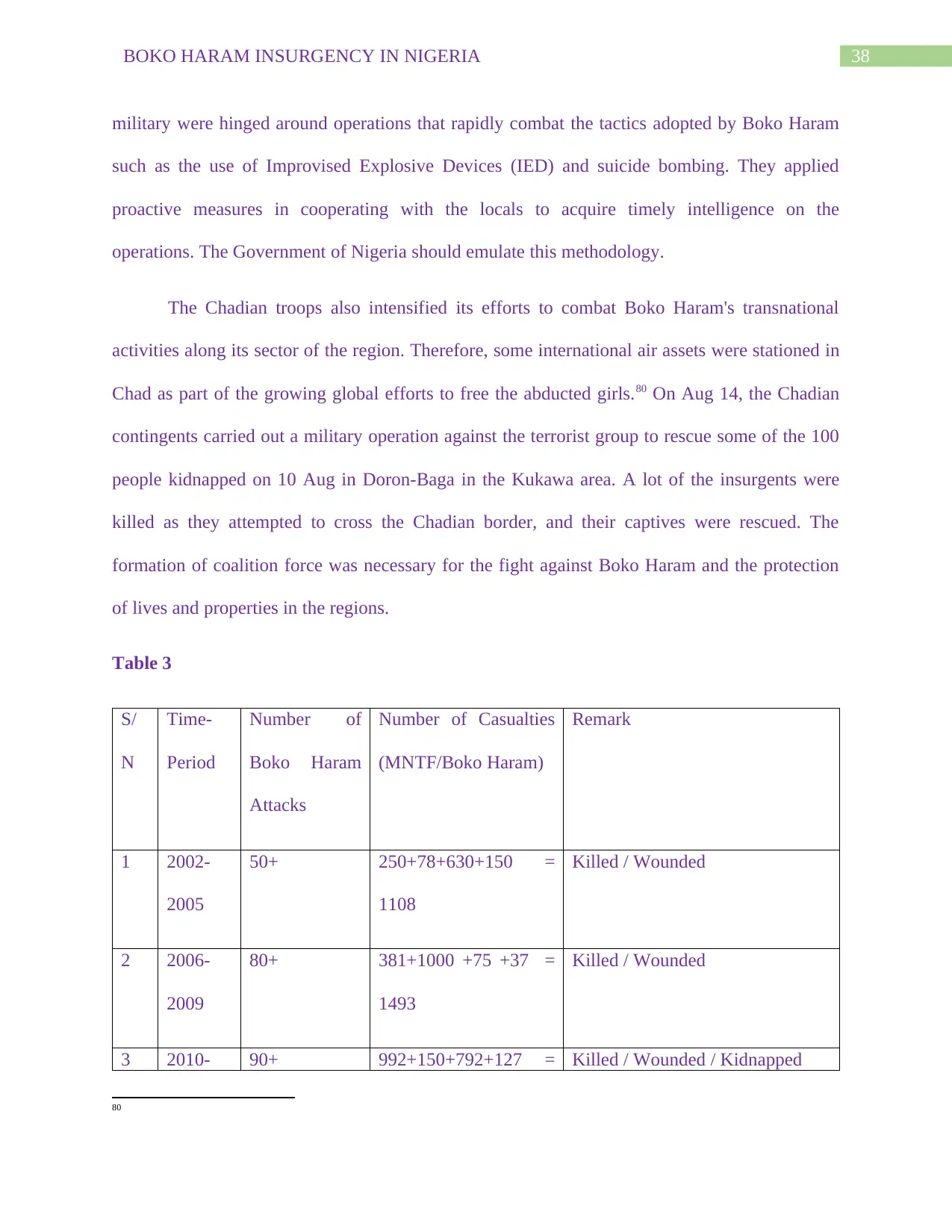
38BOKO HARAM INSURGENCY IN NIGERIA
military were hinged around operations that rapidly combat the tactics adopted by Boko Haram
such as the use of Improvised Explosive Devices (IED) and suicide bombing. They applied
proactive measures in cooperating with the locals to acquire timely intelligence on the
operations. The Government of Nigeria should emulate this methodology.
The Chadian troops also intensified its efforts to combat Boko Haram's transnational
activities along its sector of the region. Therefore, some international air assets were stationed in
Chad as part of the growing global efforts to free the abducted girls.80 On Aug 14, the Chadian
contingents carried out a military operation against the terrorist group to rescue some of the 100
people kidnapped on 10 Aug in Doron-Baga in the Kukawa area. A lot of the insurgents were
killed as they attempted to cross the Chadian border, and their captives were rescued. The
formation of coalition force was necessary for the fight against Boko Haram and the protection
of lives and properties in the regions.
Table 3
S/
N
Time-
Period
Number of
Boko Haram
Attacks
Number of Casualties
(MNTF/Boko Haram)
Remark
1 2002-
2005
50+ 250+78+630+150 =
1108
Killed / Wounded
2 2006-
2009
80+ 381+1000 +75 +37 =
1493
Killed / Wounded
3 2010- 90+ 992+150+792+127 = Killed / Wounded / Kidnapped
80
military were hinged around operations that rapidly combat the tactics adopted by Boko Haram
such as the use of Improvised Explosive Devices (IED) and suicide bombing. They applied
proactive measures in cooperating with the locals to acquire timely intelligence on the
operations. The Government of Nigeria should emulate this methodology.
The Chadian troops also intensified its efforts to combat Boko Haram's transnational
activities along its sector of the region. Therefore, some international air assets were stationed in
Chad as part of the growing global efforts to free the abducted girls.80 On Aug 14, the Chadian
contingents carried out a military operation against the terrorist group to rescue some of the 100
people kidnapped on 10 Aug in Doron-Baga in the Kukawa area. A lot of the insurgents were
killed as they attempted to cross the Chadian border, and their captives were rescued. The
formation of coalition force was necessary for the fight against Boko Haram and the protection
of lives and properties in the regions.
Table 3
S/
N
Time-
Period
Number of
Boko Haram
Attacks
Number of Casualties
(MNTF/Boko Haram)
Remark
1 2002-
2005
50+ 250+78+630+150 =
1108
Killed / Wounded
2 2006-
2009
80+ 381+1000 +75 +37 =
1493
Killed / Wounded
3 2010- 90+ 992+150+792+127 = Killed / Wounded / Kidnapped
80

39BOKO HARAM INSURGENCY IN NIGERIA
2013 2061
4 2014-
2017
300+ 910+967+2150 + 300
= 4327
Killed / Wounded /
Kidnapped/Arson/Hostages
5 2018-
2019
20+ 48+63 = 111 Killed/Wounded
Source: Created by the author
The coalition of the neighboring countries of Nigeria should facilitate the destruction of
the resources of Boko Haram by striking at their vulnerability and critical areas. The use of
accurate and detailed intelligence planning and proper execution of operations will enhance the
success of the coalition mission. Since accurate intelligence describes the operational
environment (OE) and the haven of Boko Haram as slaughter ground surrounded by landmines
IED, and foxholes everywhere, it will be imperative for the coalition to use air power and
airborne forces for operational reach to cover the assault in depth throughout the duration of
attack. There are no specific numbers of Boko Haram militants documented, but the Borno state
news estimated the number to approximately 20,000 to include loyalists, and sympathizers.
The Government of Nigeria wanted better intel on Boko Haram locations but did not
understand the task is much more difficult if population movement is not tightly controlled.
Population control presupposes a high degree of security within the controlled area. With
adequate control and security, those who are intimidated by the organization may feel confident
enough to aid in identifying insurgent agents. The Government of Nigeria needs the assistance of
the inter-agency security cooperation as it is imperative in the security management for the Boko
2013 2061
4 2014-
2017
300+ 910+967+2150 + 300
= 4327
Killed / Wounded /
Kidnapped/Arson/Hostages
5 2018-
2019
20+ 48+63 = 111 Killed/Wounded
Source: Created by the author
The coalition of the neighboring countries of Nigeria should facilitate the destruction of
the resources of Boko Haram by striking at their vulnerability and critical areas. The use of
accurate and detailed intelligence planning and proper execution of operations will enhance the
success of the coalition mission. Since accurate intelligence describes the operational
environment (OE) and the haven of Boko Haram as slaughter ground surrounded by landmines
IED, and foxholes everywhere, it will be imperative for the coalition to use air power and
airborne forces for operational reach to cover the assault in depth throughout the duration of
attack. There are no specific numbers of Boko Haram militants documented, but the Borno state
news estimated the number to approximately 20,000 to include loyalists, and sympathizers.
The Government of Nigeria wanted better intel on Boko Haram locations but did not
understand the task is much more difficult if population movement is not tightly controlled.
Population control presupposes a high degree of security within the controlled area. With
adequate control and security, those who are intimidated by the organization may feel confident
enough to aid in identifying insurgent agents. The Government of Nigeria needs the assistance of
the inter-agency security cooperation as it is imperative in the security management for the Boko
Secure Best Marks with AI Grader
Need help grading? Try our AI Grader for instant feedback on your assignments.
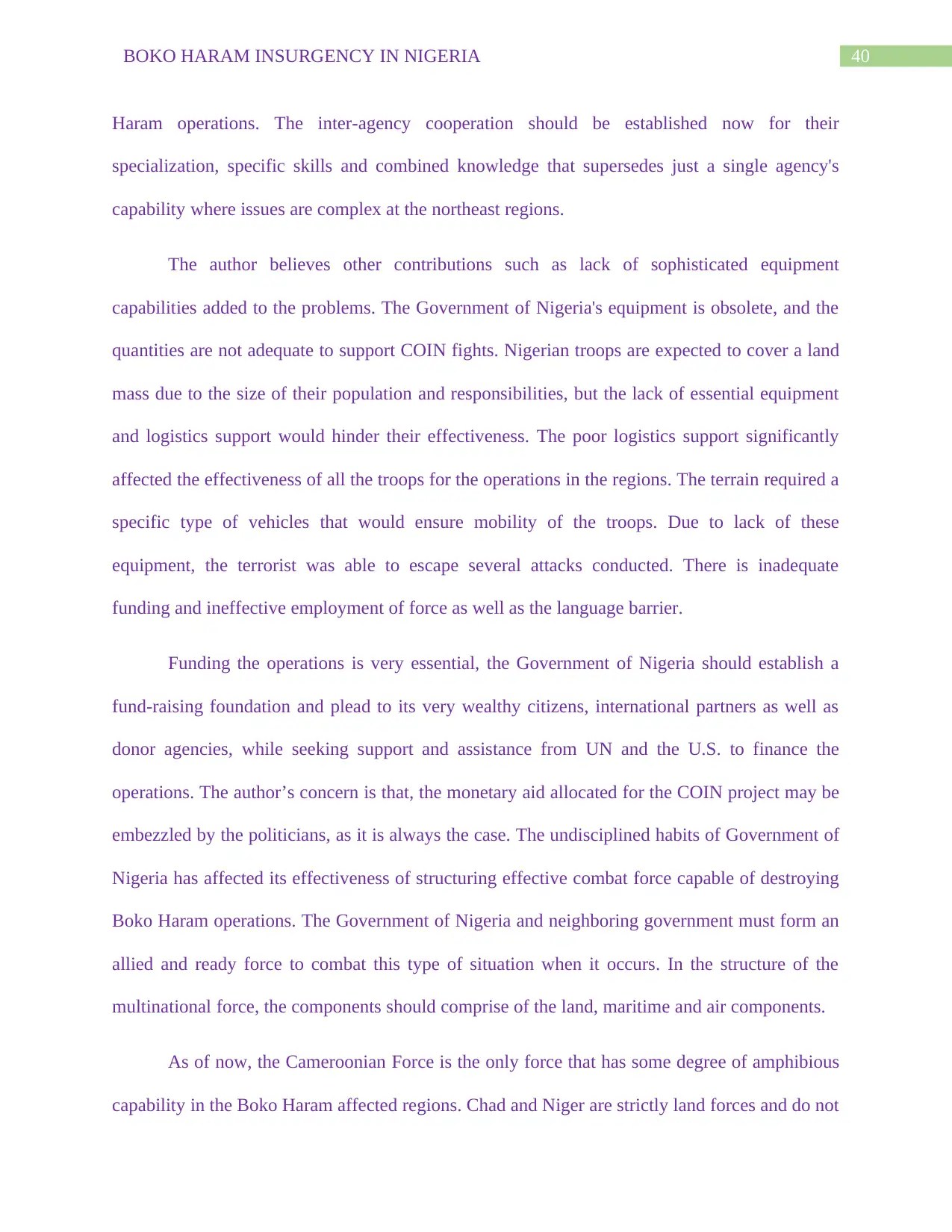
40BOKO HARAM INSURGENCY IN NIGERIA
Haram operations. The inter-agency cooperation should be established now for their
specialization, specific skills and combined knowledge that supersedes just a single agency's
capability where issues are complex at the northeast regions.
The author believes other contributions such as lack of sophisticated equipment
capabilities added to the problems. The Government of Nigeria's equipment is obsolete, and the
quantities are not adequate to support COIN fights. Nigerian troops are expected to cover a land
mass due to the size of their population and responsibilities, but the lack of essential equipment
and logistics support would hinder their effectiveness. The poor logistics support significantly
affected the effectiveness of all the troops for the operations in the regions. The terrain required a
specific type of vehicles that would ensure mobility of the troops. Due to lack of these
equipment, the terrorist was able to escape several attacks conducted. There is inadequate
funding and ineffective employment of force as well as the language barrier.
Funding the operations is very essential, the Government of Nigeria should establish a
fund-raising foundation and plead to its very wealthy citizens, international partners as well as
donor agencies, while seeking support and assistance from UN and the U.S. to finance the
operations. The author’s concern is that, the monetary aid allocated for the COIN project may be
embezzled by the politicians, as it is always the case. The undisciplined habits of Government of
Nigeria has affected its effectiveness of structuring effective combat force capable of destroying
Boko Haram operations. The Government of Nigeria and neighboring government must form an
allied and ready force to combat this type of situation when it occurs. In the structure of the
multinational force, the components should comprise of the land, maritime and air components.
As of now, the Cameroonian Force is the only force that has some degree of amphibious
capability in the Boko Haram affected regions. Chad and Niger are strictly land forces and do not
Haram operations. The inter-agency cooperation should be established now for their
specialization, specific skills and combined knowledge that supersedes just a single agency's
capability where issues are complex at the northeast regions.
The author believes other contributions such as lack of sophisticated equipment
capabilities added to the problems. The Government of Nigeria's equipment is obsolete, and the
quantities are not adequate to support COIN fights. Nigerian troops are expected to cover a land
mass due to the size of their population and responsibilities, but the lack of essential equipment
and logistics support would hinder their effectiveness. The poor logistics support significantly
affected the effectiveness of all the troops for the operations in the regions. The terrain required a
specific type of vehicles that would ensure mobility of the troops. Due to lack of these
equipment, the terrorist was able to escape several attacks conducted. There is inadequate
funding and ineffective employment of force as well as the language barrier.
Funding the operations is very essential, the Government of Nigeria should establish a
fund-raising foundation and plead to its very wealthy citizens, international partners as well as
donor agencies, while seeking support and assistance from UN and the U.S. to finance the
operations. The author’s concern is that, the monetary aid allocated for the COIN project may be
embezzled by the politicians, as it is always the case. The undisciplined habits of Government of
Nigeria has affected its effectiveness of structuring effective combat force capable of destroying
Boko Haram operations. The Government of Nigeria and neighboring government must form an
allied and ready force to combat this type of situation when it occurs. In the structure of the
multinational force, the components should comprise of the land, maritime and air components.
As of now, the Cameroonian Force is the only force that has some degree of amphibious
capability in the Boko Haram affected regions. Chad and Niger are strictly land forces and do not

41BOKO HARAM INSURGENCY IN NIGERIA
have amphibious operations while Nigeria did not deploy its amphibious operations. Similarly,
there is no constant air raid or designated force dedicated to the air raid. The Government of
Nigeria and neighboring force only receive air support as needed by foreign aid.
The issue of differences in the language of the troops in the region may become a
problem that will affect the conduct of its operations in the regions. Apart from Nigeria
(anglophone), all other countries are French-speaking (francophone) countries, and the enemy
speaks English and Arabic. This situation can prevent active command and control. The
language barriers could cause unnecessary delays in the execution of orders. The Government of
Nigeria and its neighbouring countries must ensure they have an agreement to conduct cross
border operations by each affected neighbouring state. This provision must be fully complied
with, as of 2019, only Government of Nigeria permits other nations to cross conduct operations
against Boko Haram terrorists within Nigeria territory.
The presence of distrust and conflict of jurisdiction sometimes allows members of the
terrorist cells to escape arrest by the security forces. Thus, any disagreement among the
government of the affected nations would affect the synergy of the troops in combating the Boko
Haram terrorists.
Summary
In summary, this chapter has analyzed Boko Haram operations and the effect it has on the
people of Borno state, and neighboring countries that jointly shares northeast borders of Nigeria,
and to show how security of the regions has deteriorated so quickly. It also acknowledges the
efforts of Government of Nigeria (GON) and its counterparts Government of Cameroon (GOC),
have amphibious operations while Nigeria did not deploy its amphibious operations. Similarly,
there is no constant air raid or designated force dedicated to the air raid. The Government of
Nigeria and neighboring force only receive air support as needed by foreign aid.
The issue of differences in the language of the troops in the region may become a
problem that will affect the conduct of its operations in the regions. Apart from Nigeria
(anglophone), all other countries are French-speaking (francophone) countries, and the enemy
speaks English and Arabic. This situation can prevent active command and control. The
language barriers could cause unnecessary delays in the execution of orders. The Government of
Nigeria and its neighbouring countries must ensure they have an agreement to conduct cross
border operations by each affected neighbouring state. This provision must be fully complied
with, as of 2019, only Government of Nigeria permits other nations to cross conduct operations
against Boko Haram terrorists within Nigeria territory.
The presence of distrust and conflict of jurisdiction sometimes allows members of the
terrorist cells to escape arrest by the security forces. Thus, any disagreement among the
government of the affected nations would affect the synergy of the troops in combating the Boko
Haram terrorists.
Summary
In summary, this chapter has analyzed Boko Haram operations and the effect it has on the
people of Borno state, and neighboring countries that jointly shares northeast borders of Nigeria,
and to show how security of the regions has deteriorated so quickly. It also acknowledges the
efforts of Government of Nigeria (GON) and its counterparts Government of Cameroon (GOC),
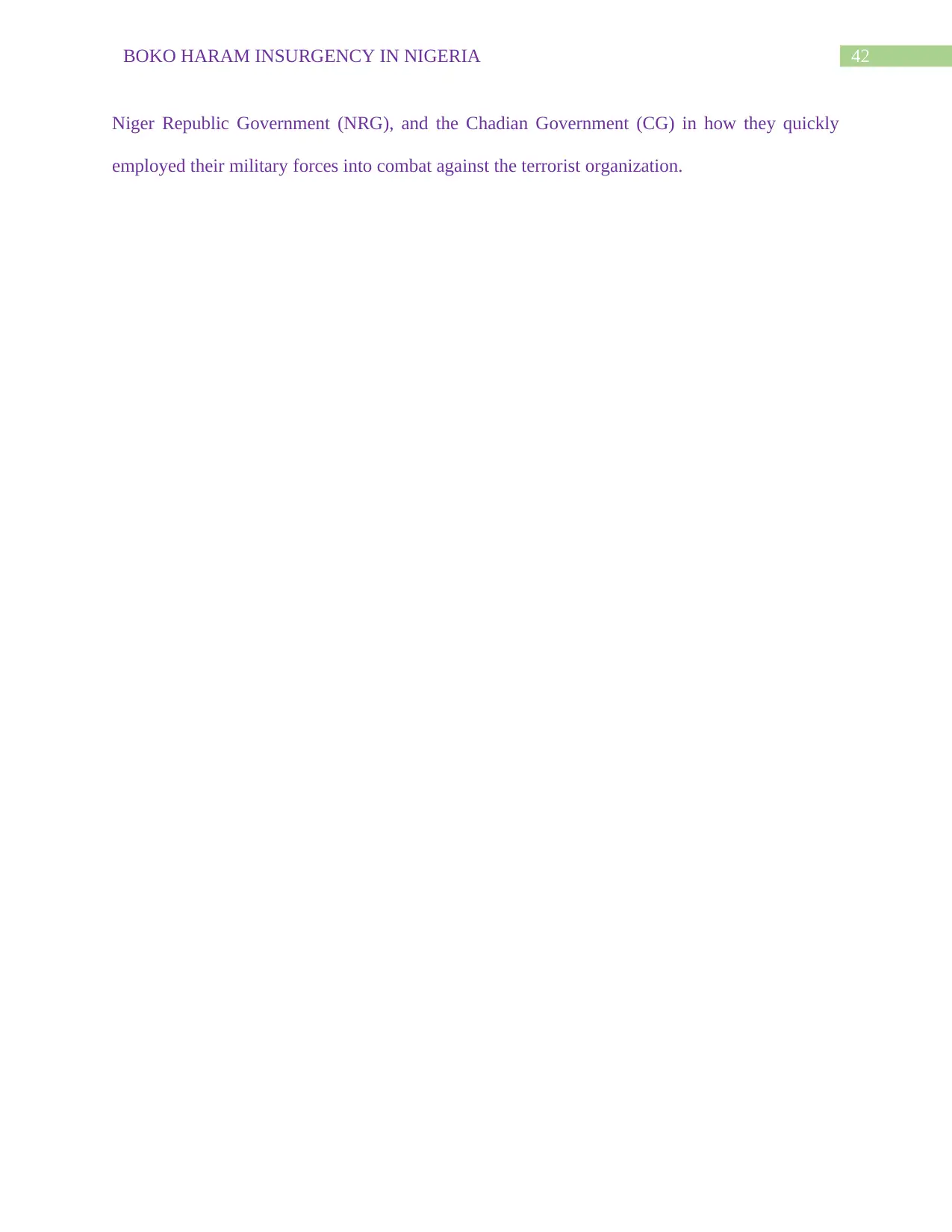
42BOKO HARAM INSURGENCY IN NIGERIA
Niger Republic Government (NRG), and the Chadian Government (CG) in how they quickly
employed their military forces into combat against the terrorist organization.
Niger Republic Government (NRG), and the Chadian Government (CG) in how they quickly
employed their military forces into combat against the terrorist organization.
Paraphrase This Document
Need a fresh take? Get an instant paraphrase of this document with our AI Paraphraser
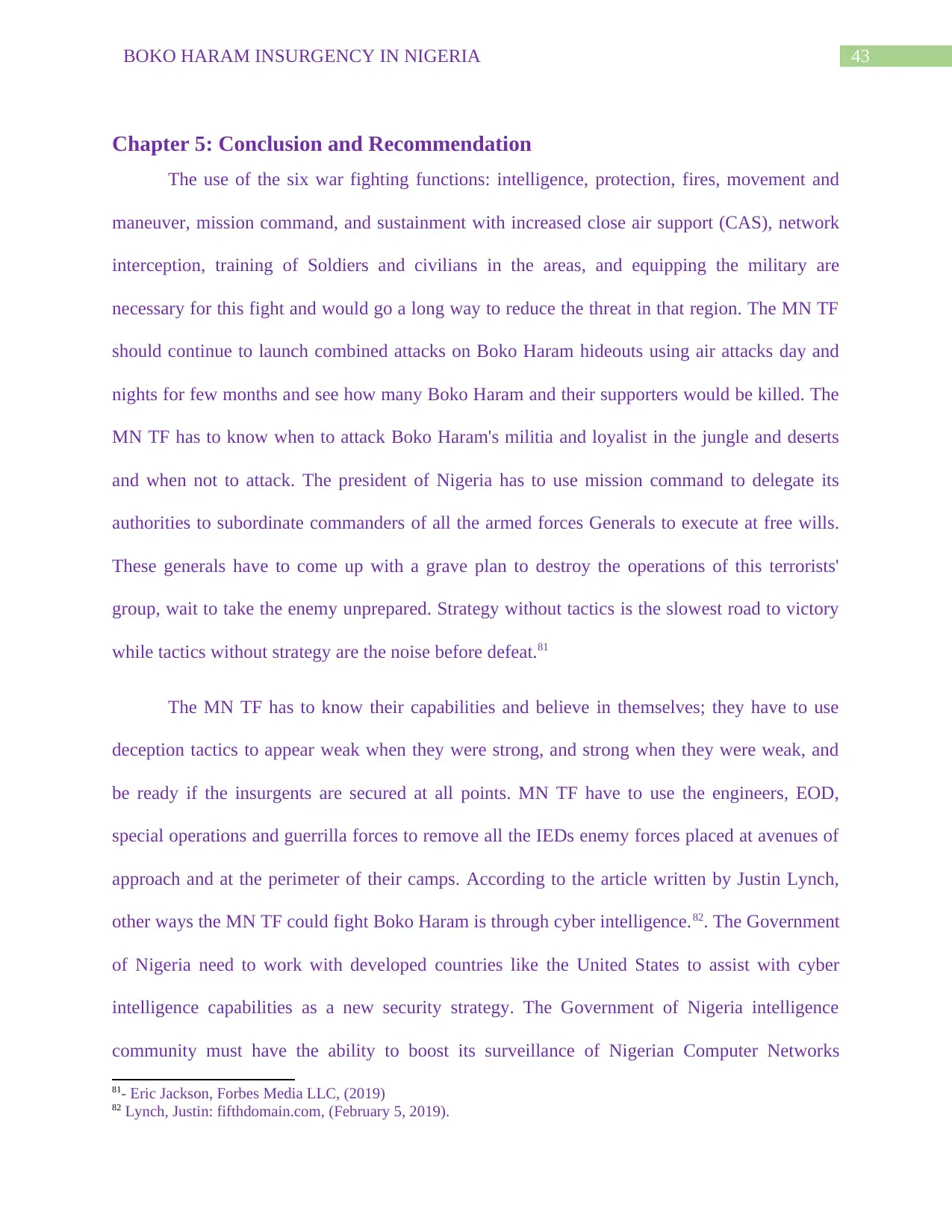
43BOKO HARAM INSURGENCY IN NIGERIA
Chapter 5: Conclusion and Recommendation
The use of the six war fighting functions: intelligence, protection, fires, movement and
maneuver, mission command, and sustainment with increased close air support (CAS), network
interception, training of Soldiers and civilians in the areas, and equipping the military are
necessary for this fight and would go a long way to reduce the threat in that region. The MN TF
should continue to launch combined attacks on Boko Haram hideouts using air attacks day and
nights for few months and see how many Boko Haram and their supporters would be killed. The
MN TF has to know when to attack Boko Haram's militia and loyalist in the jungle and deserts
and when not to attack. The president of Nigeria has to use mission command to delegate its
authorities to subordinate commanders of all the armed forces Generals to execute at free wills.
These generals have to come up with a grave plan to destroy the operations of this terrorists'
group, wait to take the enemy unprepared. Strategy without tactics is the slowest road to victory
while tactics without strategy are the noise before defeat.81
The MN TF has to know their capabilities and believe in themselves; they have to use
deception tactics to appear weak when they were strong, and strong when they were weak, and
be ready if the insurgents are secured at all points. MN TF have to use the engineers, EOD,
special operations and guerrilla forces to remove all the IEDs enemy forces placed at avenues of
approach and at the perimeter of their camps. According to the article written by Justin Lynch,
other ways the MN TF could fight Boko Haram is through cyber intelligence.82. The Government
of Nigeria need to work with developed countries like the United States to assist with cyber
intelligence capabilities as a new security strategy. The Government of Nigeria intelligence
community must have the ability to boost its surveillance of Nigerian Computer Networks
81- Eric Jackson, Forbes Media LLC, (2019)
82 Lynch, Justin: fifthdomain.com, (February 5, 2019).
Chapter 5: Conclusion and Recommendation
The use of the six war fighting functions: intelligence, protection, fires, movement and
maneuver, mission command, and sustainment with increased close air support (CAS), network
interception, training of Soldiers and civilians in the areas, and equipping the military are
necessary for this fight and would go a long way to reduce the threat in that region. The MN TF
should continue to launch combined attacks on Boko Haram hideouts using air attacks day and
nights for few months and see how many Boko Haram and their supporters would be killed. The
MN TF has to know when to attack Boko Haram's militia and loyalist in the jungle and deserts
and when not to attack. The president of Nigeria has to use mission command to delegate its
authorities to subordinate commanders of all the armed forces Generals to execute at free wills.
These generals have to come up with a grave plan to destroy the operations of this terrorists'
group, wait to take the enemy unprepared. Strategy without tactics is the slowest road to victory
while tactics without strategy are the noise before defeat.81
The MN TF has to know their capabilities and believe in themselves; they have to use
deception tactics to appear weak when they were strong, and strong when they were weak, and
be ready if the insurgents are secured at all points. MN TF have to use the engineers, EOD,
special operations and guerrilla forces to remove all the IEDs enemy forces placed at avenues of
approach and at the perimeter of their camps. According to the article written by Justin Lynch,
other ways the MN TF could fight Boko Haram is through cyber intelligence.82. The Government
of Nigeria need to work with developed countries like the United States to assist with cyber
intelligence capabilities as a new security strategy. The Government of Nigeria intelligence
community must have the ability to boost its surveillance of Nigerian Computer Networks
81- Eric Jackson, Forbes Media LLC, (2019)
82 Lynch, Justin: fifthdomain.com, (February 5, 2019).
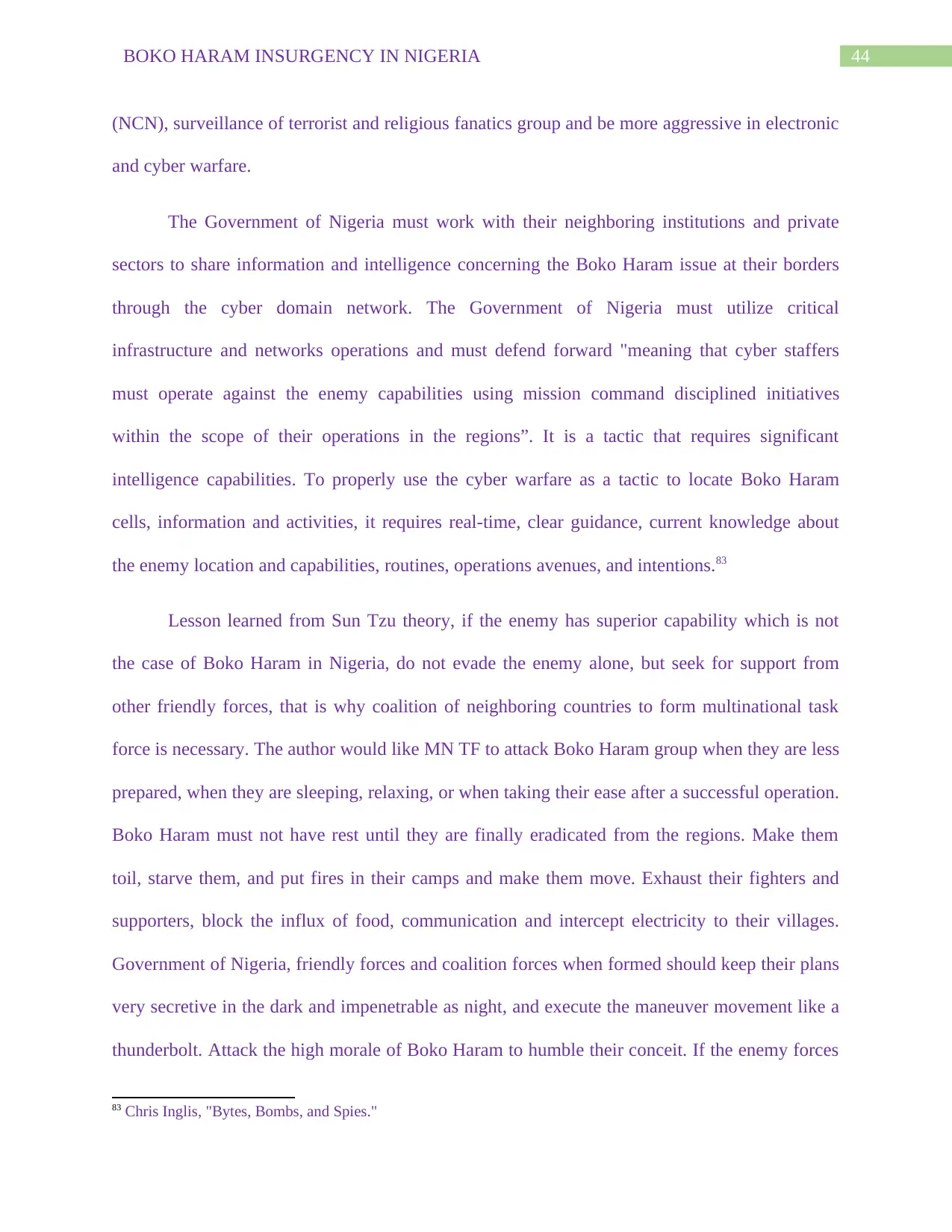
44BOKO HARAM INSURGENCY IN NIGERIA
(NCN), surveillance of terrorist and religious fanatics group and be more aggressive in electronic
and cyber warfare.
The Government of Nigeria must work with their neighboring institutions and private
sectors to share information and intelligence concerning the Boko Haram issue at their borders
through the cyber domain network. The Government of Nigeria must utilize critical
infrastructure and networks operations and must defend forward "meaning that cyber staffers
must operate against the enemy capabilities using mission command disciplined initiatives
within the scope of their operations in the regions”. It is a tactic that requires significant
intelligence capabilities. To properly use the cyber warfare as a tactic to locate Boko Haram
cells, information and activities, it requires real-time, clear guidance, current knowledge about
the enemy location and capabilities, routines, operations avenues, and intentions.83
Lesson learned from Sun Tzu theory, if the enemy has superior capability which is not
the case of Boko Haram in Nigeria, do not evade the enemy alone, but seek for support from
other friendly forces, that is why coalition of neighboring countries to form multinational task
force is necessary. The author would like MN TF to attack Boko Haram group when they are less
prepared, when they are sleeping, relaxing, or when taking their ease after a successful operation.
Boko Haram must not have rest until they are finally eradicated from the regions. Make them
toil, starve them, and put fires in their camps and make them move. Exhaust their fighters and
supporters, block the influx of food, communication and intercept electricity to their villages.
Government of Nigeria, friendly forces and coalition forces when formed should keep their plans
very secretive in the dark and impenetrable as night, and execute the maneuver movement like a
thunderbolt. Attack the high morale of Boko Haram to humble their conceit. If the enemy forces
83 Chris Inglis, "Bytes, Bombs, and Spies."
(NCN), surveillance of terrorist and religious fanatics group and be more aggressive in electronic
and cyber warfare.
The Government of Nigeria must work with their neighboring institutions and private
sectors to share information and intelligence concerning the Boko Haram issue at their borders
through the cyber domain network. The Government of Nigeria must utilize critical
infrastructure and networks operations and must defend forward "meaning that cyber staffers
must operate against the enemy capabilities using mission command disciplined initiatives
within the scope of their operations in the regions”. It is a tactic that requires significant
intelligence capabilities. To properly use the cyber warfare as a tactic to locate Boko Haram
cells, information and activities, it requires real-time, clear guidance, current knowledge about
the enemy location and capabilities, routines, operations avenues, and intentions.83
Lesson learned from Sun Tzu theory, if the enemy has superior capability which is not
the case of Boko Haram in Nigeria, do not evade the enemy alone, but seek for support from
other friendly forces, that is why coalition of neighboring countries to form multinational task
force is necessary. The author would like MN TF to attack Boko Haram group when they are less
prepared, when they are sleeping, relaxing, or when taking their ease after a successful operation.
Boko Haram must not have rest until they are finally eradicated from the regions. Make them
toil, starve them, and put fires in their camps and make them move. Exhaust their fighters and
supporters, block the influx of food, communication and intercept electricity to their villages.
Government of Nigeria, friendly forces and coalition forces when formed should keep their plans
very secretive in the dark and impenetrable as night, and execute the maneuver movement like a
thunderbolt. Attack the high morale of Boko Haram to humble their conceit. If the enemy forces
83 Chris Inglis, "Bytes, Bombs, and Spies."
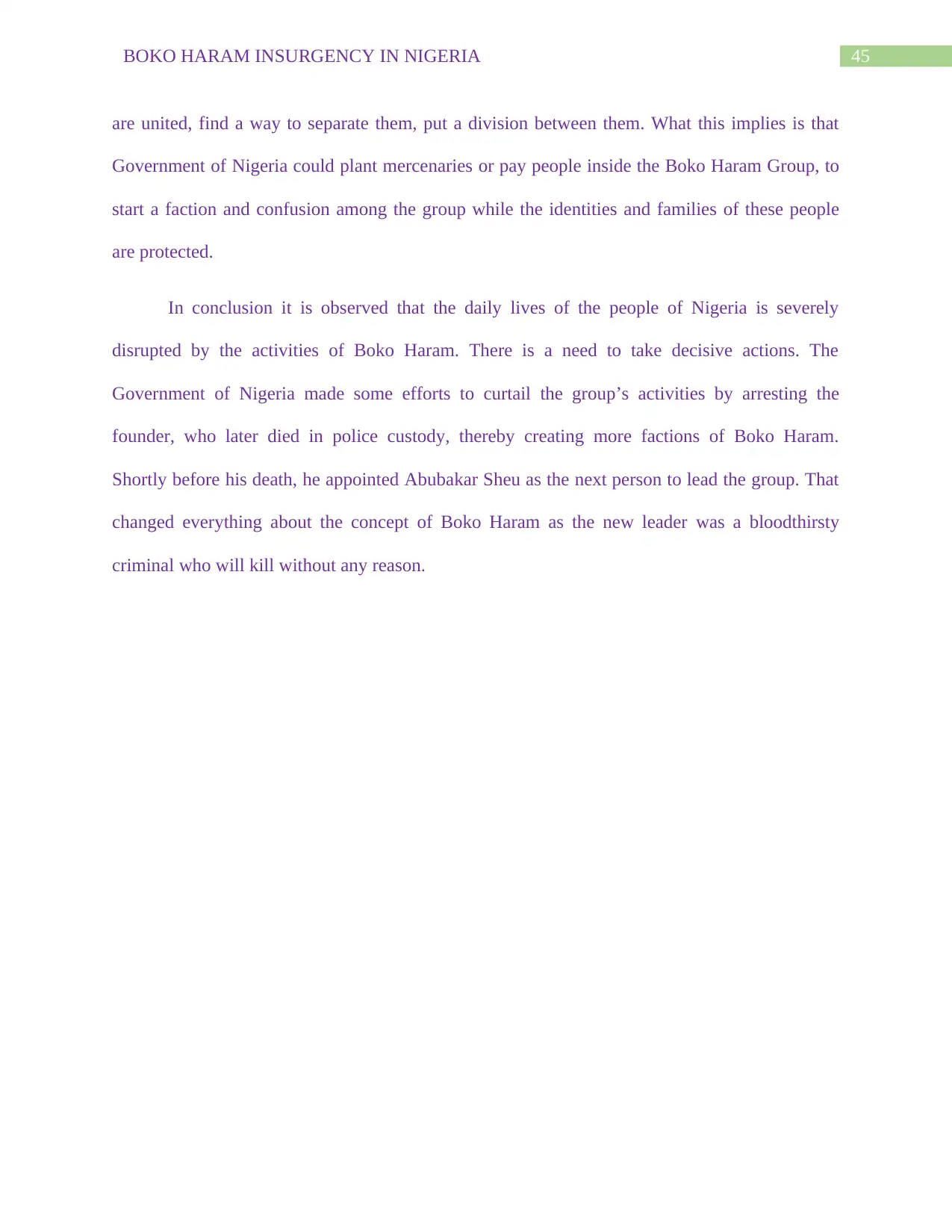
45BOKO HARAM INSURGENCY IN NIGERIA
are united, find a way to separate them, put a division between them. What this implies is that
Government of Nigeria could plant mercenaries or pay people inside the Boko Haram Group, to
start a faction and confusion among the group while the identities and families of these people
are protected.
In conclusion it is observed that the daily lives of the people of Nigeria is severely
disrupted by the activities of Boko Haram. There is a need to take decisive actions. The
Government of Nigeria made some efforts to curtail the group’s activities by arresting the
founder, who later died in police custody, thereby creating more factions of Boko Haram.
Shortly before his death, he appointed Abubakar Sheu as the next person to lead the group. That
changed everything about the concept of Boko Haram as the new leader was a bloodthirsty
criminal who will kill without any reason.
are united, find a way to separate them, put a division between them. What this implies is that
Government of Nigeria could plant mercenaries or pay people inside the Boko Haram Group, to
start a faction and confusion among the group while the identities and families of these people
are protected.
In conclusion it is observed that the daily lives of the people of Nigeria is severely
disrupted by the activities of Boko Haram. There is a need to take decisive actions. The
Government of Nigeria made some efforts to curtail the group’s activities by arresting the
founder, who later died in police custody, thereby creating more factions of Boko Haram.
Shortly before his death, he appointed Abubakar Sheu as the next person to lead the group. That
changed everything about the concept of Boko Haram as the new leader was a bloodthirsty
criminal who will kill without any reason.
Secure Best Marks with AI Grader
Need help grading? Try our AI Grader for instant feedback on your assignments.
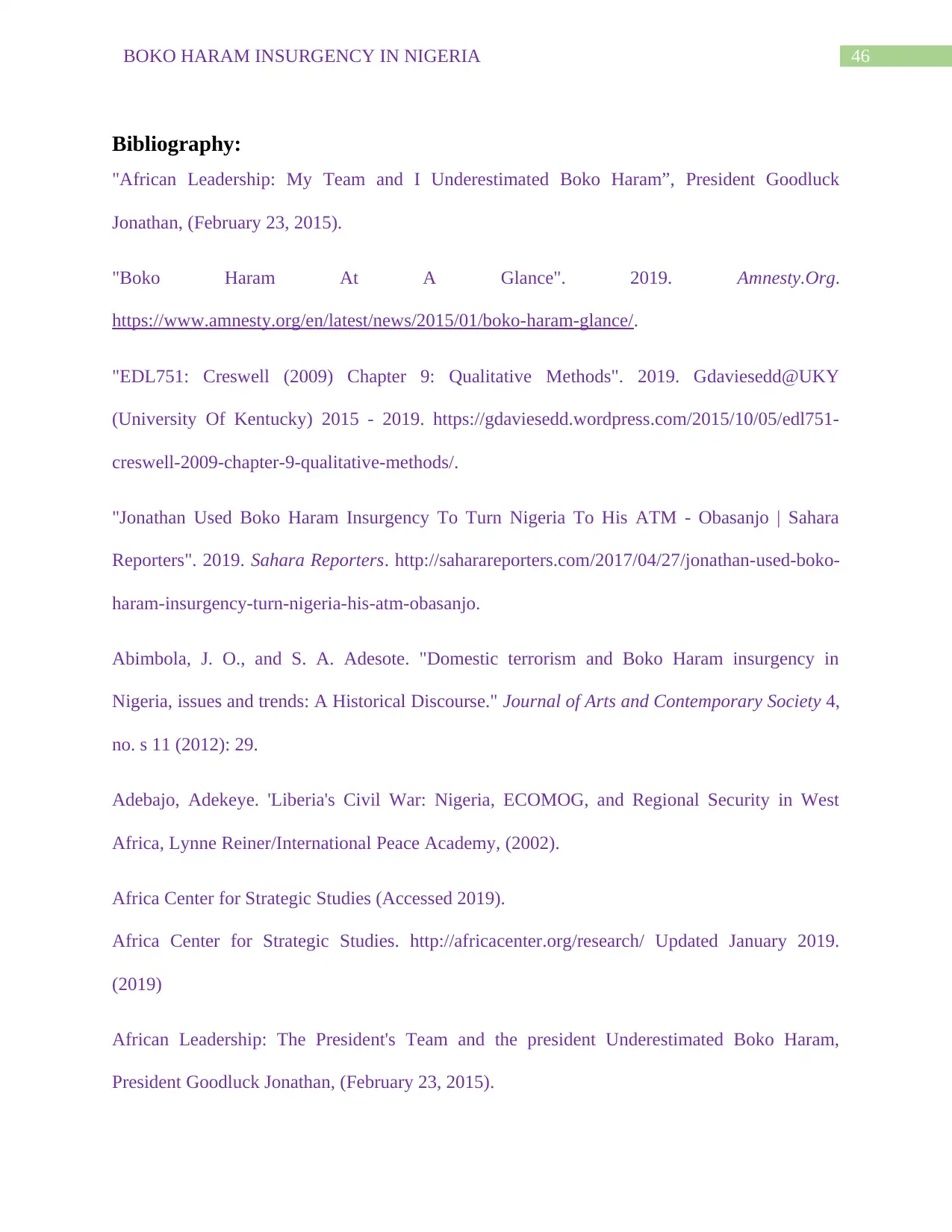
46BOKO HARAM INSURGENCY IN NIGERIA
Bibliography:
"African Leadership: My Team and I Underestimated Boko Haram”, President Goodluck
Jonathan, (February 23, 2015).
"Boko Haram At A Glance". 2019. Amnesty.Org.
https://www.amnesty.org/en/latest/news/2015/01/boko-haram-glance/.
"EDL751: Creswell (2009) Chapter 9: Qualitative Methods". 2019. Gdaviesedd@UKY
(University Of Kentucky) 2015 - 2019. https://gdaviesedd.wordpress.com/2015/10/05/edl751-
creswell-2009-chapter-9-qualitative-methods/.
"Jonathan Used Boko Haram Insurgency To Turn Nigeria To His ATM - Obasanjo | Sahara
Reporters". 2019. Sahara Reporters. http://saharareporters.com/2017/04/27/jonathan-used-boko-
haram-insurgency-turn-nigeria-his-atm-obasanjo.
Abimbola, J. O., and S. A. Adesote. "Domestic terrorism and Boko Haram insurgency in
Nigeria, issues and trends: A Historical Discourse." Journal of Arts and Contemporary Society 4,
no. s 11 (2012): 29.
Adebajo, Adekeye. 'Liberia's Civil War: Nigeria, ECOMOG, and Regional Security in West
Africa, Lynne Reiner/International Peace Academy, (2002).
Africa Center for Strategic Studies (Accessed 2019).
Africa Center for Strategic Studies. http://africacenter.org/research/ Updated January 2019.
(2019)
African Leadership: The President's Team and the president Underestimated Boko Haram,
President Goodluck Jonathan, (February 23, 2015).
Bibliography:
"African Leadership: My Team and I Underestimated Boko Haram”, President Goodluck
Jonathan, (February 23, 2015).
"Boko Haram At A Glance". 2019. Amnesty.Org.
https://www.amnesty.org/en/latest/news/2015/01/boko-haram-glance/.
"EDL751: Creswell (2009) Chapter 9: Qualitative Methods". 2019. Gdaviesedd@UKY
(University Of Kentucky) 2015 - 2019. https://gdaviesedd.wordpress.com/2015/10/05/edl751-
creswell-2009-chapter-9-qualitative-methods/.
"Jonathan Used Boko Haram Insurgency To Turn Nigeria To His ATM - Obasanjo | Sahara
Reporters". 2019. Sahara Reporters. http://saharareporters.com/2017/04/27/jonathan-used-boko-
haram-insurgency-turn-nigeria-his-atm-obasanjo.
Abimbola, J. O., and S. A. Adesote. "Domestic terrorism and Boko Haram insurgency in
Nigeria, issues and trends: A Historical Discourse." Journal of Arts and Contemporary Society 4,
no. s 11 (2012): 29.
Adebajo, Adekeye. 'Liberia's Civil War: Nigeria, ECOMOG, and Regional Security in West
Africa, Lynne Reiner/International Peace Academy, (2002).
Africa Center for Strategic Studies (Accessed 2019).
Africa Center for Strategic Studies. http://africacenter.org/research/ Updated January 2019.
(2019)
African Leadership: The President's Team and the president Underestimated Boko Haram,
President Goodluck Jonathan, (February 23, 2015).
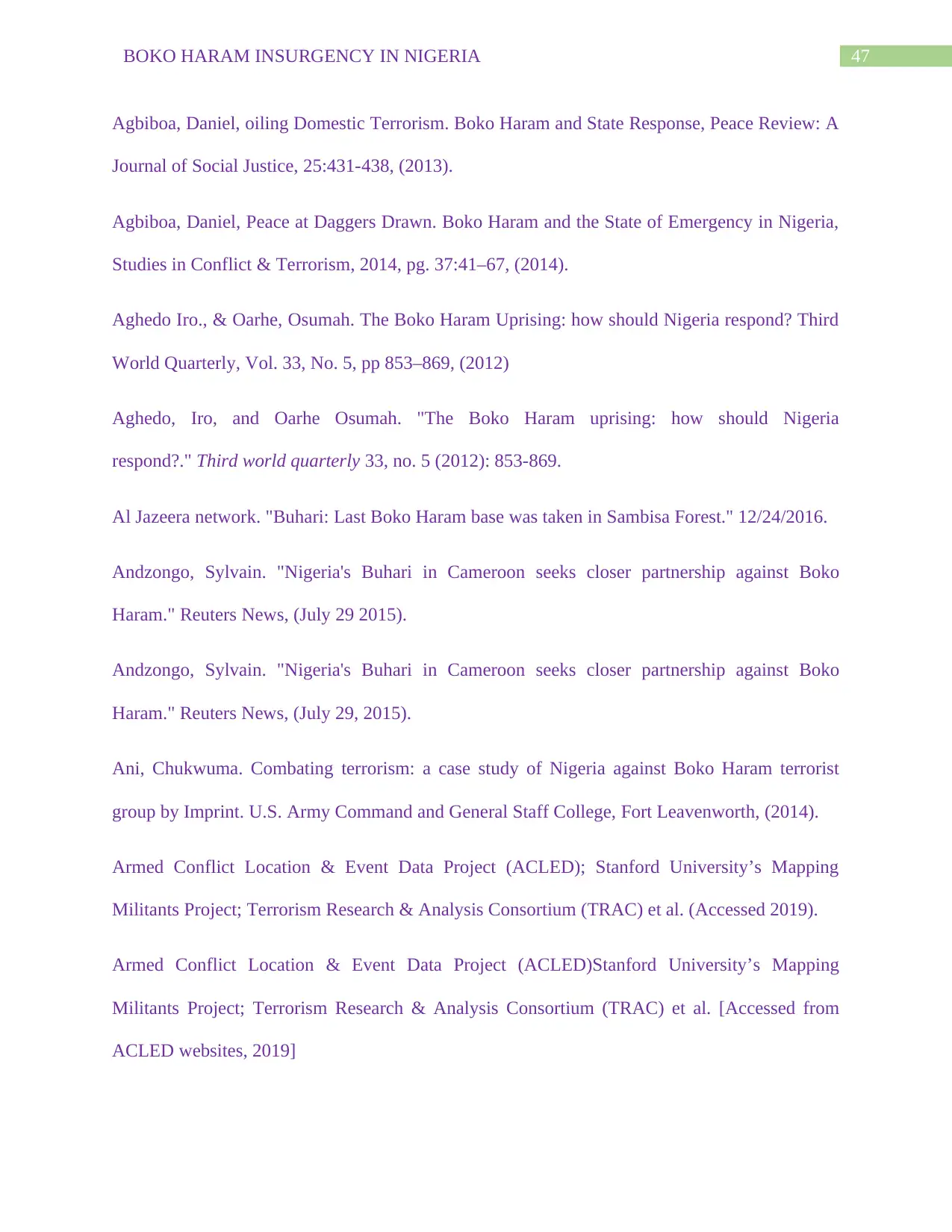
47BOKO HARAM INSURGENCY IN NIGERIA
Agbiboa, Daniel, oiling Domestic Terrorism. Boko Haram and State Response, Peace Review: A
Journal of Social Justice, 25:431-438, (2013).
Agbiboa, Daniel, Peace at Daggers Drawn. Boko Haram and the State of Emergency in Nigeria,
Studies in Conflict & Terrorism, 2014, pg. 37:41–67, (2014).
Aghedo Iro., & Oarhe, Osumah. The Boko Haram Uprising: how should Nigeria respond? Third
World Quarterly, Vol. 33, No. 5, pp 853–869, (2012)
Aghedo, Iro, and Oarhe Osumah. "The Boko Haram uprising: how should Nigeria
respond?." Third world quarterly 33, no. 5 (2012): 853-869.
Al Jazeera network. "Buhari: Last Boko Haram base was taken in Sambisa Forest." 12/24/2016.
Andzongo, Sylvain. "Nigeria's Buhari in Cameroon seeks closer partnership against Boko
Haram." Reuters News, (July 29 2015).
Andzongo, Sylvain. "Nigeria's Buhari in Cameroon seeks closer partnership against Boko
Haram." Reuters News, (July 29, 2015).
Ani, Chukwuma. Combating terrorism: a case study of Nigeria against Boko Haram terrorist
group by Imprint. U.S. Army Command and General Staff College, Fort Leavenworth, (2014).
Armed Conflict Location & Event Data Project (ACLED); Stanford University’s Mapping
Militants Project; Terrorism Research & Analysis Consortium (TRAC) et al. (Accessed 2019).
Armed Conflict Location & Event Data Project (ACLED)Stanford University’s Mapping
Militants Project; Terrorism Research & Analysis Consortium (TRAC) et al. [Accessed from
ACLED websites, 2019]
Agbiboa, Daniel, oiling Domestic Terrorism. Boko Haram and State Response, Peace Review: A
Journal of Social Justice, 25:431-438, (2013).
Agbiboa, Daniel, Peace at Daggers Drawn. Boko Haram and the State of Emergency in Nigeria,
Studies in Conflict & Terrorism, 2014, pg. 37:41–67, (2014).
Aghedo Iro., & Oarhe, Osumah. The Boko Haram Uprising: how should Nigeria respond? Third
World Quarterly, Vol. 33, No. 5, pp 853–869, (2012)
Aghedo, Iro, and Oarhe Osumah. "The Boko Haram uprising: how should Nigeria
respond?." Third world quarterly 33, no. 5 (2012): 853-869.
Al Jazeera network. "Buhari: Last Boko Haram base was taken in Sambisa Forest." 12/24/2016.
Andzongo, Sylvain. "Nigeria's Buhari in Cameroon seeks closer partnership against Boko
Haram." Reuters News, (July 29 2015).
Andzongo, Sylvain. "Nigeria's Buhari in Cameroon seeks closer partnership against Boko
Haram." Reuters News, (July 29, 2015).
Ani, Chukwuma. Combating terrorism: a case study of Nigeria against Boko Haram terrorist
group by Imprint. U.S. Army Command and General Staff College, Fort Leavenworth, (2014).
Armed Conflict Location & Event Data Project (ACLED); Stanford University’s Mapping
Militants Project; Terrorism Research & Analysis Consortium (TRAC) et al. (Accessed 2019).
Armed Conflict Location & Event Data Project (ACLED)Stanford University’s Mapping
Militants Project; Terrorism Research & Analysis Consortium (TRAC) et al. [Accessed from
ACLED websites, 2019]
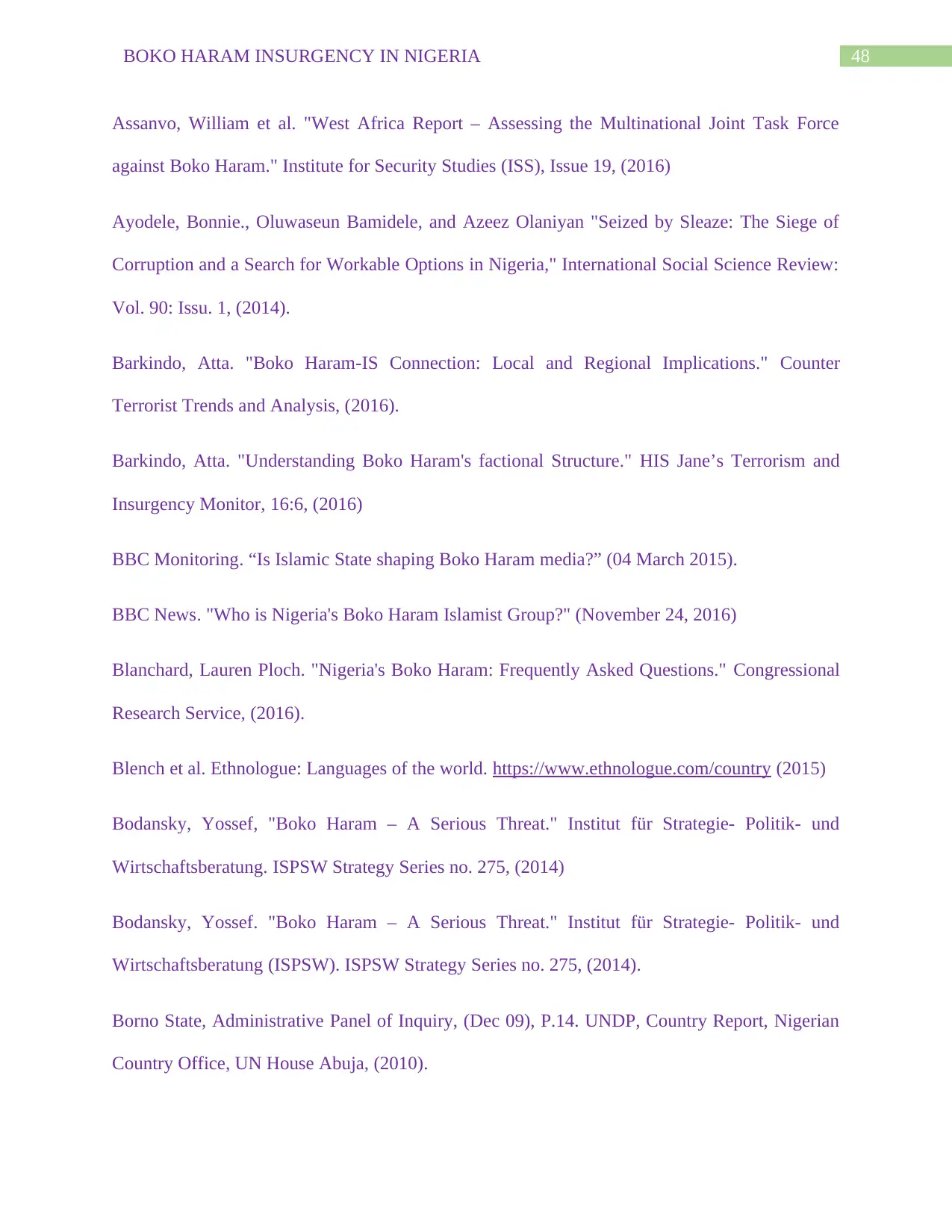
48BOKO HARAM INSURGENCY IN NIGERIA
Assanvo, William et al. "West Africa Report – Assessing the Multinational Joint Task Force
against Boko Haram." Institute for Security Studies (ISS), Issue 19, (2016)
Ayodele, Bonnie., Oluwaseun Bamidele, and Azeez Olaniyan "Seized by Sleaze: The Siege of
Corruption and a Search for Workable Options in Nigeria," International Social Science Review:
Vol. 90: Issu. 1, (2014).
Barkindo, Atta. "Boko Haram-IS Connection: Local and Regional Implications." Counter
Terrorist Trends and Analysis, (2016).
Barkindo, Atta. "Understanding Boko Haram's factional Structure." HIS Jane’s Terrorism and
Insurgency Monitor, 16:6, (2016)
BBC Monitoring. “Is Islamic State shaping Boko Haram media?” (04 March 2015).
BBC News. "Who is Nigeria's Boko Haram Islamist Group?" (November 24, 2016)
Blanchard, Lauren Ploch. "Nigeria's Boko Haram: Frequently Asked Questions." Congressional
Research Service, (2016).
Blench et al. Ethnologue: Languages of the world. https://www.ethnologue.com/country (2015)
Bodansky, Yossef, "Boko Haram – A Serious Threat." Institut für Strategie- Politik- und
Wirtschaftsberatung. ISPSW Strategy Series no. 275, (2014)
Bodansky, Yossef. "Boko Haram – A Serious Threat." Institut für Strategie- Politik- und
Wirtschaftsberatung (ISPSW). ISPSW Strategy Series no. 275, (2014).
Borno State, Administrative Panel of Inquiry, (Dec 09), P.14. UNDP, Country Report, Nigerian
Country Office, UN House Abuja, (2010).
Assanvo, William et al. "West Africa Report – Assessing the Multinational Joint Task Force
against Boko Haram." Institute for Security Studies (ISS), Issue 19, (2016)
Ayodele, Bonnie., Oluwaseun Bamidele, and Azeez Olaniyan "Seized by Sleaze: The Siege of
Corruption and a Search for Workable Options in Nigeria," International Social Science Review:
Vol. 90: Issu. 1, (2014).
Barkindo, Atta. "Boko Haram-IS Connection: Local and Regional Implications." Counter
Terrorist Trends and Analysis, (2016).
Barkindo, Atta. "Understanding Boko Haram's factional Structure." HIS Jane’s Terrorism and
Insurgency Monitor, 16:6, (2016)
BBC Monitoring. “Is Islamic State shaping Boko Haram media?” (04 March 2015).
BBC News. "Who is Nigeria's Boko Haram Islamist Group?" (November 24, 2016)
Blanchard, Lauren Ploch. "Nigeria's Boko Haram: Frequently Asked Questions." Congressional
Research Service, (2016).
Blench et al. Ethnologue: Languages of the world. https://www.ethnologue.com/country (2015)
Bodansky, Yossef, "Boko Haram – A Serious Threat." Institut für Strategie- Politik- und
Wirtschaftsberatung. ISPSW Strategy Series no. 275, (2014)
Bodansky, Yossef. "Boko Haram – A Serious Threat." Institut für Strategie- Politik- und
Wirtschaftsberatung (ISPSW). ISPSW Strategy Series no. 275, (2014).
Borno State, Administrative Panel of Inquiry, (Dec 09), P.14. UNDP, Country Report, Nigerian
Country Office, UN House Abuja, (2010).
Paraphrase This Document
Need a fresh take? Get an instant paraphrase of this document with our AI Paraphraser
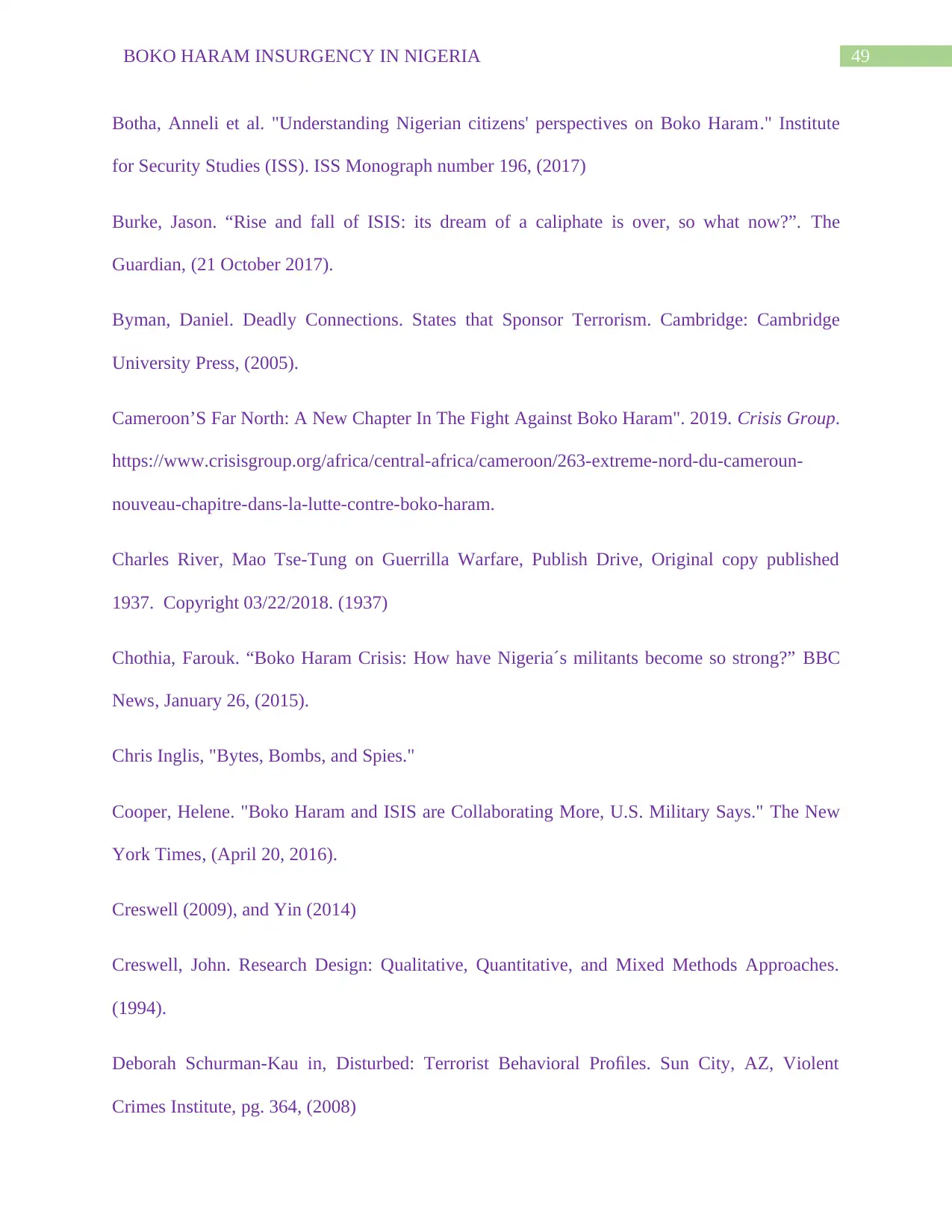
49BOKO HARAM INSURGENCY IN NIGERIA
Botha, Anneli et al. "Understanding Nigerian citizens' perspectives on Boko Haram." Institute
for Security Studies (ISS). ISS Monograph number 196, (2017)
Burke, Jason. “Rise and fall of ISIS: its dream of a caliphate is over, so what now?”. The
Guardian, (21 October 2017).
Byman, Daniel. Deadly Connections. States that Sponsor Terrorism. Cambridge: Cambridge
University Press, (2005).
Cameroon’S Far North: A New Chapter In The Fight Against Boko Haram". 2019. Crisis Group.
https://www.crisisgroup.org/africa/central-africa/cameroon/263-extreme-nord-du-cameroun-
nouveau-chapitre-dans-la-lutte-contre-boko-haram.
Charles River, Mao Tse-Tung on Guerrilla Warfare, Publish Drive, Original copy published
1937. Copyright 03/22/2018. (1937)
Chothia, Farouk. “Boko Haram Crisis: How have Nigeria´s militants become so strong?” BBC
News, January 26, (2015).
Chris Inglis, "Bytes, Bombs, and Spies."
Cooper, Helene. "Boko Haram and ISIS are Collaborating More, U.S. Military Says." The New
York Times, (April 20, 2016).
Creswell (2009), and Yin (2014)
Creswell, John. Research Design: Qualitative, Quantitative, and Mixed Methods Approaches.
(1994).
Deborah Schurman-Kau in, Disturbed: Terrorist Behavioral Profiles. Sun City, AZ, Violent
Crimes Institute, pg. 364, (2008)
Botha, Anneli et al. "Understanding Nigerian citizens' perspectives on Boko Haram." Institute
for Security Studies (ISS). ISS Monograph number 196, (2017)
Burke, Jason. “Rise and fall of ISIS: its dream of a caliphate is over, so what now?”. The
Guardian, (21 October 2017).
Byman, Daniel. Deadly Connections. States that Sponsor Terrorism. Cambridge: Cambridge
University Press, (2005).
Cameroon’S Far North: A New Chapter In The Fight Against Boko Haram". 2019. Crisis Group.
https://www.crisisgroup.org/africa/central-africa/cameroon/263-extreme-nord-du-cameroun-
nouveau-chapitre-dans-la-lutte-contre-boko-haram.
Charles River, Mao Tse-Tung on Guerrilla Warfare, Publish Drive, Original copy published
1937. Copyright 03/22/2018. (1937)
Chothia, Farouk. “Boko Haram Crisis: How have Nigeria´s militants become so strong?” BBC
News, January 26, (2015).
Chris Inglis, "Bytes, Bombs, and Spies."
Cooper, Helene. "Boko Haram and ISIS are Collaborating More, U.S. Military Says." The New
York Times, (April 20, 2016).
Creswell (2009), and Yin (2014)
Creswell, John. Research Design: Qualitative, Quantitative, and Mixed Methods Approaches.
(1994).
Deborah Schurman-Kau in, Disturbed: Terrorist Behavioral Profiles. Sun City, AZ, Violent
Crimes Institute, pg. 364, (2008)
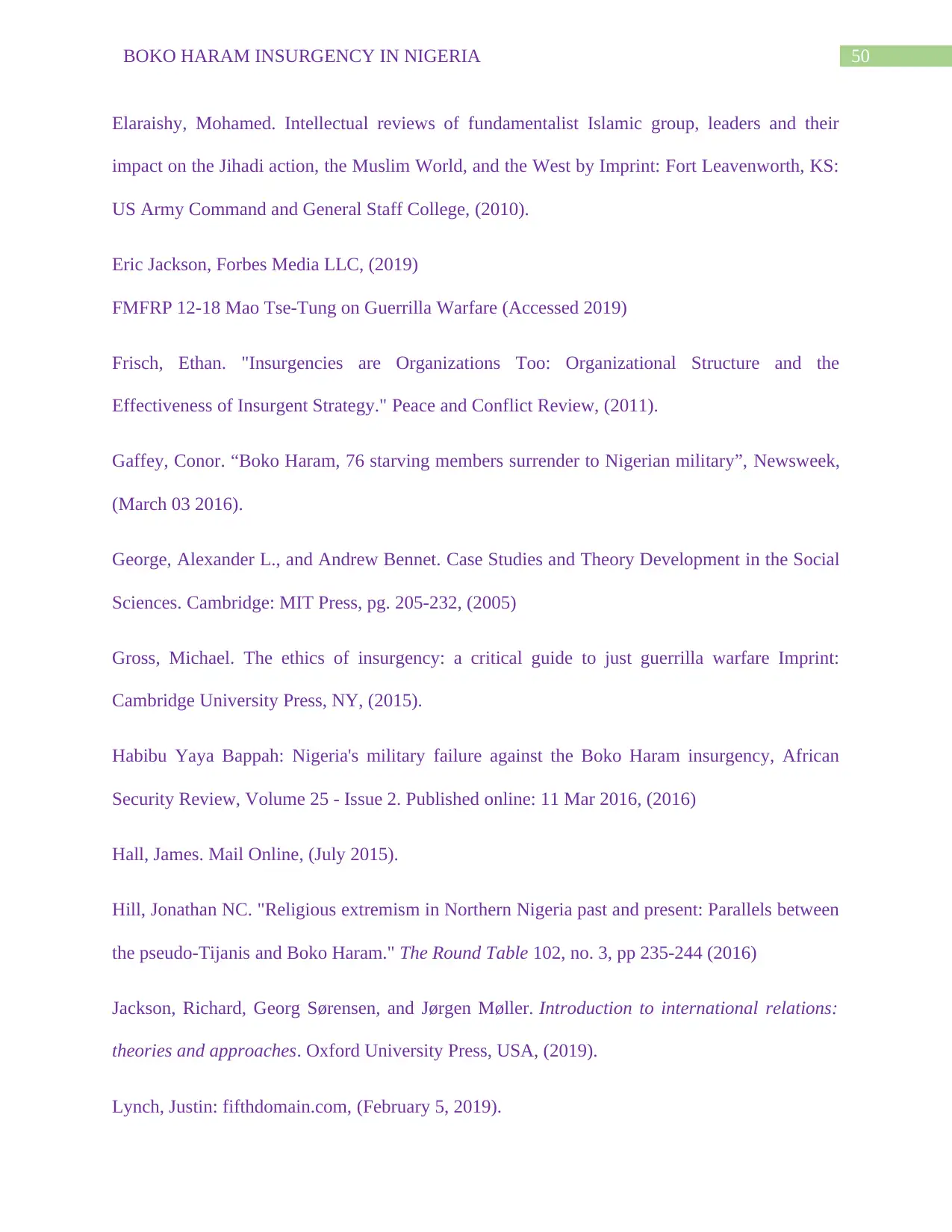
50BOKO HARAM INSURGENCY IN NIGERIA
Elaraishy, Mohamed. Intellectual reviews of fundamentalist Islamic group, leaders and their
impact on the Jihadi action, the Muslim World, and the West by Imprint: Fort Leavenworth, KS:
US Army Command and General Staff College, (2010).
Eric Jackson, Forbes Media LLC, (2019)
FMFRP 12-18 Mao Tse-Tung on Guerrilla Warfare (Accessed 2019)
Frisch, Ethan. "Insurgencies are Organizations Too: Organizational Structure and the
Effectiveness of Insurgent Strategy." Peace and Conflict Review, (2011).
Gaffey, Conor. “Boko Haram, 76 starving members surrender to Nigerian military”, Newsweek,
(March 03 2016).
George, Alexander L., and Andrew Bennet. Case Studies and Theory Development in the Social
Sciences. Cambridge: MIT Press, pg. 205-232, (2005)
Gross, Michael. The ethics of insurgency: a critical guide to just guerrilla warfare Imprint:
Cambridge University Press, NY, (2015).
Habibu Yaya Bappah: Nigeria's military failure against the Boko Haram insurgency, African
Security Review, Volume 25 - Issue 2. Published online: 11 Mar 2016, (2016)
Hall, James. Mail Online, (July 2015).
Hill, Jonathan NC. "Religious extremism in Northern Nigeria past and present: Parallels between
the pseudo-Tijanis and Boko Haram." The Round Table 102, no. 3, pp 235-244 (2016)
Jackson, Richard, Georg Sørensen, and Jørgen Møller. Introduction to international relations:
theories and approaches. Oxford University Press, USA, (2019).
Lynch, Justin: fifthdomain.com, (February 5, 2019).
Elaraishy, Mohamed. Intellectual reviews of fundamentalist Islamic group, leaders and their
impact on the Jihadi action, the Muslim World, and the West by Imprint: Fort Leavenworth, KS:
US Army Command and General Staff College, (2010).
Eric Jackson, Forbes Media LLC, (2019)
FMFRP 12-18 Mao Tse-Tung on Guerrilla Warfare (Accessed 2019)
Frisch, Ethan. "Insurgencies are Organizations Too: Organizational Structure and the
Effectiveness of Insurgent Strategy." Peace and Conflict Review, (2011).
Gaffey, Conor. “Boko Haram, 76 starving members surrender to Nigerian military”, Newsweek,
(March 03 2016).
George, Alexander L., and Andrew Bennet. Case Studies and Theory Development in the Social
Sciences. Cambridge: MIT Press, pg. 205-232, (2005)
Gross, Michael. The ethics of insurgency: a critical guide to just guerrilla warfare Imprint:
Cambridge University Press, NY, (2015).
Habibu Yaya Bappah: Nigeria's military failure against the Boko Haram insurgency, African
Security Review, Volume 25 - Issue 2. Published online: 11 Mar 2016, (2016)
Hall, James. Mail Online, (July 2015).
Hill, Jonathan NC. "Religious extremism in Northern Nigeria past and present: Parallels between
the pseudo-Tijanis and Boko Haram." The Round Table 102, no. 3, pp 235-244 (2016)
Jackson, Richard, Georg Sørensen, and Jørgen Møller. Introduction to international relations:
theories and approaches. Oxford University Press, USA, (2019).
Lynch, Justin: fifthdomain.com, (February 5, 2019).
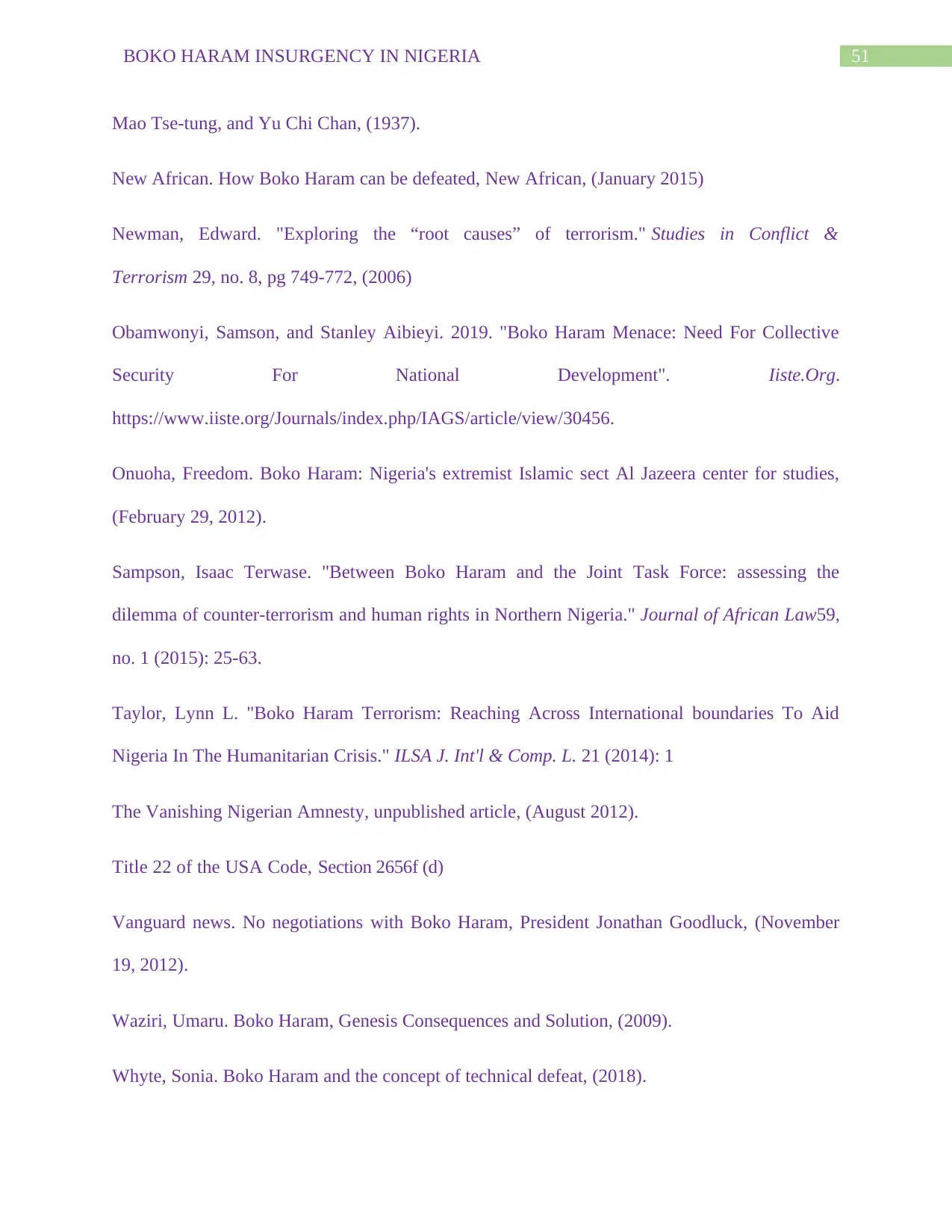
51BOKO HARAM INSURGENCY IN NIGERIA
Mao Tse-tung, and Yu Chi Chan, (1937).
New African. How Boko Haram can be defeated, New African, (January 2015)
Newman, Edward. "Exploring the “root causes” of terrorism." Studies in Conflict &
Terrorism 29, no. 8, pg 749-772, (2006)
Obamwonyi, Samson, and Stanley Aibieyi. 2019. "Boko Haram Menace: Need For Collective
Security For National Development". Iiste.Org.
https://www.iiste.org/Journals/index.php/IAGS/article/view/30456.
Onuoha, Freedom. Boko Haram: Nigeria's extremist Islamic sect Al Jazeera center for studies,
(February 29, 2012).
Sampson, Isaac Terwase. "Between Boko Haram and the Joint Task Force: assessing the
dilemma of counter-terrorism and human rights in Northern Nigeria." Journal of African Law59,
no. 1 (2015): 25-63.
Taylor, Lynn L. "Boko Haram Terrorism: Reaching Across International boundaries To Aid
Nigeria In The Humanitarian Crisis." ILSA J. Int'l & Comp. L. 21 (2014): 1
The Vanishing Nigerian Amnesty, unpublished article, (August 2012).
Title 22 of the USA Code, Section 2656f (d)
Vanguard news. No negotiations with Boko Haram, President Jonathan Goodluck, (November
19, 2012).
Waziri, Umaru. Boko Haram, Genesis Consequences and Solution, (2009).
Whyte, Sonia. Boko Haram and the concept of technical defeat, (2018).
Mao Tse-tung, and Yu Chi Chan, (1937).
New African. How Boko Haram can be defeated, New African, (January 2015)
Newman, Edward. "Exploring the “root causes” of terrorism." Studies in Conflict &
Terrorism 29, no. 8, pg 749-772, (2006)
Obamwonyi, Samson, and Stanley Aibieyi. 2019. "Boko Haram Menace: Need For Collective
Security For National Development". Iiste.Org.
https://www.iiste.org/Journals/index.php/IAGS/article/view/30456.
Onuoha, Freedom. Boko Haram: Nigeria's extremist Islamic sect Al Jazeera center for studies,
(February 29, 2012).
Sampson, Isaac Terwase. "Between Boko Haram and the Joint Task Force: assessing the
dilemma of counter-terrorism and human rights in Northern Nigeria." Journal of African Law59,
no. 1 (2015): 25-63.
Taylor, Lynn L. "Boko Haram Terrorism: Reaching Across International boundaries To Aid
Nigeria In The Humanitarian Crisis." ILSA J. Int'l & Comp. L. 21 (2014): 1
The Vanishing Nigerian Amnesty, unpublished article, (August 2012).
Title 22 of the USA Code, Section 2656f (d)
Vanguard news. No negotiations with Boko Haram, President Jonathan Goodluck, (November
19, 2012).
Waziri, Umaru. Boko Haram, Genesis Consequences and Solution, (2009).
Whyte, Sonia. Boko Haram and the concept of technical defeat, (2018).
Secure Best Marks with AI Grader
Need help grading? Try our AI Grader for instant feedback on your assignments.

52BOKO HARAM INSURGENCY IN NIGERIA
1 out of 53
Your All-in-One AI-Powered Toolkit for Academic Success.
+13062052269
info@desklib.com
Available 24*7 on WhatsApp / Email
![[object Object]](/_next/static/media/star-bottom.7253800d.svg)
Unlock your academic potential
© 2024 | Zucol Services PVT LTD | All rights reserved.



